Dataset Viewer
problem
stringlengths 5
10.4k
| solution
stringlengths 1
24.1k
| answer
stringlengths 1
250
⌀ | problem_is_valid
stringclasses 4
values | solution_is_valid
stringclasses 4
values | question_type
stringclasses 4
values | problem_type
stringclasses 8
values | problem_raw
stringlengths 5
10.4k
| solution_raw
stringlengths 1
24.1k
| metadata
dict | uuid
stringlengths 36
36
| id
int64 10k
612k
|
|---|---|---|---|---|---|---|---|---|---|---|---|
Let $x_{1}, x_{2}, \ldots, x_{n}$ be positive real numbers, and let
$$
S=x_{1}+x_{2}+\cdots+x_{n}
$$
Prove that
$$
\left(1+x_{1}\right)\left(1+x_{2}\right) \cdots\left(1+x_{n}\right) \leq 1+S+\frac{S^{2}}{2!}+\frac{S^{3}}{3!}+\cdots+\frac{S^{n}}{n!}
$$
|
Let $\sigma_{k}$ be the $k$ th symmetric polynomial, namely
$$
\sigma_{k}=\sum_{\substack{|S|=k \\ S \subseteq\{1,2, \ldots, n\}}} \prod_{i \in S} x_{i},
$$
and more explicitly
$$
\sigma_{1}=S, \quad \sigma_{2}=x_{1} x_{2}+x_{1} x_{3}+\cdots+x_{n-1} x_{n}, \quad \text { and so on. }
$$
Then
$$
\left(1+x_{1}\right)\left(1+x_{2}\right) \cdots\left(1+x_{n}\right)=1+\sigma_{1}+\sigma_{2}+\cdots+\sigma_{n}
$$
The expansion of
$$
S^{k}=\left(x_{1}+x_{2}+\cdots+x_{n}\right)^{k}=\underbrace{\left(x_{1}+x_{2}+\cdots+x_{n}\right)\left(x_{1}+x_{2}+\cdots+x_{n}\right) \cdots\left(x_{1}+x_{2}+\cdots+x_{n}\right)}_{k \text { times }}
$$
has at least $k$ ! occurrences of $\prod_{i \in S} x_{i}$ for each subset $S$ with $k$ indices from $\{1,2, \ldots, n\}$. In fact, if $\pi$ is a permutation of $S$, we can choose each $x_{\pi(i)}$ from the $i$ th factor of $\left(x_{1}+x_{2}+\cdots+x_{n}\right)^{k}$. Then each term appears at least $k$ ! times, and
$$
S^{k} \geq k!\sigma_{k} \Longleftrightarrow \sigma_{k} \leq \frac{S^{k}}{k!}
$$
Summing the obtained inequalities for $k=1,2, \ldots, n$ yields the result.
|
proof
|
Yes
|
Yes
|
proof
|
Inequalities
|
Let $x_{1}, x_{2}, \ldots, x_{n}$ be positive real numbers, and let
$$
S=x_{1}+x_{2}+\cdots+x_{n}
$$
Prove that
$$
\left(1+x_{1}\right)\left(1+x_{2}\right) \cdots\left(1+x_{n}\right) \leq 1+S+\frac{S^{2}}{2!}+\frac{S^{3}}{3!}+\cdots+\frac{S^{n}}{n!}
$$
|
Let $\sigma_{k}$ be the $k$ th symmetric polynomial, namely
$$
\sigma_{k}=\sum_{\substack{|S|=k \\ S \subseteq\{1,2, \ldots, n\}}} \prod_{i \in S} x_{i},
$$
and more explicitly
$$
\sigma_{1}=S, \quad \sigma_{2}=x_{1} x_{2}+x_{1} x_{3}+\cdots+x_{n-1} x_{n}, \quad \text { and so on. }
$$
Then
$$
\left(1+x_{1}\right)\left(1+x_{2}\right) \cdots\left(1+x_{n}\right)=1+\sigma_{1}+\sigma_{2}+\cdots+\sigma_{n}
$$
The expansion of
$$
S^{k}=\left(x_{1}+x_{2}+\cdots+x_{n}\right)^{k}=\underbrace{\left(x_{1}+x_{2}+\cdots+x_{n}\right)\left(x_{1}+x_{2}+\cdots+x_{n}\right) \cdots\left(x_{1}+x_{2}+\cdots+x_{n}\right)}_{k \text { times }}
$$
has at least $k$ ! occurrences of $\prod_{i \in S} x_{i}$ for each subset $S$ with $k$ indices from $\{1,2, \ldots, n\}$. In fact, if $\pi$ is a permutation of $S$, we can choose each $x_{\pi(i)}$ from the $i$ th factor of $\left(x_{1}+x_{2}+\cdots+x_{n}\right)^{k}$. Then each term appears at least $k$ ! times, and
$$
S^{k} \geq k!\sigma_{k} \Longleftrightarrow \sigma_{k} \leq \frac{S^{k}}{k!}
$$
Summing the obtained inequalities for $k=1,2, \ldots, n$ yields the result.
|
{
"resource_path": "APMO/segmented/en-apmo1989_sol.jsonl",
"problem_match": "# Problem 1",
"solution_match": "# Solution 1"
}
|
b68eb2f6-098f-5fca-a42e-60c8dd41aef2
| 604,152 |
Let $x_{1}, x_{2}, \ldots, x_{n}$ be positive real numbers, and let
$$
S=x_{1}+x_{2}+\cdots+x_{n}
$$
Prove that
$$
\left(1+x_{1}\right)\left(1+x_{2}\right) \cdots\left(1+x_{n}\right) \leq 1+S+\frac{S^{2}}{2!}+\frac{S^{3}}{3!}+\cdots+\frac{S^{n}}{n!}
$$
|
By AM-GM,
$$
\left(1+x_{1}\right)\left(1+x_{2}\right) \cdots\left(1+x_{n}\right) \leq\left(\frac{\left(1+x_{1}\right)+\left(1+x_{2}\right)+\cdots+\left(1+x_{n}\right)}{n}\right)^{n}=\left(1+\frac{S}{n}\right)^{n}
$$
By the binomial theorem,
$$
\left(1+\frac{S}{n}\right)^{n}=\sum_{k=0}^{n}\binom{n}{k}\left(\frac{S}{n}\right)^{k}=\sum_{k=0}^{n} \frac{1}{k!} \frac{n(n-1) \ldots(n-k+1)}{n^{k}} S^{k} \leq \sum_{k=0}^{n} \frac{S^{k}}{k!}
$$
and the result follows.
Comment: Maclaurin's inequality states that
$$
\frac{\sigma_{1}}{n} \geq \sqrt{\frac{\sigma_{2}}{\binom{n}{2}}} \geq \cdots \geq \sqrt[k]{\frac{\sigma_{k}}{\binom{n}{k}}} \geq \cdots \geq \sqrt[n]{\frac{\sigma_{n}}{\binom{n}{n}}}
$$
Then $\sigma_{k} \leq\binom{ n}{k} \frac{S^{k}}{n^{k}}=\frac{1}{k!} \frac{n(n-1) \ldots(n-k+1)}{n^{k}} S^{k} \leq \frac{S^{k}}{k!}$.
|
proof
|
Yes
|
Yes
|
proof
|
Inequalities
|
Let $x_{1}, x_{2}, \ldots, x_{n}$ be positive real numbers, and let
$$
S=x_{1}+x_{2}+\cdots+x_{n}
$$
Prove that
$$
\left(1+x_{1}\right)\left(1+x_{2}\right) \cdots\left(1+x_{n}\right) \leq 1+S+\frac{S^{2}}{2!}+\frac{S^{3}}{3!}+\cdots+\frac{S^{n}}{n!}
$$
|
By AM-GM,
$$
\left(1+x_{1}\right)\left(1+x_{2}\right) \cdots\left(1+x_{n}\right) \leq\left(\frac{\left(1+x_{1}\right)+\left(1+x_{2}\right)+\cdots+\left(1+x_{n}\right)}{n}\right)^{n}=\left(1+\frac{S}{n}\right)^{n}
$$
By the binomial theorem,
$$
\left(1+\frac{S}{n}\right)^{n}=\sum_{k=0}^{n}\binom{n}{k}\left(\frac{S}{n}\right)^{k}=\sum_{k=0}^{n} \frac{1}{k!} \frac{n(n-1) \ldots(n-k+1)}{n^{k}} S^{k} \leq \sum_{k=0}^{n} \frac{S^{k}}{k!}
$$
and the result follows.
Comment: Maclaurin's inequality states that
$$
\frac{\sigma_{1}}{n} \geq \sqrt{\frac{\sigma_{2}}{\binom{n}{2}}} \geq \cdots \geq \sqrt[k]{\frac{\sigma_{k}}{\binom{n}{k}}} \geq \cdots \geq \sqrt[n]{\frac{\sigma_{n}}{\binom{n}{n}}}
$$
Then $\sigma_{k} \leq\binom{ n}{k} \frac{S^{k}}{n^{k}}=\frac{1}{k!} \frac{n(n-1) \ldots(n-k+1)}{n^{k}} S^{k} \leq \frac{S^{k}}{k!}$.
|
{
"resource_path": "APMO/segmented/en-apmo1989_sol.jsonl",
"problem_match": "# Problem 1",
"solution_match": "# Solution 2"
}
|
b68eb2f6-098f-5fca-a42e-60c8dd41aef2
| 604,152 |
Prove that the equation
$$
6\left(6 a^{2}+3 b^{2}+c^{2}\right)=5 n^{2}
$$
has no solutions in integers except $a=b=c=n=0$.
|
We can suppose without loss of generality that $a, b, c, n \geq 0$. Let $(a, b, c, n)$ be a solution with minimum sum $a+b+c+n$. Suppose, for the sake of contradiction, that $a+b+c+n>0$. Since 6 divides $5 n^{2}, n$ is a multiple of 6 . Let $n=6 n_{0}$. Then the equation reduces to
$$
6 a^{2}+3 b^{2}+c^{2}=30 n_{0}^{2}
$$
The number $c$ is a multiple of 3 , so let $c=3 c_{0}$. The equation now reduces to
$$
2 a^{2}+b^{2}+3 c_{0}^{2}=10 n_{0}^{2}
$$
Now look at the equation modulo 8:
$$
b^{2}+3 c_{0}^{2} \equiv 2\left(n_{0}^{2}-a^{2}\right) \quad(\bmod 8)
$$
Integers $b$ and $c_{0}$ have the same parity. Either way, since $x^{2}$ is congruent to 0 or 1 modulo 4 , $b^{2}+3 c_{0}^{2}$ is a multiple of 4 , so $n_{0}^{2}-a^{2}=\left(n_{0}-a\right)\left(n_{0}+a\right)$ is even, and therefore also a multiple of 4 , since $n_{0}-a$ and $n_{0}+a$ have the same parity. Hence $2\left(n_{0}^{2}-a^{2}\right)$ is a multiple of 8 , and
$$
b^{2}+3 c_{0}^{2} \equiv 0 \quad(\bmod 8)
$$
If $b$ and $c_{0}$ are both odd, $b^{2}+3 c_{0}^{2} \equiv 4(\bmod 8)$, which is impossible. Then $b$ and $c_{0}$ are both even. Let $b=2 b_{0}$ and $c_{0}=2 c_{1}$, and we find
$$
a^{2}+2 b_{0}^{2}+6 c_{1}^{2}=5 n_{0}^{2}
$$
Look at the last equation modulo 8:
$$
a^{2}+3 n_{0}^{2} \equiv 2\left(c_{1}^{2}-b_{0}^{2}\right) \quad(\bmod 8)
$$
A similar argument shows that $a$ and $n_{0}$ are both even.
We have proven that $a, b, c, n$ are all even. Then, dividing the original equation by 4 we find
$$
6\left(6(a / 2)^{2}+3(b / 2)^{2}+(c / 2)^{2}\right)=5(n / 2)^{2}
$$
and we find that $(a / 2, b / 2, c / 2, n / 2)$ is a new solution with smaller sum. This is a contradiction, and the only solution is $(a, b, c, n)=(0,0,0,0)$.
|
proof
|
Yes
|
Yes
|
proof
|
Number Theory
|
Prove that the equation
$$
6\left(6 a^{2}+3 b^{2}+c^{2}\right)=5 n^{2}
$$
has no solutions in integers except $a=b=c=n=0$.
|
We can suppose without loss of generality that $a, b, c, n \geq 0$. Let $(a, b, c, n)$ be a solution with minimum sum $a+b+c+n$. Suppose, for the sake of contradiction, that $a+b+c+n>0$. Since 6 divides $5 n^{2}, n$ is a multiple of 6 . Let $n=6 n_{0}$. Then the equation reduces to
$$
6 a^{2}+3 b^{2}+c^{2}=30 n_{0}^{2}
$$
The number $c$ is a multiple of 3 , so let $c=3 c_{0}$. The equation now reduces to
$$
2 a^{2}+b^{2}+3 c_{0}^{2}=10 n_{0}^{2}
$$
Now look at the equation modulo 8:
$$
b^{2}+3 c_{0}^{2} \equiv 2\left(n_{0}^{2}-a^{2}\right) \quad(\bmod 8)
$$
Integers $b$ and $c_{0}$ have the same parity. Either way, since $x^{2}$ is congruent to 0 or 1 modulo 4 , $b^{2}+3 c_{0}^{2}$ is a multiple of 4 , so $n_{0}^{2}-a^{2}=\left(n_{0}-a\right)\left(n_{0}+a\right)$ is even, and therefore also a multiple of 4 , since $n_{0}-a$ and $n_{0}+a$ have the same parity. Hence $2\left(n_{0}^{2}-a^{2}\right)$ is a multiple of 8 , and
$$
b^{2}+3 c_{0}^{2} \equiv 0 \quad(\bmod 8)
$$
If $b$ and $c_{0}$ are both odd, $b^{2}+3 c_{0}^{2} \equiv 4(\bmod 8)$, which is impossible. Then $b$ and $c_{0}$ are both even. Let $b=2 b_{0}$ and $c_{0}=2 c_{1}$, and we find
$$
a^{2}+2 b_{0}^{2}+6 c_{1}^{2}=5 n_{0}^{2}
$$
Look at the last equation modulo 8:
$$
a^{2}+3 n_{0}^{2} \equiv 2\left(c_{1}^{2}-b_{0}^{2}\right) \quad(\bmod 8)
$$
A similar argument shows that $a$ and $n_{0}$ are both even.
We have proven that $a, b, c, n$ are all even. Then, dividing the original equation by 4 we find
$$
6\left(6(a / 2)^{2}+3(b / 2)^{2}+(c / 2)^{2}\right)=5(n / 2)^{2}
$$
and we find that $(a / 2, b / 2, c / 2, n / 2)$ is a new solution with smaller sum. This is a contradiction, and the only solution is $(a, b, c, n)=(0,0,0,0)$.
|
{
"resource_path": "APMO/segmented/en-apmo1989_sol.jsonl",
"problem_match": "# Problem 2",
"solution_match": "# Solution\n\n"
}
|
f926320b-a7a4-5a7e-adab-23b4749bfd74
| 604,164 |
Let $A_{1}, A_{2}, A_{3}$ be three points in the plane, and for convenience,let $A_{4}=A_{1}, A_{5}=A_{2}$. For $n=1,2$, and 3 , suppose that $B_{n}$ is the midpoint of $A_{n} A_{n+1}$, and suppose that $C_{n}$ is the midpoint of $A_{n} B_{n}$. Suppose that $A_{n} C_{n+1}$ and $B_{n} A_{n+2}$ meet at $D_{n}$, and that $A_{n} B_{n+1}$ and $C_{n} A_{n+2}$ meet at $E_{n}$. Calculate the ratio of the area of triangle $D_{1} D_{2} D_{3}$ to the area of triangle $E_{1} E_{2} E_{3}$.
Answer: $\frac{25}{49}$.
|
Let $G$ be the centroid of triangle $A B C$, and also the intersection point of $A_{1} B_{2}, A_{2} B_{3}$, and $A_{3} B_{1}$ 。
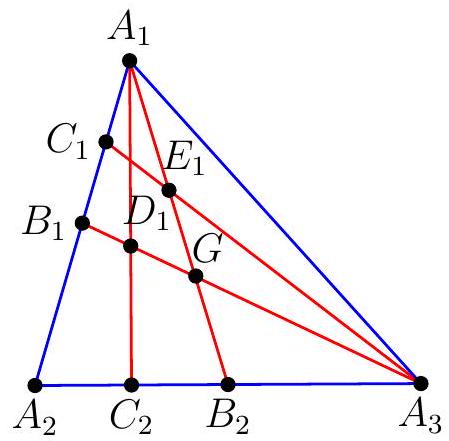
By Menelao's theorem on triangle $B_{1} A_{2} A_{3}$ and line $A_{1} D_{1} C_{2}$,
$$
\frac{A_{1} B_{1}}{A_{1} A_{2}} \cdot \frac{D_{1} A_{3}}{D_{1} B_{1}} \cdot \frac{C_{2} A_{2}}{C_{2} A_{3}}=1 \Longleftrightarrow \frac{D_{1} A_{3}}{D_{1} B_{1}}=2 \cdot 3=6 \Longleftrightarrow \frac{D_{1} B_{1}}{A_{3} B_{1}}=\frac{1}{7}
$$
Since $A_{3} G=\frac{2}{3} A_{3} B_{1}$, if $A_{3} B_{1}=21 t$ then $G A_{3}=14 t, D_{1} B_{1}=\frac{21 t}{7}=3 t, A_{3} D_{1}=18 t$, and $G D_{1}=A_{3} D_{1}-A_{3} G=18 t-14 t=4 t$, and
$$
\frac{G D_{1}}{G A_{3}}=\frac{4}{14}=\frac{2}{7}
$$
Similar results hold for the other medians, therefore $D_{1} D_{2} D_{3}$ and $A_{1} A_{2} A_{3}$ are homothetic with center $G$ and ratio $-\frac{2}{7}$.
By Menelao's theorem on triangle $A_{1} A_{2} B_{2}$ and line $C_{1} E_{1} A_{3}$,
$$
\frac{C_{1} A_{1}}{C_{1} A_{2}} \cdot \frac{E_{1} B_{2}}{E_{1} A_{1}} \cdot \frac{A_{3} A_{2}}{A_{3} B_{2}}=1 \Longleftrightarrow \frac{E_{1} B_{2}}{E_{1} A_{1}}=3 \cdot \frac{1}{2}=\frac{3}{2} \Longleftrightarrow \frac{A_{1} E_{1}}{A_{1} B_{2}}=\frac{2}{5}
$$
If $A_{1} B_{2}=15 u$, then $A_{1} G=\frac{2}{3} \cdot 15 u=10 u$ and $G E_{1}=A_{1} G-A_{1} E_{1}=10 u-\frac{2}{5} \cdot 15 u=4 u$, and
$$
\frac{G E_{1}}{G A_{1}}=\frac{4}{10}=\frac{2}{5}
$$
Similar results hold for the other medians, therefore $E_{1} E_{2} E_{3}$ and $A_{1} A_{2} A_{3}$ are homothetic with center $G$ and ratio $\frac{2}{5}$.
Then $D_{1} D_{2} D_{3}$ and $E_{1} E_{2} E_{3}$ are homothetic with center $G$ and ratio $-\frac{2}{7}: \frac{2}{5}=-\frac{5}{7}$, and the ratio of their area is $\left(\frac{5}{7}\right)^{2}=\frac{25}{49}$.
|
\frac{25}{49}
|
Yes
|
Yes
|
math-word-problem
|
Geometry
|
Let $A_{1}, A_{2}, A_{3}$ be three points in the plane, and for convenience,let $A_{4}=A_{1}, A_{5}=A_{2}$. For $n=1,2$, and 3 , suppose that $B_{n}$ is the midpoint of $A_{n} A_{n+1}$, and suppose that $C_{n}$ is the midpoint of $A_{n} B_{n}$. Suppose that $A_{n} C_{n+1}$ and $B_{n} A_{n+2}$ meet at $D_{n}$, and that $A_{n} B_{n+1}$ and $C_{n} A_{n+2}$ meet at $E_{n}$. Calculate the ratio of the area of triangle $D_{1} D_{2} D_{3}$ to the area of triangle $E_{1} E_{2} E_{3}$.
Answer: $\frac{25}{49}$.
|
Let $G$ be the centroid of triangle $A B C$, and also the intersection point of $A_{1} B_{2}, A_{2} B_{3}$, and $A_{3} B_{1}$ 。

By Menelao's theorem on triangle $B_{1} A_{2} A_{3}$ and line $A_{1} D_{1} C_{2}$,
$$
\frac{A_{1} B_{1}}{A_{1} A_{2}} \cdot \frac{D_{1} A_{3}}{D_{1} B_{1}} \cdot \frac{C_{2} A_{2}}{C_{2} A_{3}}=1 \Longleftrightarrow \frac{D_{1} A_{3}}{D_{1} B_{1}}=2 \cdot 3=6 \Longleftrightarrow \frac{D_{1} B_{1}}{A_{3} B_{1}}=\frac{1}{7}
$$
Since $A_{3} G=\frac{2}{3} A_{3} B_{1}$, if $A_{3} B_{1}=21 t$ then $G A_{3}=14 t, D_{1} B_{1}=\frac{21 t}{7}=3 t, A_{3} D_{1}=18 t$, and $G D_{1}=A_{3} D_{1}-A_{3} G=18 t-14 t=4 t$, and
$$
\frac{G D_{1}}{G A_{3}}=\frac{4}{14}=\frac{2}{7}
$$
Similar results hold for the other medians, therefore $D_{1} D_{2} D_{3}$ and $A_{1} A_{2} A_{3}$ are homothetic with center $G$ and ratio $-\frac{2}{7}$.
By Menelao's theorem on triangle $A_{1} A_{2} B_{2}$ and line $C_{1} E_{1} A_{3}$,
$$
\frac{C_{1} A_{1}}{C_{1} A_{2}} \cdot \frac{E_{1} B_{2}}{E_{1} A_{1}} \cdot \frac{A_{3} A_{2}}{A_{3} B_{2}}=1 \Longleftrightarrow \frac{E_{1} B_{2}}{E_{1} A_{1}}=3 \cdot \frac{1}{2}=\frac{3}{2} \Longleftrightarrow \frac{A_{1} E_{1}}{A_{1} B_{2}}=\frac{2}{5}
$$
If $A_{1} B_{2}=15 u$, then $A_{1} G=\frac{2}{3} \cdot 15 u=10 u$ and $G E_{1}=A_{1} G-A_{1} E_{1}=10 u-\frac{2}{5} \cdot 15 u=4 u$, and
$$
\frac{G E_{1}}{G A_{1}}=\frac{4}{10}=\frac{2}{5}
$$
Similar results hold for the other medians, therefore $E_{1} E_{2} E_{3}$ and $A_{1} A_{2} A_{3}$ are homothetic with center $G$ and ratio $\frac{2}{5}$.
Then $D_{1} D_{2} D_{3}$ and $E_{1} E_{2} E_{3}$ are homothetic with center $G$ and ratio $-\frac{2}{7}: \frac{2}{5}=-\frac{5}{7}$, and the ratio of their area is $\left(\frac{5}{7}\right)^{2}=\frac{25}{49}$.
|
{
"resource_path": "APMO/segmented/en-apmo1989_sol.jsonl",
"problem_match": "# Problem 3",
"solution_match": "\nSolution\n"
}
|
83c5357e-cc64-51e7-8925-9bd682bff7b7
| 604,178 |
Let $S$ be a set consisting of $m$ pairs $(a, b)$ of positive integers with the property that $1 \leq a<$ $b \leq n$. Show that there are at least
$$
4 m \frac{\left(m-\frac{n^{2}}{4}\right)}{3 n}
$$
triples $(a, b, c)$ such that $(a, b),(a, c)$, and $(b, c)$ belong to $S$.
|
Call a triple $(a, b, c)$ good if and only if $(a, b),(a, c)$, and $(b, c)$ all belong to $S$. For $i$ in $\{1,2, \ldots, n\}$, let $d_{i}$ be the number of pairs in $S$ that contain $i$, and let $D_{i}$ be the set of numbers paired with $i$ in $S$ (so $\left|D_{i}\right|=d_{i}$ ). Consider a pair $(i, j) \in S$. Our goal is to estimate the number of integers $k$ such that any permutation of $\{i, j, k\}$ is good, that is, $\left|D_{i} \cap D_{j}\right|$. Note that $i \notin D_{i}$ and $j \notin D_{j}$, so $i, j \notin D_{i} \cap D_{j}$; thus any $k \in D_{i} \cap D_{j}$ is different from both $i$ and $j$, and $\{i, j, k\}$ has three elements as required. Now, since $D_{i} \cup D_{j} \subseteq\{1,2, \ldots, n\}$,
$$
\left|D_{i} \cap D_{j}\right|=\left|D_{i}\right|+\left|D_{j}\right|-\left|D_{i} \cup D_{j}\right| \leq d_{i}+d_{j}-n
$$
Summing all the results, and having in mind that each good triple is counted three times (one for each two of the three numbers), the number of good triples $T$ is at least
$$
T \geq \frac{1}{3} \sum_{(i, j) \in S}\left(d_{i}+d_{j}-n\right)
$$
Each term $d_{i}$ appears each time $i$ is in a pair from $S$, that is, $d_{i}$ times; there are $m$ pairs in $S$, so $n$ is subtracted $m$ times. By the Cauchy-Schwartz inequality
$$
T \geq \frac{1}{3}\left(\sum_{i=1}^{n} d_{i}^{2}-m n\right) \geq \frac{1}{3}\left(\frac{\left(\sum_{i=1}^{n} d_{i}\right)^{2}}{n}-m n\right) .
$$
Finally, the sum $\sum_{i=1}^{n} d_{i}$ is $2 m$, since $d_{i}$ counts the number of pairs containing $i$, and each pair $(i, j)$ is counted twice: once in $d_{i}$ and once in $d_{j}$. Therefore
$$
T \geq \frac{1}{3}\left(\frac{(2 m)^{2}}{n}-m n\right)=4 m \frac{\left(m-\frac{n^{2}}{4}\right)}{3 n} .
$$
Comment: This is a celebrated graph theory fact named Goodman's bound, after A. M. Goodman's method published in 1959. The generalized version of the problem is still studied to this day.
|
4 m \frac{\left(m-\frac{n^{2}}{4}\right)}{3 n}
|
Yes
|
Yes
|
proof
|
Combinatorics
|
Let $S$ be a set consisting of $m$ pairs $(a, b)$ of positive integers with the property that $1 \leq a<$ $b \leq n$. Show that there are at least
$$
4 m \frac{\left(m-\frac{n^{2}}{4}\right)}{3 n}
$$
triples $(a, b, c)$ such that $(a, b),(a, c)$, and $(b, c)$ belong to $S$.
|
Call a triple $(a, b, c)$ good if and only if $(a, b),(a, c)$, and $(b, c)$ all belong to $S$. For $i$ in $\{1,2, \ldots, n\}$, let $d_{i}$ be the number of pairs in $S$ that contain $i$, and let $D_{i}$ be the set of numbers paired with $i$ in $S$ (so $\left|D_{i}\right|=d_{i}$ ). Consider a pair $(i, j) \in S$. Our goal is to estimate the number of integers $k$ such that any permutation of $\{i, j, k\}$ is good, that is, $\left|D_{i} \cap D_{j}\right|$. Note that $i \notin D_{i}$ and $j \notin D_{j}$, so $i, j \notin D_{i} \cap D_{j}$; thus any $k \in D_{i} \cap D_{j}$ is different from both $i$ and $j$, and $\{i, j, k\}$ has three elements as required. Now, since $D_{i} \cup D_{j} \subseteq\{1,2, \ldots, n\}$,
$$
\left|D_{i} \cap D_{j}\right|=\left|D_{i}\right|+\left|D_{j}\right|-\left|D_{i} \cup D_{j}\right| \leq d_{i}+d_{j}-n
$$
Summing all the results, and having in mind that each good triple is counted three times (one for each two of the three numbers), the number of good triples $T$ is at least
$$
T \geq \frac{1}{3} \sum_{(i, j) \in S}\left(d_{i}+d_{j}-n\right)
$$
Each term $d_{i}$ appears each time $i$ is in a pair from $S$, that is, $d_{i}$ times; there are $m$ pairs in $S$, so $n$ is subtracted $m$ times. By the Cauchy-Schwartz inequality
$$
T \geq \frac{1}{3}\left(\sum_{i=1}^{n} d_{i}^{2}-m n\right) \geq \frac{1}{3}\left(\frac{\left(\sum_{i=1}^{n} d_{i}\right)^{2}}{n}-m n\right) .
$$
Finally, the sum $\sum_{i=1}^{n} d_{i}$ is $2 m$, since $d_{i}$ counts the number of pairs containing $i$, and each pair $(i, j)$ is counted twice: once in $d_{i}$ and once in $d_{j}$. Therefore
$$
T \geq \frac{1}{3}\left(\frac{(2 m)^{2}}{n}-m n\right)=4 m \frac{\left(m-\frac{n^{2}}{4}\right)}{3 n} .
$$
Comment: This is a celebrated graph theory fact named Goodman's bound, after A. M. Goodman's method published in 1959. The generalized version of the problem is still studied to this day.
|
{
"resource_path": "APMO/segmented/en-apmo1989_sol.jsonl",
"problem_match": "# Problem 4",
"solution_match": "# Solution\n\n"
}
|
d69db721-1dc2-54fb-a7ff-782194933133
| 604,193 |
Determine all functions $f$ from the reals to the reals for which
(1) $f(x)$ is strictly increasing,
(2) $f(x)+g(x)=2 x$ for all real $x$, where $g(x)$ is the composition inverse function to $f(x)$.
(Note: $f$ and $g$ are said to be composition inverses if $f(g(x))=x$ and $g(f(x))=x$ for all real x.)
Answer: $f(x)=x+c, c \in \mathbb{R}$ constant.
|
Denote by $f_{n}$ the $n$th iterate of $f$, that is, $f_{n}(x)=\underbrace{f(f(\ldots f}_{n \text { times }}(x)))$.
Plug $x \rightarrow f_{n+1}(x)$ in (2): since $g\left(f_{n+1}(x)\right)=g\left(f\left(f_{n}(x)\right)\right)=f_{n}(x)$,
$$
f_{n+2}(x)+f_{n}(x)=2 f_{n+1}(x)
$$
that is,
$$
f_{n+2}(x)-f_{n+1}(x)=f_{n+1}(x)-f_{n}(x)
$$
Therefore $f_{n}(x)-f_{n-1}(x)$ does not depend on $n$, and is equal to $f(x)-x$. Summing the corresponding results for smaller values of $n$ we find
$$
f_{n}(x)-x=n(f(x)-x) .
$$
Since $g$ has the same properties as $f$,
$$
g_{n}(x)-x=n(g(x)-x)=-n(f(x)-x) .
$$
Finally, $g$ is also increasing, because since $f$ is increasing $g(x)>g(y) \Longrightarrow f(g(x))>$ $f(g(y)) \Longrightarrow x>y$. An induction proves that $f_{n}$ and $g_{n}$ are also increasing functions.
Let $x>y$ be real numbers. Since $f_{n}$ and $g_{n}$ are increasing,
$$
x+n(f(x)-x)>y+n(f(y)-y) \Longleftrightarrow n[(f(x)-x)-(f(y)-y)]>y-x
$$
and
$$
x-n(f(x)-x)>y-n(f(y)-y) \Longleftrightarrow n[(f(x)-x)-(f(y)-y)]<x-y
$$
Summing it up,
$$
|n[(f(x)-x)-(f(y)-y)]|<x-y \quad \text { for all } n \in \mathbb{Z}_{>0}
$$
Suppose that $a=f(x)-x$ and $b=f(y)-y$ are distinct. Then, for all positive integers $n$,
$$
|n(a-b)|<x-y
$$
which is false for a sufficiently large $n$. Hence $a=b$, and $f(x)-x$ is a constant $c$ for all $x \in \mathbb{R}$, that is, $f(x)=x+c$.
It is immediate that $f(x)=x+c$ satisfies the problem, as $g(x)=x-c$.
|
f(x)=x+c
|
Yes
|
Yes
|
math-word-problem
|
Algebra
|
Determine all functions $f$ from the reals to the reals for which
(1) $f(x)$ is strictly increasing,
(2) $f(x)+g(x)=2 x$ for all real $x$, where $g(x)$ is the composition inverse function to $f(x)$.
(Note: $f$ and $g$ are said to be composition inverses if $f(g(x))=x$ and $g(f(x))=x$ for all real x.)
Answer: $f(x)=x+c, c \in \mathbb{R}$ constant.
|
Denote by $f_{n}$ the $n$th iterate of $f$, that is, $f_{n}(x)=\underbrace{f(f(\ldots f}_{n \text { times }}(x)))$.
Plug $x \rightarrow f_{n+1}(x)$ in (2): since $g\left(f_{n+1}(x)\right)=g\left(f\left(f_{n}(x)\right)\right)=f_{n}(x)$,
$$
f_{n+2}(x)+f_{n}(x)=2 f_{n+1}(x)
$$
that is,
$$
f_{n+2}(x)-f_{n+1}(x)=f_{n+1}(x)-f_{n}(x)
$$
Therefore $f_{n}(x)-f_{n-1}(x)$ does not depend on $n$, and is equal to $f(x)-x$. Summing the corresponding results for smaller values of $n$ we find
$$
f_{n}(x)-x=n(f(x)-x) .
$$
Since $g$ has the same properties as $f$,
$$
g_{n}(x)-x=n(g(x)-x)=-n(f(x)-x) .
$$
Finally, $g$ is also increasing, because since $f$ is increasing $g(x)>g(y) \Longrightarrow f(g(x))>$ $f(g(y)) \Longrightarrow x>y$. An induction proves that $f_{n}$ and $g_{n}$ are also increasing functions.
Let $x>y$ be real numbers. Since $f_{n}$ and $g_{n}$ are increasing,
$$
x+n(f(x)-x)>y+n(f(y)-y) \Longleftrightarrow n[(f(x)-x)-(f(y)-y)]>y-x
$$
and
$$
x-n(f(x)-x)>y-n(f(y)-y) \Longleftrightarrow n[(f(x)-x)-(f(y)-y)]<x-y
$$
Summing it up,
$$
|n[(f(x)-x)-(f(y)-y)]|<x-y \quad \text { for all } n \in \mathbb{Z}_{>0}
$$
Suppose that $a=f(x)-x$ and $b=f(y)-y$ are distinct. Then, for all positive integers $n$,
$$
|n(a-b)|<x-y
$$
which is false for a sufficiently large $n$. Hence $a=b$, and $f(x)-x$ is a constant $c$ for all $x \in \mathbb{R}$, that is, $f(x)=x+c$.
It is immediate that $f(x)=x+c$ satisfies the problem, as $g(x)=x-c$.
|
{
"resource_path": "APMO/segmented/en-apmo1989_sol.jsonl",
"problem_match": "# Problem 5",
"solution_match": "# Solution\n\n"
}
|
ff46dcd7-7e93-54e5-807f-4bc409a74a07
| 604,207 |
In $\triangle A B C$, let $D, E, F$ be the midpoints of $B C, A C, A B$ respectively and let $G$ be the centroid of the triangle.
For each value of $\angle B A C$, how many non-similar triangles are there in which $A E G F$ is a cyclic quadrilateral?
|
Let $I$ be the intersection of $A G$ and $E F$.
Let $\delta=A I . I G-F I$ IE. Then
$$
A I=A D / 2, \quad I G=A D / 6, \quad F I=B C / 4=I E
$$
Further, applying the cosine rule to triangles $A B D, A C D$ we get
$$
\begin{aligned}
A B^{2} & =B C^{2} / 4+A D^{2}-A D \cdot B C \cdot \cos \angle B D A, \\
A C^{2} & =B C^{2} / 4+A D^{2}+A D \cdot B C \cdot \cos \angle B D A, \\
\text { so } \quad A D^{2} & =\left(A B^{2}+A C^{2}-B C^{2} / 2\right) / 2
\end{aligned}
$$
Hence
$$
\begin{aligned}
\delta & =\left(A B^{2}+A C^{2}-2 B C^{2}\right) / 24 \\
& =\left(4 A B \cdot A C \cdot \cos \angle B A C-A B^{2}-A C^{2}\right)
\end{aligned}
$$
Now $A E F G$ is a cyclic quadrilateral if and only if $\delta=0$, i.e. if and only if
$$
\begin{aligned}
\cos \angle B A C & =\left(A B^{2}+A B^{2}\right) /(4 \cdot A B \cdot A C) \\
& =(A B / A C+A C / A B) / 4
\end{aligned}
$$
5
Now $A B / A C+A C / A B \geq 2$. Hence $\cos \angle B A C \geq 1 / 2$ and so $\angle B A C \leq 60^{\circ}$.
For $\angle B A C>60^{\circ}$ there is no triangle with the required property.
For $\angle B A C=60^{\circ}$ there exists, within similarity, precisely one triangle (which is equilateral) having the required property.
For $\angle B A C<60^{\circ}$ there exists, within similarity, again precisely one triangle having the required property (even though for fixed median $A E$ there are two, but one arises from the other by interchanging point $B$ with point $C$, thus proving them to be similar).
|
not found
|
Yes
|
Yes
|
math-word-problem
|
Geometry
|
In $\triangle A B C$, let $D, E, F$ be the midpoints of $B C, A C, A B$ respectively and let $G$ be the centroid of the triangle.
For each value of $\angle B A C$, how many non-similar triangles are there in which $A E G F$ is a cyclic quadrilateral?
|
Let $I$ be the intersection of $A G$ and $E F$.
Let $\delta=A I . I G-F I$ IE. Then
$$
A I=A D / 2, \quad I G=A D / 6, \quad F I=B C / 4=I E
$$
Further, applying the cosine rule to triangles $A B D, A C D$ we get
$$
\begin{aligned}
A B^{2} & =B C^{2} / 4+A D^{2}-A D \cdot B C \cdot \cos \angle B D A, \\
A C^{2} & =B C^{2} / 4+A D^{2}+A D \cdot B C \cdot \cos \angle B D A, \\
\text { so } \quad A D^{2} & =\left(A B^{2}+A C^{2}-B C^{2} / 2\right) / 2
\end{aligned}
$$
Hence
$$
\begin{aligned}
\delta & =\left(A B^{2}+A C^{2}-2 B C^{2}\right) / 24 \\
& =\left(4 A B \cdot A C \cdot \cos \angle B A C-A B^{2}-A C^{2}\right)
\end{aligned}
$$
Now $A E F G$ is a cyclic quadrilateral if and only if $\delta=0$, i.e. if and only if
$$
\begin{aligned}
\cos \angle B A C & =\left(A B^{2}+A B^{2}\right) /(4 \cdot A B \cdot A C) \\
& =(A B / A C+A C / A B) / 4
\end{aligned}
$$
5
Now $A B / A C+A C / A B \geq 2$. Hence $\cos \angle B A C \geq 1 / 2$ and so $\angle B A C \leq 60^{\circ}$.
For $\angle B A C>60^{\circ}$ there is no triangle with the required property.
For $\angle B A C=60^{\circ}$ there exists, within similarity, precisely one triangle (which is equilateral) having the required property.
For $\angle B A C<60^{\circ}$ there exists, within similarity, again precisely one triangle having the required property (even though for fixed median $A E$ there are two, but one arises from the other by interchanging point $B$ with point $C$, thus proving them to be similar).
|
{
"resource_path": "APMO/segmented/en-apmo1990_sol.jsonl",
"problem_match": "# Question 1 ",
"solution_match": "# FIRST SOLUTION\n\n"
}
|
72759d9d-1850-552c-805d-540717559e2c
| 604,224 |
In $\triangle A B C$, let $D, E, F$ be the midpoints of $B C, A C, A B$ respectively and let $G$ be the centroid of the triangle.
For each value of $\angle B A C$, how many non-similar triangles are there in which $A E G F$ is a cyclic quadrilateral?
|
(Mr Marcus Brazil, La Trobe University, Bundoora, Melbourne, Australia):
We require, as above,
$$
A I \cdot I G=E I \cdot I F
$$
(which by (1) is equivalent to $A D^{2} / 3=C D^{2}$, i.e. $A D=C D \cdot \sqrt{3}$ ).
Let, without loss of generality, $C D=1$. Then $A$ lies on the circle of radius $\sqrt{3}$ with centre $D$. If $C D$ and $D A$ are perpendicular, the angle $B A C$ is $60^{\circ}$, otherwise it must be less.
In this case, for each angle $B A C$ there are two solutions, which are congruent.
|
2
|
Yes
|
Yes
|
math-word-problem
|
Geometry
|
In $\triangle A B C$, let $D, E, F$ be the midpoints of $B C, A C, A B$ respectively and let $G$ be the centroid of the triangle.
For each value of $\angle B A C$, how many non-similar triangles are there in which $A E G F$ is a cyclic quadrilateral?
|
(Mr Marcus Brazil, La Trobe University, Bundoora, Melbourne, Australia):
We require, as above,
$$
A I \cdot I G=E I \cdot I F
$$
(which by (1) is equivalent to $A D^{2} / 3=C D^{2}$, i.e. $A D=C D \cdot \sqrt{3}$ ).
Let, without loss of generality, $C D=1$. Then $A$ lies on the circle of radius $\sqrt{3}$ with centre $D$. If $C D$ and $D A$ are perpendicular, the angle $B A C$ is $60^{\circ}$, otherwise it must be less.
In this case, for each angle $B A C$ there are two solutions, which are congruent.
|
{
"resource_path": "APMO/segmented/en-apmo1990_sol.jsonl",
"problem_match": "# Question 1 ",
"solution_match": "\nSECOND SOLUTION "
}
|
72759d9d-1850-552c-805d-540717559e2c
| 604,224 |
In $\triangle A B C$, let $D, E, F$ be the midpoints of $B C, A C, A B$ respectively and let $G$ be the centroid of the triangle.
For each value of $\angle B A C$, how many non-similar triangles are there in which $A E G F$ is a cyclic quadrilateral?
|
in the figure as shown below, we first show that it is necessary that $\angle A$ is less than $90^{\circ}$ if the quadrilateral $A E G F$ ; cyclic.
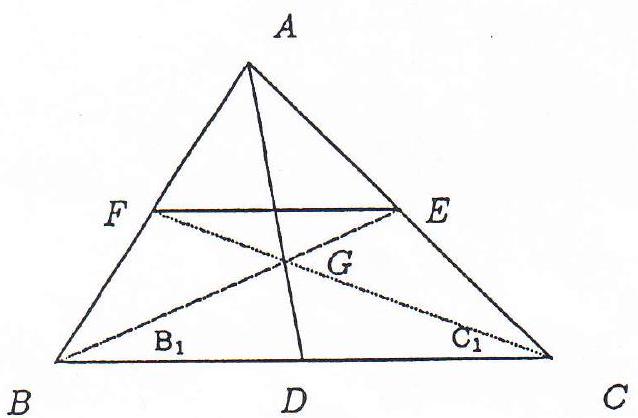
Now, since $E F \| B C$, we get
$$
\begin{aligned}
\angle E G F & =180^{\circ}-\left(B_{1}+C_{1}\right) \\
& \geq 180^{\circ}-(B+C) \\
& =A .
\end{aligned}
$$
(1)
Thus, if $A E G F$ is cyclic, we would have $\angle E G F+\angle A=180^{\circ}$. Therefore it is necessary that $0<\angle A \leq 90^{\circ}$.
## Continuation "A"
Let $O$ be the circumcentre of $\triangle A F E$. Without loss of generality, let the radius of this circle be 1.
We then let $A=1, F=z=e^{i \theta}$ and $E=z e^{2 i \alpha}=e^{i(\theta+2 \alpha)}$.
Then $\angle A=\alpha, 0<\alpha \leq 90^{\circ}$, and $0<\theta<360^{\circ}-2 \alpha$.
Thus,
$$
B=2 z-1
$$
and
$$
\begin{aligned}
G & =\frac{1}{3}(2 z-1)+\frac{2}{3}\left(z e^{2 i \alpha}\right) \\
& =\frac{1}{3}\left(2 e^{i \theta}+2 e^{i(\theta+2 \alpha)}-1\right)
\end{aligned}
$$
For quadrilateral $A F G E$ to be cyclic, it is now necessary that
$$
|G|=1 .
$$
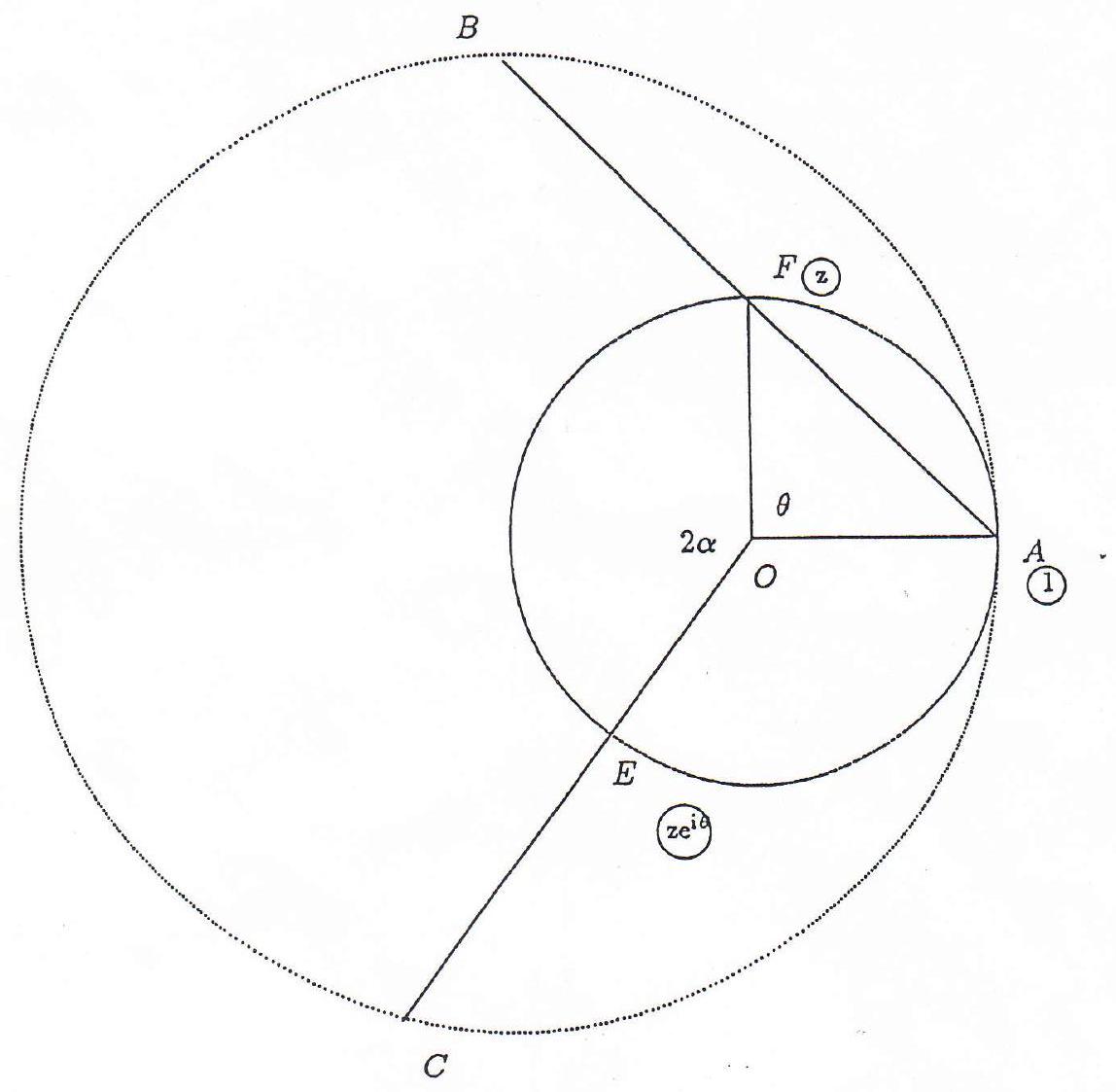
For $|G|=1$, we must have
$$
\begin{aligned}
9= & (2 \cos (\theta)+2 \cos (\theta+2 \alpha)-1)^{2}+(2 \sin (\theta)+2 \sin (\theta+2 \alpha))^{2} \\
= & 4\left(\cos ^{2}(\theta)+\sin ^{2}(\theta)\right)+4\left(\cos ^{2}(\theta+2 \alpha)+\sin ^{2}(\theta+2 \alpha)\right)+1 \\
& +8(\cos (\theta) \cos (\theta+2 \alpha)+\sin (\theta) \sin (\theta+2 \alpha))-4 \cos (\theta)-4 \cos (\theta+2 \alpha) \\
= & 9+8 \cos (2 \alpha)-8 \cos (\alpha) \cos (\theta+\alpha)
\end{aligned}
$$
so that
$$
\cos (\theta+\alpha)=\frac{\cos (2 \alpha)}{\cos (\alpha)}
$$
] Now, $\left|\frac{\cos (2 \alpha)}{\cos (\alpha)}\right| \leq 1$ if and only if $\alpha \in\left(0,60^{\circ}\right]$ in the range of $\alpha$ under consideration, that is $\alpha \in\left(0,00^{\circ}\right]$. There is equality if and only if $\alpha=60^{\circ}$.
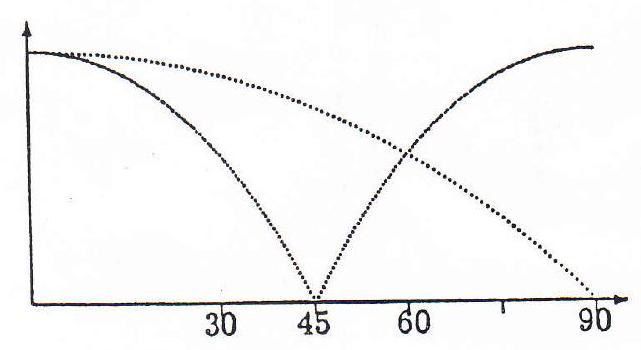
$\square$ Note there is only one solution. The apparent other solution is the mirror image of the first. We are solving for $\alpha+\theta$. The other solution is $360^{\circ}-\alpha-\theta$.
## Continuation "B"
Let $O$ be the circumcentre of triangle $A E F$. Let $A P$ be a diameter of this circle. Construct the circle with centre $P$ and radius $A P$. Then $B$ and $C$ lie on this circle.
It is clear that the problem is solved if we allow the angle $\angle B A C=\alpha$ to vary and restrict $B$ and $C$ to the constructed circle.
Let $\theta$ be the angle from the drawn axis. Then $\theta$ lies in the range $\left(0,180^{\circ}-\alpha\right)$. We must not forget the necessary restriction of $\alpha$, that is $\alpha \in\left(0,90^{\circ}\right.$.
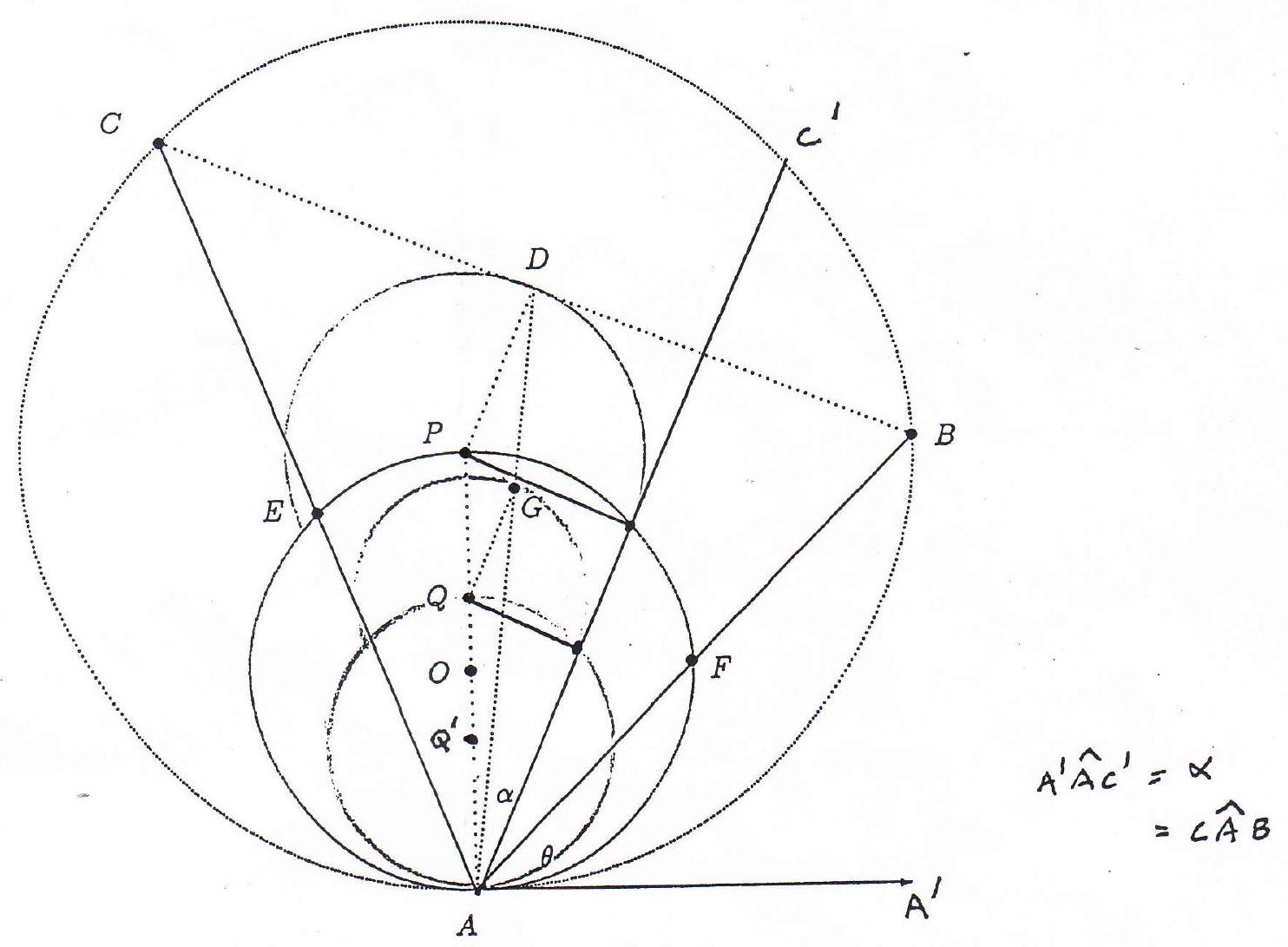
Now, $D$ lies on an arc of a circle, centre $P$, radius $P D$ exterior to the circle, centre $O$, radius $A O$.
By similarity, $G$, lies on an arc of a circle, centre $Q$, radius $Q G$ where $A Q=\frac{2}{3} A P$ and $Q G=\frac{2}{3} P D$.
For the quadrilateral $A F G E$ to be cyclic, we must have that the radius $Q G$ is greater than or equal to $Q P$.
The easiest way to calulate these radii is to consider the case in which the diameter $A P$ bisects the angle $\angle B A C$.
Thus we re-draw the diagram as below. Let $A H$ be a diameter of the larger circle.
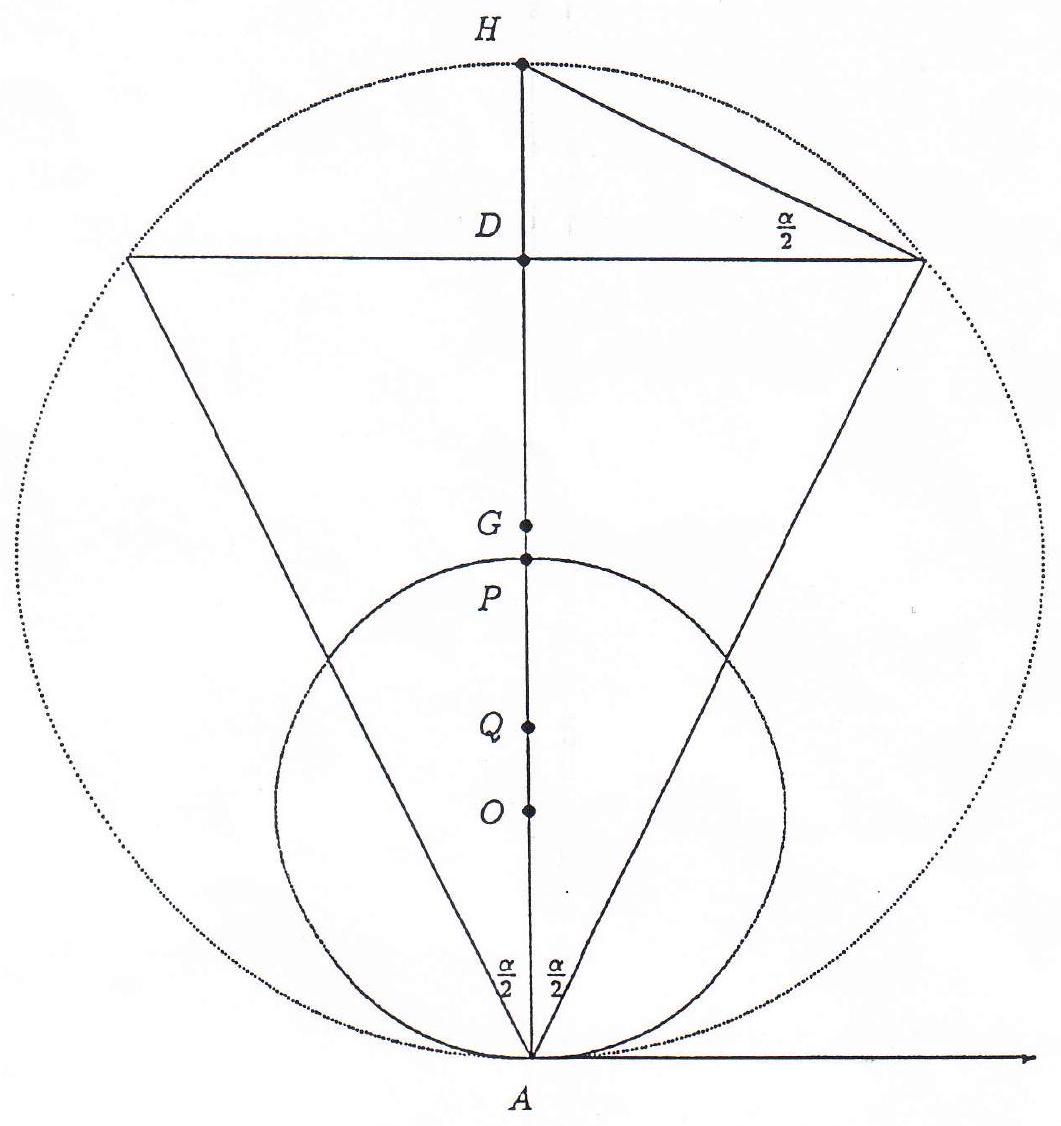
Thus we have $A H=4$ and by similar triangles,
$$
\frac{A D}{A B}=\frac{A B}{A H}=\cos \left(\frac{\alpha}{2}\right)
$$
so that
$$
\begin{aligned}
A D & =4 \cos ^{2}\left(\frac{\alpha}{2}\right) \\
& =2+2 \cos (\alpha) .
\end{aligned}
$$
Thus $P D=2 \cos (\alpha)$ and $Q G=\frac{2}{3} 2 \cos (\alpha)=\frac{4}{3} \cos (\alpha)$.
The necessary condition for a cyclic quadrilateral is then
$$
\frac{4}{3}(1+\cos (\alpha)) \geq 2
$$
[5
$$
\cos (\alpha) \geq \frac{1}{2}
$$
:7
Thus it is clear that there is precisely one (up to similarity) solution for $0<\alpha \leq 60^{\circ}$ and no solutions otherwise.
|
0<\alpha \leq 60^{\circ}
|
Yes
|
Yes
|
math-word-problem
|
Geometry
|
In $\triangle A B C$, let $D, E, F$ be the midpoints of $B C, A C, A B$ respectively and let $G$ be the centroid of the triangle.
For each value of $\angle B A C$, how many non-similar triangles are there in which $A E G F$ is a cyclic quadrilateral?
|
in the figure as shown below, we first show that it is necessary that $\angle A$ is less than $90^{\circ}$ if the quadrilateral $A E G F$ ; cyclic.

Now, since $E F \| B C$, we get
$$
\begin{aligned}
\angle E G F & =180^{\circ}-\left(B_{1}+C_{1}\right) \\
& \geq 180^{\circ}-(B+C) \\
& =A .
\end{aligned}
$$
(1)
Thus, if $A E G F$ is cyclic, we would have $\angle E G F+\angle A=180^{\circ}$. Therefore it is necessary that $0<\angle A \leq 90^{\circ}$.
## Continuation "A"
Let $O$ be the circumcentre of $\triangle A F E$. Without loss of generality, let the radius of this circle be 1.
We then let $A=1, F=z=e^{i \theta}$ and $E=z e^{2 i \alpha}=e^{i(\theta+2 \alpha)}$.
Then $\angle A=\alpha, 0<\alpha \leq 90^{\circ}$, and $0<\theta<360^{\circ}-2 \alpha$.
Thus,
$$
B=2 z-1
$$
and
$$
\begin{aligned}
G & =\frac{1}{3}(2 z-1)+\frac{2}{3}\left(z e^{2 i \alpha}\right) \\
& =\frac{1}{3}\left(2 e^{i \theta}+2 e^{i(\theta+2 \alpha)}-1\right)
\end{aligned}
$$
For quadrilateral $A F G E$ to be cyclic, it is now necessary that
$$
|G|=1 .
$$

For $|G|=1$, we must have
$$
\begin{aligned}
9= & (2 \cos (\theta)+2 \cos (\theta+2 \alpha)-1)^{2}+(2 \sin (\theta)+2 \sin (\theta+2 \alpha))^{2} \\
= & 4\left(\cos ^{2}(\theta)+\sin ^{2}(\theta)\right)+4\left(\cos ^{2}(\theta+2 \alpha)+\sin ^{2}(\theta+2 \alpha)\right)+1 \\
& +8(\cos (\theta) \cos (\theta+2 \alpha)+\sin (\theta) \sin (\theta+2 \alpha))-4 \cos (\theta)-4 \cos (\theta+2 \alpha) \\
= & 9+8 \cos (2 \alpha)-8 \cos (\alpha) \cos (\theta+\alpha)
\end{aligned}
$$
so that
$$
\cos (\theta+\alpha)=\frac{\cos (2 \alpha)}{\cos (\alpha)}
$$
] Now, $\left|\frac{\cos (2 \alpha)}{\cos (\alpha)}\right| \leq 1$ if and only if $\alpha \in\left(0,60^{\circ}\right]$ in the range of $\alpha$ under consideration, that is $\alpha \in\left(0,00^{\circ}\right]$. There is equality if and only if $\alpha=60^{\circ}$.

$\square$ Note there is only one solution. The apparent other solution is the mirror image of the first. We are solving for $\alpha+\theta$. The other solution is $360^{\circ}-\alpha-\theta$.
## Continuation "B"
Let $O$ be the circumcentre of triangle $A E F$. Let $A P$ be a diameter of this circle. Construct the circle with centre $P$ and radius $A P$. Then $B$ and $C$ lie on this circle.
It is clear that the problem is solved if we allow the angle $\angle B A C=\alpha$ to vary and restrict $B$ and $C$ to the constructed circle.
Let $\theta$ be the angle from the drawn axis. Then $\theta$ lies in the range $\left(0,180^{\circ}-\alpha\right)$. We must not forget the necessary restriction of $\alpha$, that is $\alpha \in\left(0,90^{\circ}\right.$.

Now, $D$ lies on an arc of a circle, centre $P$, radius $P D$ exterior to the circle, centre $O$, radius $A O$.
By similarity, $G$, lies on an arc of a circle, centre $Q$, radius $Q G$ where $A Q=\frac{2}{3} A P$ and $Q G=\frac{2}{3} P D$.
For the quadrilateral $A F G E$ to be cyclic, we must have that the radius $Q G$ is greater than or equal to $Q P$.
The easiest way to calulate these radii is to consider the case in which the diameter $A P$ bisects the angle $\angle B A C$.
Thus we re-draw the diagram as below. Let $A H$ be a diameter of the larger circle.

Thus we have $A H=4$ and by similar triangles,
$$
\frac{A D}{A B}=\frac{A B}{A H}=\cos \left(\frac{\alpha}{2}\right)
$$
so that
$$
\begin{aligned}
A D & =4 \cos ^{2}\left(\frac{\alpha}{2}\right) \\
& =2+2 \cos (\alpha) .
\end{aligned}
$$
Thus $P D=2 \cos (\alpha)$ and $Q G=\frac{2}{3} 2 \cos (\alpha)=\frac{4}{3} \cos (\alpha)$.
The necessary condition for a cyclic quadrilateral is then
$$
\frac{4}{3}(1+\cos (\alpha)) \geq 2
$$
[5
$$
\cos (\alpha) \geq \frac{1}{2}
$$
:7
Thus it is clear that there is precisely one (up to similarity) solution for $0<\alpha \leq 60^{\circ}$ and no solutions otherwise.
|
{
"resource_path": "APMO/segmented/en-apmo1990_sol.jsonl",
"problem_match": "# Question 1 ",
"solution_match": "\nTHIRD SOLUTION\n"
}
|
72759d9d-1850-552c-805d-540717559e2c
| 604,224 |
Let $a_{1}, a_{2}, \ldots, a_{n}$ be positive real numbers, and let $S_{k}$ be the sum of products of $a_{1}, a_{2}, \ldots, a_{n}$ taken $k$ at a time.
Show that
$$
S_{k} S_{n-k} \geq\binom{ n}{k}^{2} a_{1} a_{2} \ldots a_{n}, \quad \text { for } \quad k=1,2, \ldots, n-1
$$
|
$$
\binom{n}{k} a_{1} a_{2} \ldots a_{n}
$$
$2=\sum_{1 \leq i_{1}<i_{2}<\ldots<i_{k} \leq n} a_{i_{1}} a_{i_{2}} \ldots a_{i_{k}} \cdot a_{1} a_{2} \ldots a_{n} / a_{i_{1}} a_{i_{2}} \ldots a_{i_{k}}$
(and using the Cauchy-Schwarz inequality)
$$
\begin{aligned}
& \leq\left(\sum_{1 \leq i_{1}<i_{2}<\ldots<i_{k} \leq n} a_{i_{1}} a_{i_{2}} \ldots a_{i_{k}}\right)^{\frac{1}{2}} \cdot\left(\sum_{1 \leq i_{1}<i_{2}<\ldots<i_{k} \leq n} a_{1} a_{2} \ldots a_{n} / a_{i_{1}} a_{i_{2}} \ldots a_{i_{k}}\right)^{\frac{1}{2}} \\
& =S_{k}^{\frac{1}{2}} \cdot S_{n-k}^{\frac{1}{2}}
\end{aligned}
$$
Therefore
$$
\binom{n}{k}^{2} a_{1} a_{2} \ldots a_{n} \leq S_{k} S_{n-k}
$$
q.e.d.
|
proof
|
Yes
|
Yes
|
proof
|
Inequalities
|
Let $a_{1}, a_{2}, \ldots, a_{n}$ be positive real numbers, and let $S_{k}$ be the sum of products of $a_{1}, a_{2}, \ldots, a_{n}$ taken $k$ at a time.
Show that
$$
S_{k} S_{n-k} \geq\binom{ n}{k}^{2} a_{1} a_{2} \ldots a_{n}, \quad \text { for } \quad k=1,2, \ldots, n-1
$$
|
$$
\binom{n}{k} a_{1} a_{2} \ldots a_{n}
$$
$2=\sum_{1 \leq i_{1}<i_{2}<\ldots<i_{k} \leq n} a_{i_{1}} a_{i_{2}} \ldots a_{i_{k}} \cdot a_{1} a_{2} \ldots a_{n} / a_{i_{1}} a_{i_{2}} \ldots a_{i_{k}}$
(and using the Cauchy-Schwarz inequality)
$$
\begin{aligned}
& \leq\left(\sum_{1 \leq i_{1}<i_{2}<\ldots<i_{k} \leq n} a_{i_{1}} a_{i_{2}} \ldots a_{i_{k}}\right)^{\frac{1}{2}} \cdot\left(\sum_{1 \leq i_{1}<i_{2}<\ldots<i_{k} \leq n} a_{1} a_{2} \ldots a_{n} / a_{i_{1}} a_{i_{2}} \ldots a_{i_{k}}\right)^{\frac{1}{2}} \\
& =S_{k}^{\frac{1}{2}} \cdot S_{n-k}^{\frac{1}{2}}
\end{aligned}
$$
Therefore
$$
\binom{n}{k}^{2} a_{1} a_{2} \ldots a_{n} \leq S_{k} S_{n-k}
$$
q.e.d.
|
{
"resource_path": "APMO/segmented/en-apmo1990_sol.jsonl",
"problem_match": "# Question 2",
"solution_match": "# FIRST SOLUTION\n\n"
}
|
92756af4-1c9d-52cf-ab66-3f4f0bc5e602
| 604,264 |
Let $a_{1}, a_{2}, \ldots, a_{n}$ be positive real numbers, and let $S_{k}$ be the sum of products of $a_{1}, a_{2}, \ldots, a_{n}$ taken $k$ at a time.
Show that
$$
S_{k} S_{n-k} \geq\binom{ n}{k}^{2} a_{1} a_{2} \ldots a_{n}, \quad \text { for } \quad k=1,2, \ldots, n-1
$$
|
(provided by the Canadian Problems Committee).
Write $S_{k}$ as $\sum_{i=1}^{\binom{n}{k}} t_{i}$. Then
주
$$
S_{n-k}=\left(\prod_{m=1}^{n} a_{m}\right)\left(\sum_{i=1}^{\binom{n}{k}} \frac{1}{t_{i}}\right)
$$
$$
\text { so that } \left.\begin{array}{rl}
S_{k} S_{n-k} & =\left(\prod_{m=1}^{n} a_{m}\right) \cdot\left(\begin{array}{l}
\binom{n}{k} \\
i=1
\end{array} t_{i}\right)\left(\begin{array}{l}
\binom{n}{k} \\
\sum_{j=1}^{2}
\end{array} \frac{1}{t_{j}}\right) \\
& =\left(\prod_{m=1}^{n} a_{m}\right)\left[\sum_{i=1}^{\binom{n}{k}} 1+\sum_{i=1}^{\binom{n}{k}} \sum_{j=1}^{n} \begin{array}{l}
n \\
k
\end{array}\right) \\
\frac{t_{i}}{} \\
t_{j}
\end{array}\right] .
$$
As there are
$$
\frac{\binom{n}{k}^{2}-\binom{n}{k}}{2}
$$
terms in the sum

$$
\begin{aligned}
S_{k} S_{n-k} & \geq\left(\prod_{m=1}^{n} a_{m}\right)\left[\binom{n}{k}+2 \cdot \frac{\binom{n}{k}^{2}-\binom{n}{k}}{2}\right] \\
& =\binom{n}{k}^{2}\left(\prod_{m=1}^{n} a_{m}\right)
\end{aligned}
$$
since $\frac{t_{i}}{t_{j}}+\frac{t_{j}}{t_{i}} \geq 2$ for $t_{i}, t_{j}>0$.
|
proof
|
Yes
|
Incomplete
|
proof
|
Inequalities
|
Let $a_{1}, a_{2}, \ldots, a_{n}$ be positive real numbers, and let $S_{k}$ be the sum of products of $a_{1}, a_{2}, \ldots, a_{n}$ taken $k$ at a time.
Show that
$$
S_{k} S_{n-k} \geq\binom{ n}{k}^{2} a_{1} a_{2} \ldots a_{n}, \quad \text { for } \quad k=1,2, \ldots, n-1
$$
|
(provided by the Canadian Problems Committee).
Write $S_{k}$ as $\sum_{i=1}^{\binom{n}{k}} t_{i}$. Then
주
$$
S_{n-k}=\left(\prod_{m=1}^{n} a_{m}\right)\left(\sum_{i=1}^{\binom{n}{k}} \frac{1}{t_{i}}\right)
$$
$$
\text { so that } \left.\begin{array}{rl}
S_{k} S_{n-k} & =\left(\prod_{m=1}^{n} a_{m}\right) \cdot\left(\begin{array}{l}
\binom{n}{k} \\
i=1
\end{array} t_{i}\right)\left(\begin{array}{l}
\binom{n}{k} \\
\sum_{j=1}^{2}
\end{array} \frac{1}{t_{j}}\right) \\
& =\left(\prod_{m=1}^{n} a_{m}\right)\left[\sum_{i=1}^{\binom{n}{k}} 1+\sum_{i=1}^{\binom{n}{k}} \sum_{j=1}^{n} \begin{array}{l}
n \\
k
\end{array}\right) \\
\frac{t_{i}}{} \\
t_{j}
\end{array}\right] .
$$
As there are
$$
\frac{\binom{n}{k}^{2}-\binom{n}{k}}{2}
$$
terms in the sum

$$
\begin{aligned}
S_{k} S_{n-k} & \geq\left(\prod_{m=1}^{n} a_{m}\right)\left[\binom{n}{k}+2 \cdot \frac{\binom{n}{k}^{2}-\binom{n}{k}}{2}\right] \\
& =\binom{n}{k}^{2}\left(\prod_{m=1}^{n} a_{m}\right)
\end{aligned}
$$
since $\frac{t_{i}}{t_{j}}+\frac{t_{j}}{t_{i}} \geq 2$ for $t_{i}, t_{j}>0$.
|
{
"resource_path": "APMO/segmented/en-apmo1990_sol.jsonl",
"problem_match": "# Question 2",
"solution_match": "\nSECOND SOLUTION "
}
|
92756af4-1c9d-52cf-ab66-3f4f0bc5e602
| 604,264 |
Consider all the triangles $A B C$ which have a fixed base $A B$ and whose altitude from $C$ is a constant $h$. For which of these triangles is the product of its altitudes a maximum?
|
Let $h_{a}$ and $h_{b}$ be the altitudes from $A$ and $B$, respectively. Then
$$
\begin{aligned}
A B \cdot h \cdot A C \cdot h_{b} \cdot B C \cdot h_{a} & =8 . \text { area of } \triangle A B C)^{3} \\
& =(A B \cdot h)^{3},
\end{aligned}
$$
园
which is a constant. So the product $h . h_{a} \cdot h_{b}$ attains its maximum when the product $A C . B C$ attains its minimum.
Since
$$
\begin{aligned}
(\sin C) \cdot A C \cdot B C & =B C \cdot h_{a} \\
& =2 \cdot \text { area of } \triangle A B C
\end{aligned}
$$
(3)
which is a constant, $A C \cdot B C$ attains its minimum when $\sin C$ reaches its maximum. There are two cases:
(a) $h \leq A B / 2$. Then there exists a triangle $A B C$ which has a right angle at $C$, and for precisely such a triangle $\sin C$ attains its maximum, namely 1 .
(b) $h>A B / 2$. In this case the angle at $C$ is acute and assumes its maximum when the triangle is isosceles.
Note that a solution using calculus obviously exists.
|
not found
|
Yes
|
Incomplete
|
math-word-problem
|
Geometry
|
Consider all the triangles $A B C$ which have a fixed base $A B$ and whose altitude from $C$ is a constant $h$. For which of these triangles is the product of its altitudes a maximum?
|
Let $h_{a}$ and $h_{b}$ be the altitudes from $A$ and $B$, respectively. Then
$$
\begin{aligned}
A B \cdot h \cdot A C \cdot h_{b} \cdot B C \cdot h_{a} & =8 . \text { area of } \triangle A B C)^{3} \\
& =(A B \cdot h)^{3},
\end{aligned}
$$
园
which is a constant. So the product $h . h_{a} \cdot h_{b}$ attains its maximum when the product $A C . B C$ attains its minimum.
Since
$$
\begin{aligned}
(\sin C) \cdot A C \cdot B C & =B C \cdot h_{a} \\
& =2 \cdot \text { area of } \triangle A B C
\end{aligned}
$$
(3)
which is a constant, $A C \cdot B C$ attains its minimum when $\sin C$ reaches its maximum. There are two cases:
(a) $h \leq A B / 2$. Then there exists a triangle $A B C$ which has a right angle at $C$, and for precisely such a triangle $\sin C$ attains its maximum, namely 1 .
(b) $h>A B / 2$. In this case the angle at $C$ is acute and assumes its maximum when the triangle is isosceles.
Note that a solution using calculus obviously exists.
|
{
"resource_path": "APMO/segmented/en-apmo1990_sol.jsonl",
"problem_match": "# Question 3",
"solution_match": "# SOLUTION:"
}
|
b1c671c1-7a4b-5875-8c4a-600c99bedcd8
| 604,287 |
A set of 1990 persons is divided into non-intersecting subsets in such a way that
(a) no one in a subset knows all the others in the subset;
(b) among any three persons in a subset, there are always at least two who do not know each other; and
(c) for any two persons in a subset who do not know each other, there is exactly one person in the same subset knowing both of them.
(i) Prove that within each subset, every person has the same number of acquaintances.
(ii) Determine the maximum possible number of subsets.
Note: it is understood that if a person $A$ knows person $B$, then person $B$ will know person $A$; an acquaintance is someone who is known. Every person is assumed to know one's self.
|
(i) Let $S$ be a subset of persons satisfying conditions (a), (b) and (c). Let $x \in S$ be one who knows the maximum number of persons in $S$.
Assume that $x$ knows $x_{1}, x_{2}, \ldots, x_{n}$. By (b), $x_{i}$ and $x_{j}$ are strangers if $i \neq j$. For each $x_{i}$, let $N_{i}$ be the set of persons in $S$ who know $x_{i}$ but not $x$. Note that, for $i \neq j, N_{i}$ has no person in common with $N_{j}$, otherwise there would be more than one person knowing $x_{i}$ and $x_{j}$, contradicting (c).
By (a) we may assume that $N_{1}$ is not empty.) Let $y_{1} \in N_{1}$. By (c), for each $k>1$, there is exactly one person $y_{k}$ in $N_{k}$ who knows $y_{1}$. This means that $y_{1}$ knows $n$ persons, namely $x_{1}, y_{2}, \ldots, y_{n}$.
Because $n$ is the maximal number of persons in $S$ a person in $S$ can know, $y_{1}$ knows exactly $n$ persons in $S$. By precisely the same reasoning we find that each person in $N_{i}$, $i=1,2, \ldots, n$, knows exactly $n$ persons in $S$.
Letting $y_{1}$ take the role of $x$ in our argument, we see that also each $x_{i}$ knows exactly $n$ persons. Note that, by (c), every person in $S$ other than $x, x_{1}, \ldots, x_{n}$, must be in some $N_{j}$. Therefore every person in $S$ knows exactly $n$ persons in $S$ and thus has the same number of acquaintances in $S$.
(ii) To maximize the number of subsets, we have to minimize the size of each group. The smallest possible subset is one in which every person knows exactly two persons, and hence there must be exactly five persons in the subset, forming a cycle where two persons stand side by side only if they know each other. Therefore the maximum possible number of subsets is 1990/5 $=398$.
|
398
|
Yes
|
Yes
|
proof
|
Combinatorics
|
A set of 1990 persons is divided into non-intersecting subsets in such a way that
(a) no one in a subset knows all the others in the subset;
(b) among any three persons in a subset, there are always at least two who do not know each other; and
(c) for any two persons in a subset who do not know each other, there is exactly one person in the same subset knowing both of them.
(i) Prove that within each subset, every person has the same number of acquaintances.
(ii) Determine the maximum possible number of subsets.
Note: it is understood that if a person $A$ knows person $B$, then person $B$ will know person $A$; an acquaintance is someone who is known. Every person is assumed to know one's self.
|
(i) Let $S$ be a subset of persons satisfying conditions (a), (b) and (c). Let $x \in S$ be one who knows the maximum number of persons in $S$.
Assume that $x$ knows $x_{1}, x_{2}, \ldots, x_{n}$. By (b), $x_{i}$ and $x_{j}$ are strangers if $i \neq j$. For each $x_{i}$, let $N_{i}$ be the set of persons in $S$ who know $x_{i}$ but not $x$. Note that, for $i \neq j, N_{i}$ has no person in common with $N_{j}$, otherwise there would be more than one person knowing $x_{i}$ and $x_{j}$, contradicting (c).
By (a) we may assume that $N_{1}$ is not empty.) Let $y_{1} \in N_{1}$. By (c), for each $k>1$, there is exactly one person $y_{k}$ in $N_{k}$ who knows $y_{1}$. This means that $y_{1}$ knows $n$ persons, namely $x_{1}, y_{2}, \ldots, y_{n}$.
Because $n$ is the maximal number of persons in $S$ a person in $S$ can know, $y_{1}$ knows exactly $n$ persons in $S$. By precisely the same reasoning we find that each person in $N_{i}$, $i=1,2, \ldots, n$, knows exactly $n$ persons in $S$.
Letting $y_{1}$ take the role of $x$ in our argument, we see that also each $x_{i}$ knows exactly $n$ persons. Note that, by (c), every person in $S$ other than $x, x_{1}, \ldots, x_{n}$, must be in some $N_{j}$. Therefore every person in $S$ knows exactly $n$ persons in $S$ and thus has the same number of acquaintances in $S$.
(ii) To maximize the number of subsets, we have to minimize the size of each group. The smallest possible subset is one in which every person knows exactly two persons, and hence there must be exactly five persons in the subset, forming a cycle where two persons stand side by side only if they know each other. Therefore the maximum possible number of subsets is 1990/5 $=398$.
|
{
"resource_path": "APMO/segmented/en-apmo1990_sol.jsonl",
"problem_match": "# Question 4",
"solution_match": "# SOLUTION:"
}
|
97a76adf-0b62-5330-a551-d2887bfc31ee
| 604,299 |
Show that for every integer $n \geq 6$, there exists a convex hexagon which can be dissected into exactly $n$ congruent triangles.
|
(provided by the Canadian Problems Committee).
The basic building blocks will be right angled triangles with sides $p, q$ (which are positive integers) adjacent to the right angle.
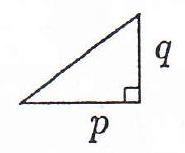
In the first instance, we take $p=q=1$ and construct five basic building blocks: $L_{1}, L_{2}, M, R_{1}$ and $R_{2}$ 。
## [3)
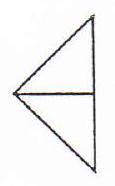
$L_{1}$
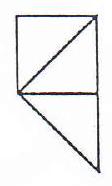
$L_{2}$
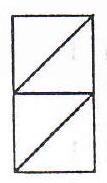
M
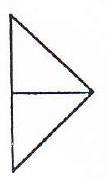
$R_{1}$
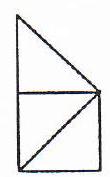
$R_{2}$
We shall now build convex hexagons by taking, on the left, one of the blocks $L_{i}$, attaching $n$ copies of the block $M$, and finally attaching one of the blocks $R_{j}$. We must therefore exclude the case when $(i, j)=(2,1)$ for this does not generate a hexagon. Further, for $(i, j)=(1,1)$ or $(i, j)=(1,2)$, we require that $n \geq 1$, whereas for $(i, j)=$ $(2,2)$, we only need require that $n \geq 0$.
Thus, with the obvious interpretation:
$L_{1}+n M+R_{1}$ gives a convex hexagon containing $2+4 n+2=4 n+4 \quad(n \geq 1)$ congruent triangles;
$L_{1}+n M+R_{2}$ gives a convex hexagon containing $2+4 n+3=4 n+5(n \geq 1)$ congruent triangles; and
$L_{2}+n M+R_{2}$ gives a convex hexagon containing $3+4 n+3=4 n+6 \quad(n \geq 0)$ congruent triangles, or $4 n+2(n \geq 1)$ congruent triangles.
We shall now modify the lengths of the sides of the right triangle to obtain the case of $4 n+3 \quad(n \geq 1)$ congruent triangles.
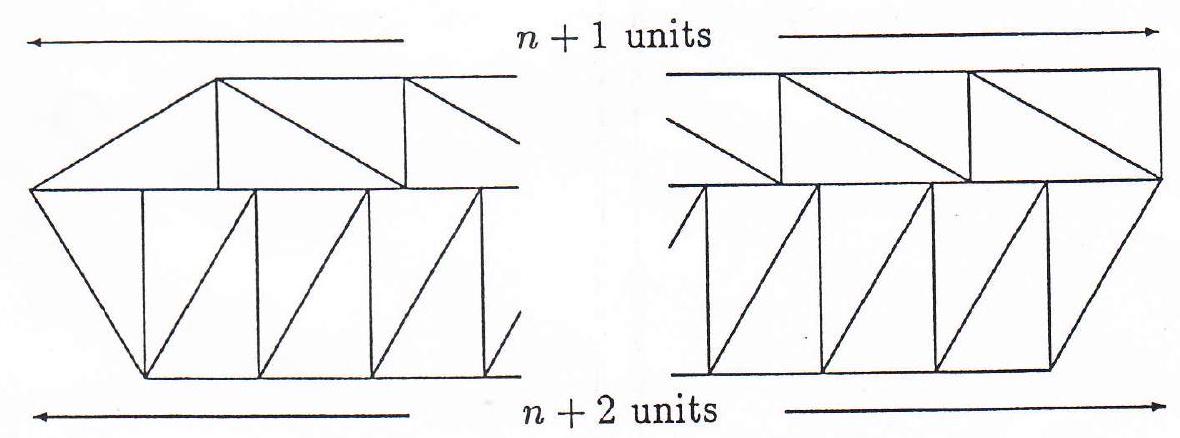
So we have $2 n+1$ triangles in the top part and $2 n+2$ triangles in the bottom part. In order to match, we need
$$
(n+1) p=(n+2) q
$$
so we take
$$
q=n+1 \quad \text { and } \quad p=n+2
$$
This completes the solution.
|
proof
|
Yes
|
Yes
|
proof
|
Geometry
|
Show that for every integer $n \geq 6$, there exists a convex hexagon which can be dissected into exactly $n$ congruent triangles.
|
(provided by the Canadian Problems Committee).
The basic building blocks will be right angled triangles with sides $p, q$ (which are positive integers) adjacent to the right angle.

In the first instance, we take $p=q=1$ and construct five basic building blocks: $L_{1}, L_{2}, M, R_{1}$ and $R_{2}$ 。
## [3)

$L_{1}$

$L_{2}$

M

$R_{1}$

$R_{2}$
We shall now build convex hexagons by taking, on the left, one of the blocks $L_{i}$, attaching $n$ copies of the block $M$, and finally attaching one of the blocks $R_{j}$. We must therefore exclude the case when $(i, j)=(2,1)$ for this does not generate a hexagon. Further, for $(i, j)=(1,1)$ or $(i, j)=(1,2)$, we require that $n \geq 1$, whereas for $(i, j)=$ $(2,2)$, we only need require that $n \geq 0$.
Thus, with the obvious interpretation:
$L_{1}+n M+R_{1}$ gives a convex hexagon containing $2+4 n+2=4 n+4 \quad(n \geq 1)$ congruent triangles;
$L_{1}+n M+R_{2}$ gives a convex hexagon containing $2+4 n+3=4 n+5(n \geq 1)$ congruent triangles; and
$L_{2}+n M+R_{2}$ gives a convex hexagon containing $3+4 n+3=4 n+6 \quad(n \geq 0)$ congruent triangles, or $4 n+2(n \geq 1)$ congruent triangles.
We shall now modify the lengths of the sides of the right triangle to obtain the case of $4 n+3 \quad(n \geq 1)$ congruent triangles.

So we have $2 n+1$ triangles in the top part and $2 n+2$ triangles in the bottom part. In order to match, we need
$$
(n+1) p=(n+2) q
$$
so we take
$$
q=n+1 \quad \text { and } \quad p=n+2
$$
This completes the solution.
|
{
"resource_path": "APMO/segmented/en-apmo1990_sol.jsonl",
"problem_match": "# Question 5",
"solution_match": "\nFIRST SOLUTION "
}
|
73c9ec95-e9ca-5aef-bf23-74672775d15a
| 54,403 |
Show that for every integer $n \geq 6$, there exists a convex hexagon which can be dissected into exactly $n$ congruent triangles.
|
(provided by the Canadian Problems Committee):
The basic building blocks will be right angled triangles with sides $m, n$ (which are positive integers) adjacent to the right angle.
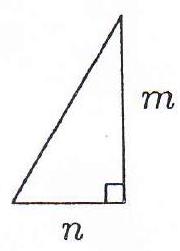
We construct an "UPPER CONFIGURATION", being a rectangle consisting of $m$ building block units of pairs of triangles with the side of length $n$ as base. This gives a base length of $n m$ across the configuration.
We further construct a "LOWER CONFIGURATION", being a triangle with base up, consisting along the base of $n$ building block units. Again, we have a base length of $m n$ across the configuration.
Two triangles in the upper configuration are shaded horizontally. One triangle in the lower configuration is also shaded horizontally. Another triangle in the lower configuration is shaded vertically.
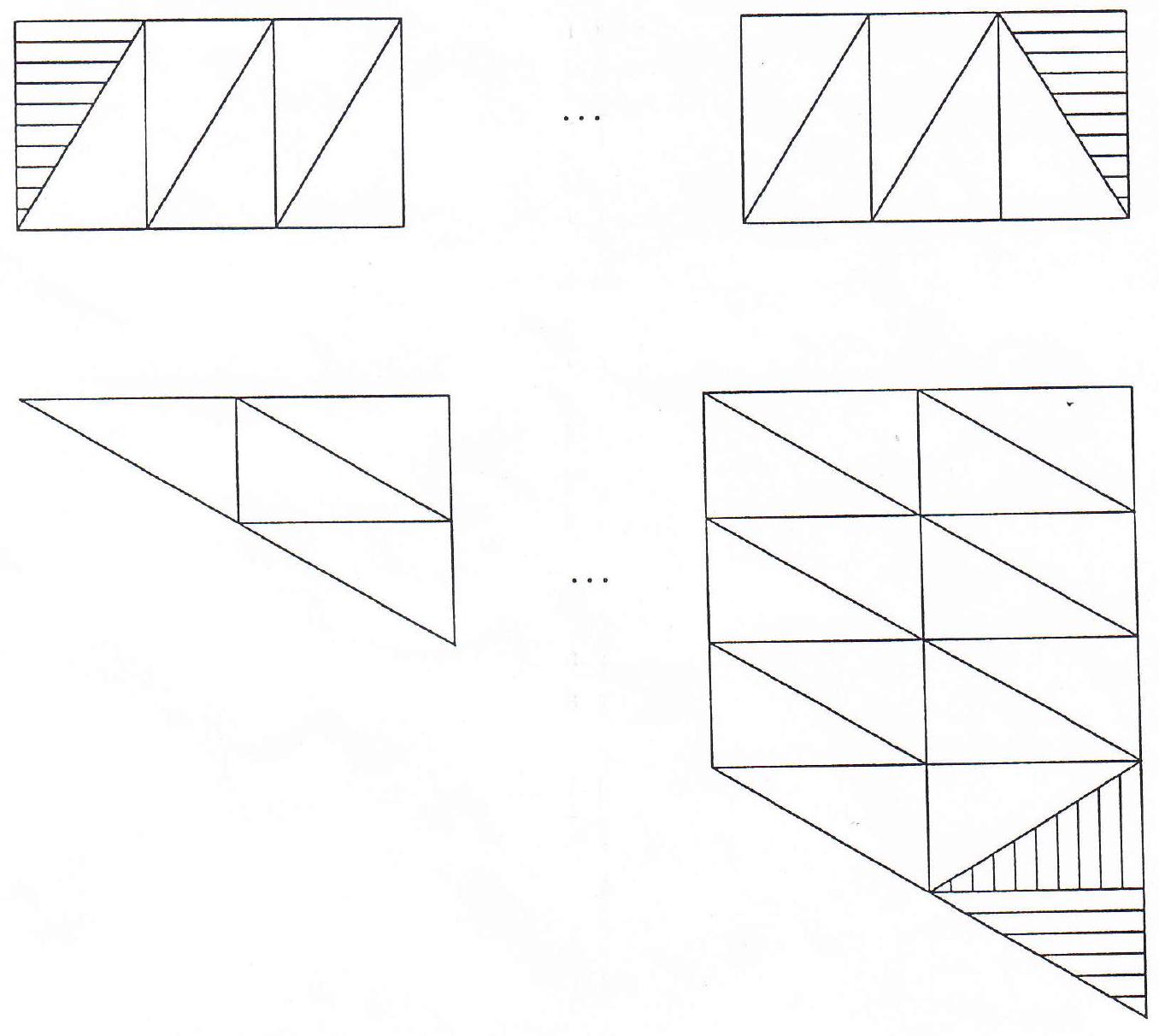
Now consider the figure obtained by joining the two configurations along the base line of common length nm. To create the classes of hexagons defined below, it is necessary that both $n \geq 3$ and $m \geq 3$.
We create a class of convex hexagons (class 1 ) by omitting the three triangles that are shaded horizontally. The other class of convex hexagons (class 2) is obtained by omitting all shaded triangles.
Now count the total number of triangles in the full configuration.
The upper configuration gives $2 m$ triangles. The lower configuration gives
$$
\sum_{k=1}^{n}(2 k-1)=n^{2} \quad \text { triangles. }
$$
Thus the total number of triangles in a hexagon in class 1 is
$$
2 m-2+n^{2}-1
$$
and the total number of triangle in a hexagon in class 2 is
$$
2 m-2+n^{2}-2
$$
These, together with the restrictions on $n$ and $m$, generate all positive integers greater than or equal to 11.
For the integers $6,7,8,9$ and 10 , we give specific examples:
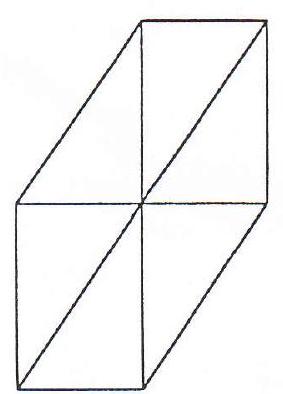
6
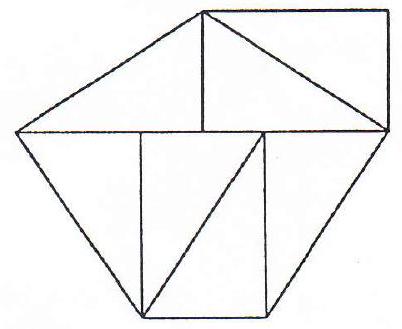
7
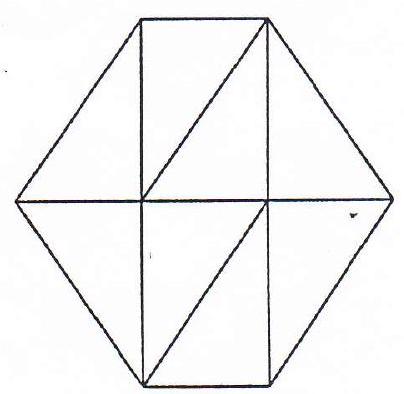
8
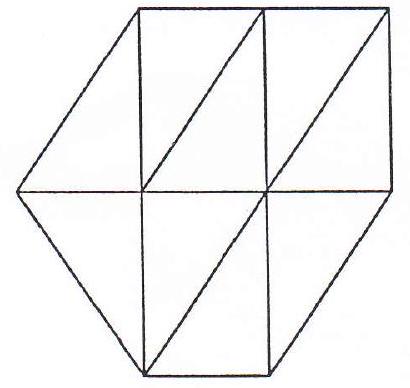
9
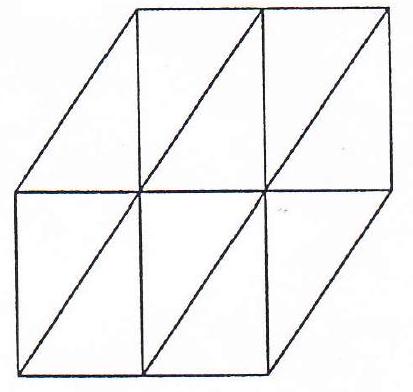
10
This completes the solution.
There are $\binom{n}{k}$ products of the $a_{i}$ taken $k$ at a time. Amongst these products any given $a_{i}$ will appear $\binom{n-1}{k-1}$ times, since $\binom{n-1}{k-1}$ is the number of ways of choosing the other factors of the product. So the $\mathrm{AM} / \mathrm{GM}$ inequality gives
## ④
$$
\frac{S_{k}}{\binom{n}{k}} \geq\left[\prod_{i=1}^{n} a_{i}^{\binom{n-1}{k-1}}\right]^{\frac{1}{n}\binom{n}{n}}
$$
But $\binom{n}{k}=\frac{n}{k}\binom{n-1}{k-1}$, leading to
6 S $\quad S_{k} \geq\binom{ n}{k}\left(\prod_{i=1}^{n} a_{i}\right)^{\frac{k}{n}}$.
Hence
田
$$
S_{k} S_{n-k} \geq\binom{ n}{k}\left(\prod_{i=1}^{n} a_{i}\right)^{\frac{k}{n}}\binom{n}{n-k}\left(\prod_{i=1}^{n} a_{i}\right)^{\frac{n-k}{n}}=\binom{n}{k}^{2}\left(\prod_{1}^{n} a_{i}\right) .
$$
|
proof
|
Yes
|
Yes
|
proof
|
Geometry
|
Show that for every integer $n \geq 6$, there exists a convex hexagon which can be dissected into exactly $n$ congruent triangles.
|
(provided by the Canadian Problems Committee):
The basic building blocks will be right angled triangles with sides $m, n$ (which are positive integers) adjacent to the right angle.

We construct an "UPPER CONFIGURATION", being a rectangle consisting of $m$ building block units of pairs of triangles with the side of length $n$ as base. This gives a base length of $n m$ across the configuration.
We further construct a "LOWER CONFIGURATION", being a triangle with base up, consisting along the base of $n$ building block units. Again, we have a base length of $m n$ across the configuration.
Two triangles in the upper configuration are shaded horizontally. One triangle in the lower configuration is also shaded horizontally. Another triangle in the lower configuration is shaded vertically.

Now consider the figure obtained by joining the two configurations along the base line of common length nm. To create the classes of hexagons defined below, it is necessary that both $n \geq 3$ and $m \geq 3$.
We create a class of convex hexagons (class 1 ) by omitting the three triangles that are shaded horizontally. The other class of convex hexagons (class 2) is obtained by omitting all shaded triangles.
Now count the total number of triangles in the full configuration.
The upper configuration gives $2 m$ triangles. The lower configuration gives
$$
\sum_{k=1}^{n}(2 k-1)=n^{2} \quad \text { triangles. }
$$
Thus the total number of triangles in a hexagon in class 1 is
$$
2 m-2+n^{2}-1
$$
and the total number of triangle in a hexagon in class 2 is
$$
2 m-2+n^{2}-2
$$
These, together with the restrictions on $n$ and $m$, generate all positive integers greater than or equal to 11.
For the integers $6,7,8,9$ and 10 , we give specific examples:

6

7

8

9

10
This completes the solution.
There are $\binom{n}{k}$ products of the $a_{i}$ taken $k$ at a time. Amongst these products any given $a_{i}$ will appear $\binom{n-1}{k-1}$ times, since $\binom{n-1}{k-1}$ is the number of ways of choosing the other factors of the product. So the $\mathrm{AM} / \mathrm{GM}$ inequality gives
## ④
$$
\frac{S_{k}}{\binom{n}{k}} \geq\left[\prod_{i=1}^{n} a_{i}^{\binom{n-1}{k-1}}\right]^{\frac{1}{n}\binom{n}{n}}
$$
But $\binom{n}{k}=\frac{n}{k}\binom{n-1}{k-1}$, leading to
6 S $\quad S_{k} \geq\binom{ n}{k}\left(\prod_{i=1}^{n} a_{i}\right)^{\frac{k}{n}}$.
Hence
田
$$
S_{k} S_{n-k} \geq\binom{ n}{k}\left(\prod_{i=1}^{n} a_{i}\right)^{\frac{k}{n}}\binom{n}{n-k}\left(\prod_{i=1}^{n} a_{i}\right)^{\frac{n-k}{n}}=\binom{n}{k}^{2}\left(\prod_{1}^{n} a_{i}\right) .
$$
|
{
"resource_path": "APMO/segmented/en-apmo1990_sol.jsonl",
"problem_match": "# Question 5",
"solution_match": "\nSECOND SOLUTION "
}
|
73c9ec95-e9ca-5aef-bf23-74672775d15a
| 54,403 |
Let $G$ be the centroid of triangle $A B C$ and $M$ be the midpoint of $B C$. Let $X$ be on $A B$ and $Y$ on $A C$ such that the points $X, Y$, and $G$ are collinear and $X Y$ and $B C$ are parallel. Suppose that $X C$ and $G B$ intersect at $Q$ and $Y B$ and $G C$ intersect at $P$. Show that triangle $M P Q$ is similar to triangle $A B C$.
|
Let $R$ be the midpoint of $A C$; so $B R$ is a median and contains the centroid $G$.
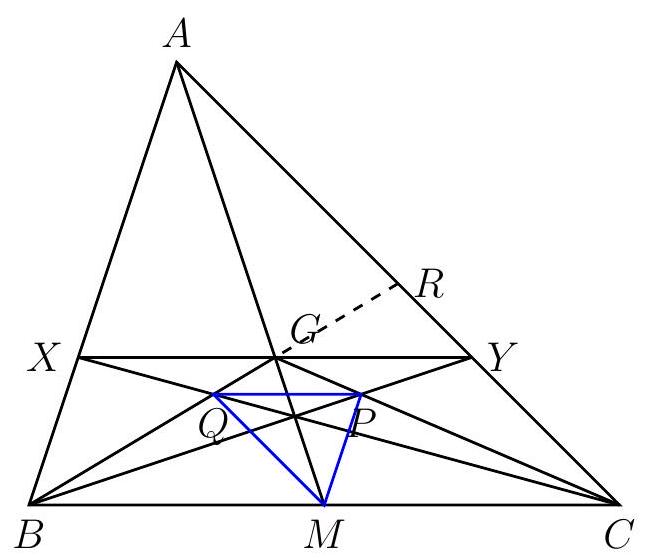
It is well known that $\frac{A G}{A M}=\frac{2}{3}$; thus the ratio of the similarity between $A X Y$ and $A B C$ is $\frac{2}{3}$. Hence $G X=\frac{1}{2} X Y=\frac{1}{3} B C$.
Now look at the similarity between triangles $Q B C$ and $Q G X$ :
$$
\frac{Q G}{Q B}=\frac{G X}{B C}=\frac{1}{3} \Longrightarrow Q B=3 Q G \Longrightarrow Q B=\frac{3}{4} B G=\frac{3}{4} \cdot \frac{2}{3} B R=\frac{1}{2} B R .
$$
Finally, since $\frac{B M}{B C}=\frac{B Q}{B R}, M Q$ is a midline in $B C R$. Therefore $M Q=\frac{1}{2} C R=\frac{1}{4} A C$ and $M Q \| A C$. Similarly, $M P=\frac{1}{4} A B$ and $M P \| A B$. This is sufficient to establish that $M P Q$ and $A B C$ are similar (with similarity ratio $\frac{1}{4}$ ).
|
proof
|
Yes
|
Yes
|
proof
|
Geometry
|
Let $G$ be the centroid of triangle $A B C$ and $M$ be the midpoint of $B C$. Let $X$ be on $A B$ and $Y$ on $A C$ such that the points $X, Y$, and $G$ are collinear and $X Y$ and $B C$ are parallel. Suppose that $X C$ and $G B$ intersect at $Q$ and $Y B$ and $G C$ intersect at $P$. Show that triangle $M P Q$ is similar to triangle $A B C$.
|
Let $R$ be the midpoint of $A C$; so $B R$ is a median and contains the centroid $G$.

It is well known that $\frac{A G}{A M}=\frac{2}{3}$; thus the ratio of the similarity between $A X Y$ and $A B C$ is $\frac{2}{3}$. Hence $G X=\frac{1}{2} X Y=\frac{1}{3} B C$.
Now look at the similarity between triangles $Q B C$ and $Q G X$ :
$$
\frac{Q G}{Q B}=\frac{G X}{B C}=\frac{1}{3} \Longrightarrow Q B=3 Q G \Longrightarrow Q B=\frac{3}{4} B G=\frac{3}{4} \cdot \frac{2}{3} B R=\frac{1}{2} B R .
$$
Finally, since $\frac{B M}{B C}=\frac{B Q}{B R}, M Q$ is a midline in $B C R$. Therefore $M Q=\frac{1}{2} C R=\frac{1}{4} A C$ and $M Q \| A C$. Similarly, $M P=\frac{1}{4} A B$ and $M P \| A B$. This is sufficient to establish that $M P Q$ and $A B C$ are similar (with similarity ratio $\frac{1}{4}$ ).
|
{
"resource_path": "APMO/segmented/en-apmo1991_sol.jsonl",
"problem_match": "# Problem 1",
"solution_match": "# Solution 1"
}
|
bd1d8513-fe5c-50c2-a9d8-0c6ddc4272c9
| 604,343 |
Let $G$ be the centroid of triangle $A B C$ and $M$ be the midpoint of $B C$. Let $X$ be on $A B$ and $Y$ on $A C$ such that the points $X, Y$, and $G$ are collinear and $X Y$ and $B C$ are parallel. Suppose that $X C$ and $G B$ intersect at $Q$ and $Y B$ and $G C$ intersect at $P$. Show that triangle $M P Q$ is similar to triangle $A B C$.
|
Let $S$ and $R$ be the midpoints of $A B$ and $A C$, respectively. Since $G$ is the centroid, it lies in the medians $B R$ and $C S$.
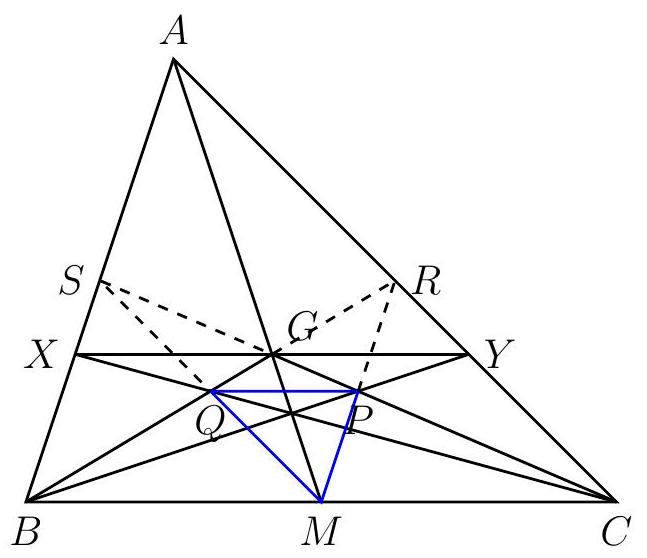
Due to the similarity between triangles $Q B C$ and $Q G X$ (which is true because $G X \| B C$ ), there is an inverse homothety with center $Q$ and ratio $-\frac{X G}{B C}=\frac{X Y}{2 B C}$ that takes $B$ to $G$ and $C$ to $X$. This homothety takes the midpoint $M$ of $B C$ to the midpoint $K$ of $G X$.
Now consider the homothety that takes $B$ to $X$ and $C$ to $G$. This new homothety, with ratio $\frac{X Y}{2 B C}$, also takes $M$ to $K$. Hence lines $B X$ (which contains side $A B$ ), $C G$ (which contains the median $C S$ ), and $M K$ have a common point, which is $S$. Thus $Q$ lies on midline $M S$.
The same reasoning proves that $P$ lies on midline $M R$. Since all homothety ratios are the same, $\frac{M Q}{M S}=\frac{M P}{M R}$, which shows that $M P Q$ is similar to $M R S$, which in turn is similar to $A B C$, and we are done.
|
proof
|
Yes
|
Yes
|
proof
|
Geometry
|
Let $G$ be the centroid of triangle $A B C$ and $M$ be the midpoint of $B C$. Let $X$ be on $A B$ and $Y$ on $A C$ such that the points $X, Y$, and $G$ are collinear and $X Y$ and $B C$ are parallel. Suppose that $X C$ and $G B$ intersect at $Q$ and $Y B$ and $G C$ intersect at $P$. Show that triangle $M P Q$ is similar to triangle $A B C$.
|
Let $S$ and $R$ be the midpoints of $A B$ and $A C$, respectively. Since $G$ is the centroid, it lies in the medians $B R$ and $C S$.

Due to the similarity between triangles $Q B C$ and $Q G X$ (which is true because $G X \| B C$ ), there is an inverse homothety with center $Q$ and ratio $-\frac{X G}{B C}=\frac{X Y}{2 B C}$ that takes $B$ to $G$ and $C$ to $X$. This homothety takes the midpoint $M$ of $B C$ to the midpoint $K$ of $G X$.
Now consider the homothety that takes $B$ to $X$ and $C$ to $G$. This new homothety, with ratio $\frac{X Y}{2 B C}$, also takes $M$ to $K$. Hence lines $B X$ (which contains side $A B$ ), $C G$ (which contains the median $C S$ ), and $M K$ have a common point, which is $S$. Thus $Q$ lies on midline $M S$.
The same reasoning proves that $P$ lies on midline $M R$. Since all homothety ratios are the same, $\frac{M Q}{M S}=\frac{M P}{M R}$, which shows that $M P Q$ is similar to $M R S$, which in turn is similar to $A B C$, and we are done.
|
{
"resource_path": "APMO/segmented/en-apmo1991_sol.jsonl",
"problem_match": "# Problem 1",
"solution_match": "# Solution 2"
}
|
bd1d8513-fe5c-50c2-a9d8-0c6ddc4272c9
| 604,343 |
Suppose there are 997 points given in a plane. If every two points are joined by a line segment with its midpoint coloured in red, show that there are at least 1991 red points in the plane. Can you find a special case with exactly 1991 red points?
|
Embed the points in the cartesian plane such that no two points have the same $y$-coordinate. Let $P_{1}, P_{2}, \ldots, P_{997}$ be the points and $y_{1}<y_{2}<\ldots<y_{997}$ be their respective $y$-coordinates. Then the $y$-coordinate of the midpoint of $P_{i} P_{i+1}, i=1,2, \ldots, 996$ is $\frac{y_{i}+y_{i+1}}{2}$ and the $y$-coordinate of the midpoint of $P_{i} P_{i+2}, i=1,2, \ldots, 995$ is $\frac{y_{i}+y_{i+2}}{2}$. Since
$$
\frac{y_{1}+y_{2}}{2}<\frac{y_{1}+y_{3}}{2}<\frac{y_{2}+y_{3}}{2}<\frac{y_{2}+y_{4}}{2}<\cdots<\frac{y_{995}+y_{997}}{2}<\frac{y_{996}+y_{997}}{2}
$$
there are at least $996+995=1991$ distinct midpoints, and therefore at least 1991 red points. The equality case happens if we take $P_{i}=(0,2 i), i=1,2, \ldots, 997$. The midpoints are $(0, i+j)$, $1 \leq i<j \leq 997$, which are the points $(0, k)$ with $1+2=3 \leq k \leq 996+997=1993$, a total of $1993-3+1=1991$ red points.
|
1991
|
Yes
|
Yes
|
proof
|
Combinatorics
|
Suppose there are 997 points given in a plane. If every two points are joined by a line segment with its midpoint coloured in red, show that there are at least 1991 red points in the plane. Can you find a special case with exactly 1991 red points?
|
Embed the points in the cartesian plane such that no two points have the same $y$-coordinate. Let $P_{1}, P_{2}, \ldots, P_{997}$ be the points and $y_{1}<y_{2}<\ldots<y_{997}$ be their respective $y$-coordinates. Then the $y$-coordinate of the midpoint of $P_{i} P_{i+1}, i=1,2, \ldots, 996$ is $\frac{y_{i}+y_{i+1}}{2}$ and the $y$-coordinate of the midpoint of $P_{i} P_{i+2}, i=1,2, \ldots, 995$ is $\frac{y_{i}+y_{i+2}}{2}$. Since
$$
\frac{y_{1}+y_{2}}{2}<\frac{y_{1}+y_{3}}{2}<\frac{y_{2}+y_{3}}{2}<\frac{y_{2}+y_{4}}{2}<\cdots<\frac{y_{995}+y_{997}}{2}<\frac{y_{996}+y_{997}}{2}
$$
there are at least $996+995=1991$ distinct midpoints, and therefore at least 1991 red points. The equality case happens if we take $P_{i}=(0,2 i), i=1,2, \ldots, 997$. The midpoints are $(0, i+j)$, $1 \leq i<j \leq 997$, which are the points $(0, k)$ with $1+2=3 \leq k \leq 996+997=1993$, a total of $1993-3+1=1991$ red points.
|
{
"resource_path": "APMO/segmented/en-apmo1991_sol.jsonl",
"problem_match": "# Problem 2",
"solution_match": "# Solution\n\n"
}
|
34377d2c-ee80-545c-bcf6-55cfbf014551
| 604,370 |
Let $a_{1}, a_{2}, \ldots, a_{n}, b_{1}, b_{2}, \ldots, b_{n}$ be positive real numbers such that $a_{1}+a_{2}+\cdots+a_{n}=b_{1}+b_{2}+$ $\cdots+b_{n}$. Show that
$$
\frac{a_{1}^{2}}{a_{1}+b_{1}}+\frac{a_{2}^{2}}{a_{2}+b_{2}}+\cdots+\frac{a_{n}^{2}}{a_{n}+b_{n}} \geq \frac{a_{1}+a_{2}+\cdots+a_{n}}{2}
$$
|
By the Cauchy-Schwartz inequality,
$$
\left(\frac{a_{1}^{2}}{a_{1}+b_{1}}+\frac{a_{2}^{2}}{a_{2}+b_{2}}+\cdots+\frac{a_{n}^{2}}{a_{n}+b_{n}}\right)\left(\left(a_{1}+b_{1}\right)+\left(a_{2}+b_{2}\right)+\cdots+\left(a_{n}+b_{n}\right)\right) \geq\left(a_{1}+a_{2}+\cdots+a_{n}\right)^{2} .
$$
Since $\left(\left(a_{1}+b_{1}\right)+\left(a_{2}+b_{2}\right)+\cdots+\left(a_{n}+b_{n}\right)\right)=2\left(a_{1}+a_{2}+\cdots+a_{n}\right)$,
$$
\frac{a_{1}^{2}}{a_{1}+b_{1}}+\frac{a_{2}^{2}}{a_{2}+b_{2}}+\cdots+\frac{a_{n}^{2}}{a_{n}+b_{n}} \geq \frac{\left(a_{1}+a_{2}+\cdots+a_{n}\right)^{2}}{2\left(a_{1}+a_{2}+\cdots+a_{n}\right)}=\frac{a_{1}+a_{2}+\cdots+a_{n}}{2}
$$
|
proof
|
Yes
|
Yes
|
proof
|
Inequalities
|
Let $a_{1}, a_{2}, \ldots, a_{n}, b_{1}, b_{2}, \ldots, b_{n}$ be positive real numbers such that $a_{1}+a_{2}+\cdots+a_{n}=b_{1}+b_{2}+$ $\cdots+b_{n}$. Show that
$$
\frac{a_{1}^{2}}{a_{1}+b_{1}}+\frac{a_{2}^{2}}{a_{2}+b_{2}}+\cdots+\frac{a_{n}^{2}}{a_{n}+b_{n}} \geq \frac{a_{1}+a_{2}+\cdots+a_{n}}{2}
$$
|
By the Cauchy-Schwartz inequality,
$$
\left(\frac{a_{1}^{2}}{a_{1}+b_{1}}+\frac{a_{2}^{2}}{a_{2}+b_{2}}+\cdots+\frac{a_{n}^{2}}{a_{n}+b_{n}}\right)\left(\left(a_{1}+b_{1}\right)+\left(a_{2}+b_{2}\right)+\cdots+\left(a_{n}+b_{n}\right)\right) \geq\left(a_{1}+a_{2}+\cdots+a_{n}\right)^{2} .
$$
Since $\left(\left(a_{1}+b_{1}\right)+\left(a_{2}+b_{2}\right)+\cdots+\left(a_{n}+b_{n}\right)\right)=2\left(a_{1}+a_{2}+\cdots+a_{n}\right)$,
$$
\frac{a_{1}^{2}}{a_{1}+b_{1}}+\frac{a_{2}^{2}}{a_{2}+b_{2}}+\cdots+\frac{a_{n}^{2}}{a_{n}+b_{n}} \geq \frac{\left(a_{1}+a_{2}+\cdots+a_{n}\right)^{2}}{2\left(a_{1}+a_{2}+\cdots+a_{n}\right)}=\frac{a_{1}+a_{2}+\cdots+a_{n}}{2}
$$
|
{
"resource_path": "APMO/segmented/en-apmo1991_sol.jsonl",
"problem_match": "# Problem 3",
"solution_match": "# Solution\n\n"
}
|
e8fe9e9a-5c87-575d-b5d1-b77329e2e5ae
| 604,382 |
During a break, $n$ children at school sit in a circle around their teacher to play a game. The teacher walks clockwise close to the children and hands out candies to some of them according to the following rule. He selects one child and gives him a candy, then he skips the next child and gives a candy to the next one, then he skips 2 and gives a candy to the next one, then he skips 3, and soon. Determine the values of $n$ for which eventually, perhaps after many rounds, all children will have at least one candy each.
Answer: All powers of 2 .
|
Number the children from 0 to $n-1$. Then the teacher hands candy to children in positions $f(x)=1+2+\cdots+x \bmod n=\frac{x(x+1)}{2} \bmod n$. Our task is to find the range of $f: \mathbb{Z}_{n} \rightarrow \mathbb{Z}_{n}$, and to verify whether the range is $\mathbb{Z}_{n}$, that is, whether $f$ is a bijection.
If $n=2^{a} m, m>1$ odd, look at $f(x)$ modulo $m$. Since $m$ is odd, $m|f(x) \Longleftrightarrow m| x(x+1)$. Then, for instance, $f(x) \equiv 0(\bmod m)$ for $x=0$ and $x=m-1$. This means that $f(x)$ is not a bijection modulo $m$, and there exists $t$ such that $f(x) \not \equiv t(\bmod m)$ for all $x$. By the Chinese Remainder Theorem,
$$
f(x) \equiv t \quad(\bmod n) \Longleftrightarrow \begin{cases}f(x) \equiv t & \left(\bmod 2^{a}\right) \\ f(x) \equiv t & (\bmod m)\end{cases}
$$
Therefore, $f$ is not a bijection modulo $n$.
If $n=2^{a}$, then
$$
f(x)-f(y)=\frac{1}{2}(x(x+1)-y(y+1))=\frac{1}{2}\left(x^{2}-y^{2}+x-y\right)=\frac{(x-y)(x+y+1)}{2} .
$$
and
$$
f(x) \equiv f(y) \quad\left(\bmod 2^{a}\right) \Longleftrightarrow(x-y)(x+y+1) \equiv 0 \quad\left(\bmod 2^{a+1}\right)
$$
If $x$ and $y$ have the same parity, $x+y+1$ is odd and $(*)$ is equivalent to $x \equiv y\left(\bmod 2^{a+1}\right)$. If $x$ and $y$ have different parity,
$$
(*) \Longleftrightarrow x+y+1 \equiv 0 \quad\left(\bmod 2^{a+1}\right)
$$
However, $1 \leq x+y+1 \leq 2\left(2^{a}-1\right)+1=2^{a+1}-1$, so $x+y+1$ is not a multiple of $2^{a+1}$. Therefore $f$ is a bijection if $n$ is a power of 2 .
|
All\ powers\ of\ 2
|
Yes
|
Yes
|
math-word-problem
|
Number Theory
|
During a break, $n$ children at school sit in a circle around their teacher to play a game. The teacher walks clockwise close to the children and hands out candies to some of them according to the following rule. He selects one child and gives him a candy, then he skips the next child and gives a candy to the next one, then he skips 2 and gives a candy to the next one, then he skips 3, and soon. Determine the values of $n$ for which eventually, perhaps after many rounds, all children will have at least one candy each.
Answer: All powers of 2 .
|
Number the children from 0 to $n-1$. Then the teacher hands candy to children in positions $f(x)=1+2+\cdots+x \bmod n=\frac{x(x+1)}{2} \bmod n$. Our task is to find the range of $f: \mathbb{Z}_{n} \rightarrow \mathbb{Z}_{n}$, and to verify whether the range is $\mathbb{Z}_{n}$, that is, whether $f$ is a bijection.
If $n=2^{a} m, m>1$ odd, look at $f(x)$ modulo $m$. Since $m$ is odd, $m|f(x) \Longleftrightarrow m| x(x+1)$. Then, for instance, $f(x) \equiv 0(\bmod m)$ for $x=0$ and $x=m-1$. This means that $f(x)$ is not a bijection modulo $m$, and there exists $t$ such that $f(x) \not \equiv t(\bmod m)$ for all $x$. By the Chinese Remainder Theorem,
$$
f(x) \equiv t \quad(\bmod n) \Longleftrightarrow \begin{cases}f(x) \equiv t & \left(\bmod 2^{a}\right) \\ f(x) \equiv t & (\bmod m)\end{cases}
$$
Therefore, $f$ is not a bijection modulo $n$.
If $n=2^{a}$, then
$$
f(x)-f(y)=\frac{1}{2}(x(x+1)-y(y+1))=\frac{1}{2}\left(x^{2}-y^{2}+x-y\right)=\frac{(x-y)(x+y+1)}{2} .
$$
and
$$
f(x) \equiv f(y) \quad\left(\bmod 2^{a}\right) \Longleftrightarrow(x-y)(x+y+1) \equiv 0 \quad\left(\bmod 2^{a+1}\right)
$$
If $x$ and $y$ have the same parity, $x+y+1$ is odd and $(*)$ is equivalent to $x \equiv y\left(\bmod 2^{a+1}\right)$. If $x$ and $y$ have different parity,
$$
(*) \Longleftrightarrow x+y+1 \equiv 0 \quad\left(\bmod 2^{a+1}\right)
$$
However, $1 \leq x+y+1 \leq 2\left(2^{a}-1\right)+1=2^{a+1}-1$, so $x+y+1$ is not a multiple of $2^{a+1}$. Therefore $f$ is a bijection if $n$ is a power of 2 .
|
{
"resource_path": "APMO/segmented/en-apmo1991_sol.jsonl",
"problem_match": "# Problem 4",
"solution_match": "# Solution 1"
}
|
a286e0b9-555e-56f0-9690-6a2f0ec7f1fa
| 604,391 |
During a break, $n$ children at school sit in a circle around their teacher to play a game. The teacher walks clockwise close to the children and hands out candies to some of them according to the following rule. He selects one child and gives him a candy, then he skips the next child and gives a candy to the next one, then he skips 2 and gives a candy to the next one, then he skips 3, and soon. Determine the values of $n$ for which eventually, perhaps after many rounds, all children will have at least one candy each.
Answer: All powers of 2 .
|
We give a full description of $a_{n}$, the size of the range of $f$.
Since congruences modulo $n$ are defined, via Chinese Remainder Theorem, by congruences modulo $p^{\alpha}$ for all prime divisors $p$ of $n$ and $\alpha$ being the number of factors $p$ in the factorization of $n, a_{n}=\prod_{p^{\alpha} \| n} a_{p^{\alpha}}$.
Refer to the first solution to check the case $p=2: a_{2^{\alpha}}=2^{\alpha}$.
For an odd prime $p$,
$$
f(x)=\frac{x(x+1)}{2}=\frac{(2 x+1)^{2}-1}{8}
$$
and since $p$ is odd, there is a bijection between the range of $f$ and the quadratic residues modulo $p^{\alpha}$, namely $t \mapsto 8 t+1$. So $a_{p^{\alpha}}$ is the number of quadratic residues modulo $p^{\alpha}$.
Let $g$ be a primitive root of $p^{\alpha}$. Then there are $\frac{1}{2} \phi\left(p^{\alpha}\right)=\frac{p-1}{2} \cdot p^{\alpha-1}$ quadratic residues that are coprime with $p: 1, g^{2}, g^{4}, \ldots, g^{\phi\left(p^{n}\right)-2}$. If $p$ divides a quadratic residue $k p$, that is, $x^{2} \equiv k p$ $\left(\bmod p^{\alpha}\right), \alpha \geq 2$, then $p$ divides $x$ and, therefore, also $k$. Hence $p^{2}$ divides this quadratic residue, and these quadratic residues are $p^{2}$ times each quadratic residue of $p^{\alpha-2}$. Thus
$$
a_{p^{\alpha}}=\frac{p-1}{2} \cdot p^{\alpha-1}+a_{p^{\alpha}-2} .
$$
Since $a_{p}=\frac{p-1}{2}+1$ and $a_{p^{2}}=\frac{p-1}{2} \cdot p+1$, telescoping yields
$$
a_{p^{2 t}}=\frac{p-1}{2}\left(p^{2 t-1}+p^{2 t-3}+\cdots+p\right)+1=\frac{p\left(p^{2 t}-1\right)}{2(p+1)}+1
$$
and
$$
a_{p^{2 t-1}}=\frac{p-1}{2}\left(p^{2 t-2}+p^{2 t-4}+\cdots+1\right)+1=\frac{p^{2 t}-1}{2(p+1)}+1
$$
Now the problem is immediate: if $n$ is divisible by an odd prime $p, a_{p^{\alpha}}<p^{\alpha}$ for all $\alpha$, and since $a_{t} \leq t$ for all $t, a_{n}<n$.
|
All\ powers\ of\ 2
|
Yes
|
Yes
|
math-word-problem
|
Number Theory
|
During a break, $n$ children at school sit in a circle around their teacher to play a game. The teacher walks clockwise close to the children and hands out candies to some of them according to the following rule. He selects one child and gives him a candy, then he skips the next child and gives a candy to the next one, then he skips 2 and gives a candy to the next one, then he skips 3, and soon. Determine the values of $n$ for which eventually, perhaps after many rounds, all children will have at least one candy each.
Answer: All powers of 2 .
|
We give a full description of $a_{n}$, the size of the range of $f$.
Since congruences modulo $n$ are defined, via Chinese Remainder Theorem, by congruences modulo $p^{\alpha}$ for all prime divisors $p$ of $n$ and $\alpha$ being the number of factors $p$ in the factorization of $n, a_{n}=\prod_{p^{\alpha} \| n} a_{p^{\alpha}}$.
Refer to the first solution to check the case $p=2: a_{2^{\alpha}}=2^{\alpha}$.
For an odd prime $p$,
$$
f(x)=\frac{x(x+1)}{2}=\frac{(2 x+1)^{2}-1}{8}
$$
and since $p$ is odd, there is a bijection between the range of $f$ and the quadratic residues modulo $p^{\alpha}$, namely $t \mapsto 8 t+1$. So $a_{p^{\alpha}}$ is the number of quadratic residues modulo $p^{\alpha}$.
Let $g$ be a primitive root of $p^{\alpha}$. Then there are $\frac{1}{2} \phi\left(p^{\alpha}\right)=\frac{p-1}{2} \cdot p^{\alpha-1}$ quadratic residues that are coprime with $p: 1, g^{2}, g^{4}, \ldots, g^{\phi\left(p^{n}\right)-2}$. If $p$ divides a quadratic residue $k p$, that is, $x^{2} \equiv k p$ $\left(\bmod p^{\alpha}\right), \alpha \geq 2$, then $p$ divides $x$ and, therefore, also $k$. Hence $p^{2}$ divides this quadratic residue, and these quadratic residues are $p^{2}$ times each quadratic residue of $p^{\alpha-2}$. Thus
$$
a_{p^{\alpha}}=\frac{p-1}{2} \cdot p^{\alpha-1}+a_{p^{\alpha}-2} .
$$
Since $a_{p}=\frac{p-1}{2}+1$ and $a_{p^{2}}=\frac{p-1}{2} \cdot p+1$, telescoping yields
$$
a_{p^{2 t}}=\frac{p-1}{2}\left(p^{2 t-1}+p^{2 t-3}+\cdots+p\right)+1=\frac{p\left(p^{2 t}-1\right)}{2(p+1)}+1
$$
and
$$
a_{p^{2 t-1}}=\frac{p-1}{2}\left(p^{2 t-2}+p^{2 t-4}+\cdots+1\right)+1=\frac{p^{2 t}-1}{2(p+1)}+1
$$
Now the problem is immediate: if $n$ is divisible by an odd prime $p, a_{p^{\alpha}}<p^{\alpha}$ for all $\alpha$, and since $a_{t} \leq t$ for all $t, a_{n}<n$.
|
{
"resource_path": "APMO/segmented/en-apmo1991_sol.jsonl",
"problem_match": "# Problem 4",
"solution_match": "# Solution 2"
}
|
a286e0b9-555e-56f0-9690-6a2f0ec7f1fa
| 604,391 |
Given are two tangent circles and a point $P$ on their common tangent perpendicular to the lines joining their centres. Construct with ruler and compass all the circles that are tangent to these two circles and pass through the point $P$.
|
Throughout this problem, we will assume that the given circles are externally tangent, since the problem does not have a solution otherwise.
Let $\Gamma_{1}$ and $\Gamma_{2}$ be the given circles and $T$ be their tangency point. Suppose $\omega$ is a circle that is tangent to $\Gamma_{1}$ and $\Gamma_{2}$ and passes through $P$.
Now invert about point $P$, with radius $P T$. Let any line through $P$ that cuts $\Gamma_{1}$ do so at points $X$ and $Y$. The power of $P$ with respect to $\Gamma_{1}$ is $P T^{2}=P X \cdot P Y$, so $X$ and $Y$ are swapped by this inversion. Therefore $\Gamma_{1}$ is mapped to itself in this inversion. The same applies to $\Gamma_{2}$. Since circle $\omega$ passes through $P$, it is mapped to a line tangent to the images of $\Gamma_{1}$ (itself) and $\Gamma_{2}$ (also itself), that is, a common tangent line. This common tangent cannot be $P T$, as $P T$ is also mapped to itself. Since $\Gamma_{1}$ and $\Gamma_{2}$ have exactly other two common tangent lines, there are two solutions: the inverses of the tangent lines.
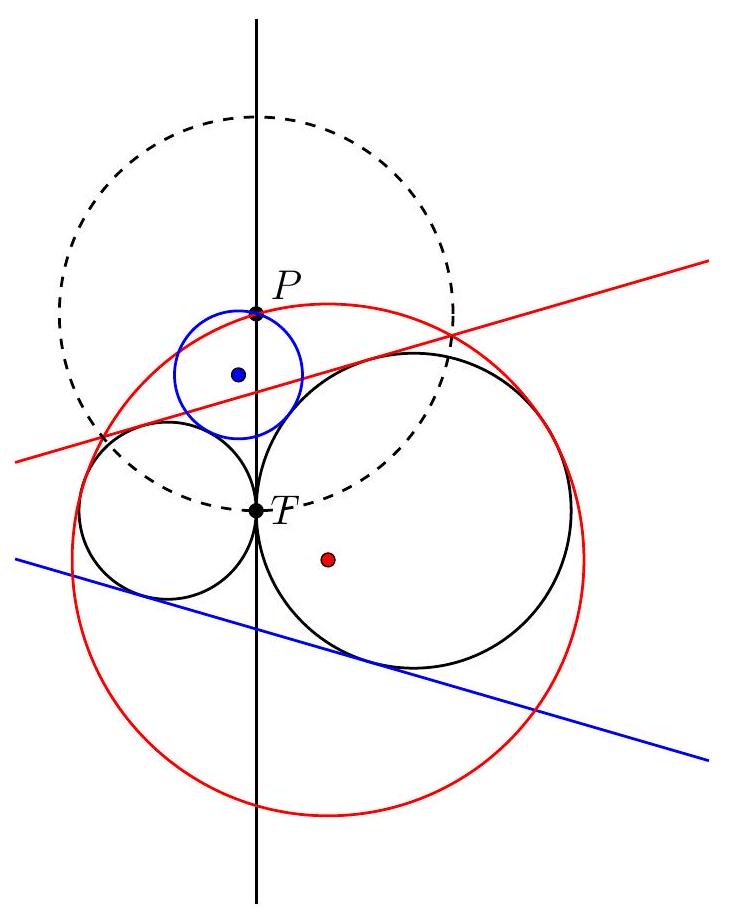
We proceed with the construction with the aid of some macro constructions that will be detailed later.
Step 1. Draw the common tangents to $\Gamma_{1}$ and $\Gamma_{2}$.
Step 2. For each common tangent $t$, draw the projection $P_{t}$ of $P$ onto $t$.
Step 3. Find the inverse $P_{1}$ of $P_{t}$ with respect to the circle with center $P$ and radius $P T$.
Step 4. $\omega_{t}$ is the circle with diameter $P P_{1}$.
Let's work out the details for steps 1 and 3 . Steps 2 and 4 are immediate.
Step 1. In this particular case in which $\Gamma_{1}$ and $\Gamma_{2}$ are externally tangent, there is a small shortcut:
- Draw the circle with diameter on the two centers $O_{1}$ of $\Gamma_{1}$ and $O_{2}$ of $\Gamma_{2}$, and find its center $O$.
- Let this circle meet common tangent line $O P$ at points $Q, R$. The required lines are the perpendicular to $O Q$ at $Q$ and the perpendicular to $O R$ at $R$.
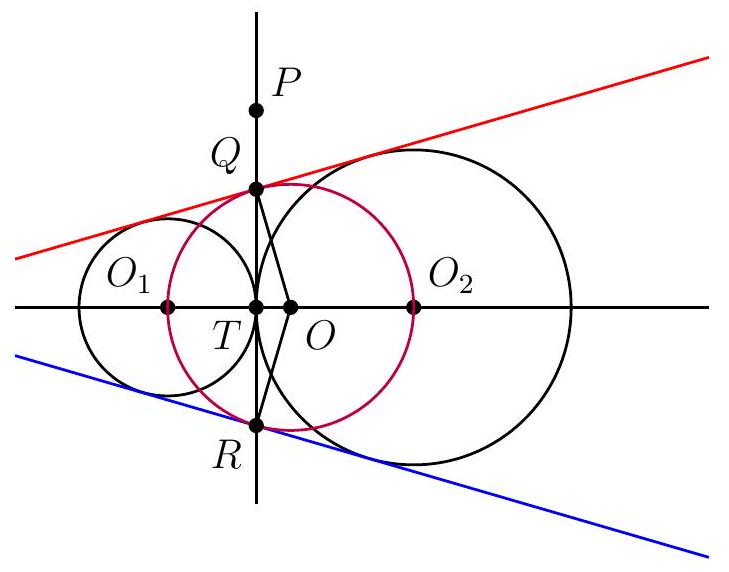
Let's show why this construction works. Let $R_{i}$ be the radius of circle $\Gamma_{i}$ and suppose without loss of generality that $R_{1} \leq R_{2}$. Note that $O Q=\frac{1}{2} O_{1} O_{2}=\frac{R_{1}+R_{2}}{2}, O T=O O_{1}-R_{1}=\frac{R_{2}-R_{1}}{2}$, so
$$
\sin \angle T Q O=\frac{O T}{O Q}=\frac{R_{2}-R_{1}}{R_{1}+R_{2}}
$$
which is also the sine of the angle between $O_{1} O_{2}$ and the common tangent lines.
Let $t$ be the perpendicular to $O Q$ through $Q$. Then $\angle\left(t, O_{1} O_{2}\right)=\angle(O Q, Q T)=\angle T Q O$, and $t$ is parallel to a common tangent line. Since
$$
d(O, t)=O Q=\frac{R_{1}+R_{2}}{2}=\frac{d\left(O_{1}, t\right)+d\left(O_{2}, t\right)}{2}
$$
and $O$ is the midpoint of $O_{1} O_{2}, O$ is also at the same distance from $t$ and the common tangent line, so these two lines coincide.
Step 3. Finding the inverse of a point $X$ given the inversion circle $\Omega$ with center $O$ is a well known procedure, but we describe it here for the sake of completeness.
- If $X$ lies in $\Omega$, then its inverse is $X$.
- If $X$ lies in the interior of $\Omega$, draw ray $O X$, then the perpendicular line $\ell$ to $O X$ at $X$. Let $\ell$ meet $\Omega$ at a point $Y$. The inverse of $X$ is the intersection $X^{\prime}$ of $O X$ and the line perpendicular to $O Y$ at $Y$. This is because $O Y X^{\prime}$ is a right triangle with altitude $Y X$, and therefore $O X \cdot O X^{\prime}=O Y^{2}$.
- If $X$ is in the exterior of $\Omega$, draw ray $O X$ and one of the tangent lines $\ell$ from $X$ to $\Omega$ (just connect $X$ to one of the intersections of $\Omega$ and the circle with diameter $O X$ ). Let $\ell$ touch $\Omega$ at a point $Y$. The inverse of $X$ is the projection $X^{\prime}$ of $Y$ onto $O X$. This is because $O Y X^{\prime}$ is a right triangle with altitude $Y X^{\prime}$, and therefore $O X \cdot O X^{\prime}=O Y^{2}$.
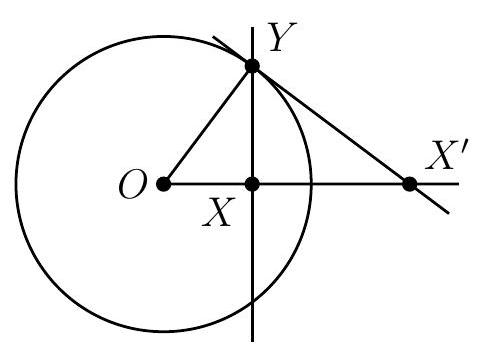
$X$ is inside $\Omega$
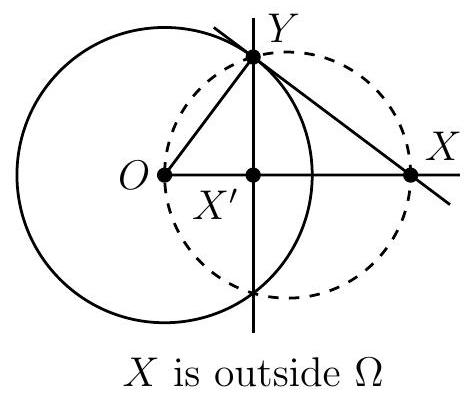
|
not found
|
Yes
|
Yes
|
math-word-problem
|
Geometry
|
Given are two tangent circles and a point $P$ on their common tangent perpendicular to the lines joining their centres. Construct with ruler and compass all the circles that are tangent to these two circles and pass through the point $P$.
|
Throughout this problem, we will assume that the given circles are externally tangent, since the problem does not have a solution otherwise.
Let $\Gamma_{1}$ and $\Gamma_{2}$ be the given circles and $T$ be their tangency point. Suppose $\omega$ is a circle that is tangent to $\Gamma_{1}$ and $\Gamma_{2}$ and passes through $P$.
Now invert about point $P$, with radius $P T$. Let any line through $P$ that cuts $\Gamma_{1}$ do so at points $X$ and $Y$. The power of $P$ with respect to $\Gamma_{1}$ is $P T^{2}=P X \cdot P Y$, so $X$ and $Y$ are swapped by this inversion. Therefore $\Gamma_{1}$ is mapped to itself in this inversion. The same applies to $\Gamma_{2}$. Since circle $\omega$ passes through $P$, it is mapped to a line tangent to the images of $\Gamma_{1}$ (itself) and $\Gamma_{2}$ (also itself), that is, a common tangent line. This common tangent cannot be $P T$, as $P T$ is also mapped to itself. Since $\Gamma_{1}$ and $\Gamma_{2}$ have exactly other two common tangent lines, there are two solutions: the inverses of the tangent lines.

We proceed with the construction with the aid of some macro constructions that will be detailed later.
Step 1. Draw the common tangents to $\Gamma_{1}$ and $\Gamma_{2}$.
Step 2. For each common tangent $t$, draw the projection $P_{t}$ of $P$ onto $t$.
Step 3. Find the inverse $P_{1}$ of $P_{t}$ with respect to the circle with center $P$ and radius $P T$.
Step 4. $\omega_{t}$ is the circle with diameter $P P_{1}$.
Let's work out the details for steps 1 and 3 . Steps 2 and 4 are immediate.
Step 1. In this particular case in which $\Gamma_{1}$ and $\Gamma_{2}$ are externally tangent, there is a small shortcut:
- Draw the circle with diameter on the two centers $O_{1}$ of $\Gamma_{1}$ and $O_{2}$ of $\Gamma_{2}$, and find its center $O$.
- Let this circle meet common tangent line $O P$ at points $Q, R$. The required lines are the perpendicular to $O Q$ at $Q$ and the perpendicular to $O R$ at $R$.

Let's show why this construction works. Let $R_{i}$ be the radius of circle $\Gamma_{i}$ and suppose without loss of generality that $R_{1} \leq R_{2}$. Note that $O Q=\frac{1}{2} O_{1} O_{2}=\frac{R_{1}+R_{2}}{2}, O T=O O_{1}-R_{1}=\frac{R_{2}-R_{1}}{2}$, so
$$
\sin \angle T Q O=\frac{O T}{O Q}=\frac{R_{2}-R_{1}}{R_{1}+R_{2}}
$$
which is also the sine of the angle between $O_{1} O_{2}$ and the common tangent lines.
Let $t$ be the perpendicular to $O Q$ through $Q$. Then $\angle\left(t, O_{1} O_{2}\right)=\angle(O Q, Q T)=\angle T Q O$, and $t$ is parallel to a common tangent line. Since
$$
d(O, t)=O Q=\frac{R_{1}+R_{2}}{2}=\frac{d\left(O_{1}, t\right)+d\left(O_{2}, t\right)}{2}
$$
and $O$ is the midpoint of $O_{1} O_{2}, O$ is also at the same distance from $t$ and the common tangent line, so these two lines coincide.
Step 3. Finding the inverse of a point $X$ given the inversion circle $\Omega$ with center $O$ is a well known procedure, but we describe it here for the sake of completeness.
- If $X$ lies in $\Omega$, then its inverse is $X$.
- If $X$ lies in the interior of $\Omega$, draw ray $O X$, then the perpendicular line $\ell$ to $O X$ at $X$. Let $\ell$ meet $\Omega$ at a point $Y$. The inverse of $X$ is the intersection $X^{\prime}$ of $O X$ and the line perpendicular to $O Y$ at $Y$. This is because $O Y X^{\prime}$ is a right triangle with altitude $Y X$, and therefore $O X \cdot O X^{\prime}=O Y^{2}$.
- If $X$ is in the exterior of $\Omega$, draw ray $O X$ and one of the tangent lines $\ell$ from $X$ to $\Omega$ (just connect $X$ to one of the intersections of $\Omega$ and the circle with diameter $O X$ ). Let $\ell$ touch $\Omega$ at a point $Y$. The inverse of $X$ is the projection $X^{\prime}$ of $Y$ onto $O X$. This is because $O Y X^{\prime}$ is a right triangle with altitude $Y X^{\prime}$, and therefore $O X \cdot O X^{\prime}=O Y^{2}$.

$X$ is inside $\Omega$

|
{
"resource_path": "APMO/segmented/en-apmo1991_sol.jsonl",
"problem_match": "# Problem 5",
"solution_match": "# Solution\n\n"
}
|
e08fa1d8-2748-596d-8b32-52ceb4733c10
| 604,414 |
A triangle with sides $a, b$, and $c$ is given. Denote by $s$ the semiperimeter, that is $s=(a+b+c) / 2$. Construct a triangle with sides $s-a, s-b$, and $s-c$. This process is repeated until a triangle can no longer be constructed with the sidelengths given.
For which original triangles can this process be repeated indefinitely?
Answer: Only equilateral triangles.
|
The perimeter of each new triangle constructed by the process is $(s-a)+(s-b)+(s-c)=$ $3 s-(a+b+c)=3 s-2 s=s$, that is, it is halved. Consider a new equivalent process in which a similar triangle with sidelengths $2(s-a), 2(s-b), 2(s-c)$ is constructed, so the perimeter is kept invariant.
Suppose without loss of generality that $a \leq b \leq c$. Then $2(s-c) \leq 2(s-b) \leq 2(s-a)$, and the difference between the largest side and the smallest side changes from $c-a$ to $2(s-a)-2(s-c)=$ $2(c-a)$, that is, it doubles. Therefore, if $c-a>0$ then eventually this difference becomes larger than $a+b+c$, and it's immediate that a triangle cannot be constructed with the sidelengths. Hence the only possibility is $c-a=0 \Longrightarrow a=b=c$, and it is clear that equilateral triangles can yield an infinite process, because all generated triangles are equilateral.
|
a=b=c
|
Yes
|
Yes
|
math-word-problem
|
Geometry
|
A triangle with sides $a, b$, and $c$ is given. Denote by $s$ the semiperimeter, that is $s=(a+b+c) / 2$. Construct a triangle with sides $s-a, s-b$, and $s-c$. This process is repeated until a triangle can no longer be constructed with the sidelengths given.
For which original triangles can this process be repeated indefinitely?
Answer: Only equilateral triangles.
|
The perimeter of each new triangle constructed by the process is $(s-a)+(s-b)+(s-c)=$ $3 s-(a+b+c)=3 s-2 s=s$, that is, it is halved. Consider a new equivalent process in which a similar triangle with sidelengths $2(s-a), 2(s-b), 2(s-c)$ is constructed, so the perimeter is kept invariant.
Suppose without loss of generality that $a \leq b \leq c$. Then $2(s-c) \leq 2(s-b) \leq 2(s-a)$, and the difference between the largest side and the smallest side changes from $c-a$ to $2(s-a)-2(s-c)=$ $2(c-a)$, that is, it doubles. Therefore, if $c-a>0$ then eventually this difference becomes larger than $a+b+c$, and it's immediate that a triangle cannot be constructed with the sidelengths. Hence the only possibility is $c-a=0 \Longrightarrow a=b=c$, and it is clear that equilateral triangles can yield an infinite process, because all generated triangles are equilateral.
|
{
"resource_path": "APMO/segmented/en-apmo1992_sol.jsonl",
"problem_match": "# Problem 1",
"solution_match": "# Solution\n\n"
}
|
ef5f9a15-b67b-5b8e-aed5-0dfe296290a9
| 604,428 |
In a circle $C$ with centre $O$ and radius $r$, let $C_{1}, C_{2}$ be two circles with centres $O_{1}, O_{2}$ and radii $r_{1}, r_{2}$ respectively, so that each circle $C_{i}$ is internally tangent to $C$ at $A_{i}$ and so that $C_{1}, C_{2}$ are externally tangent to each other at $A$.
Prove that the three lines $O A, O_{1} A_{2}$, and $O_{2} A_{1}$ are concurrent.
|
Because of the tangencies, the following triples of points (two centers and a tangency point) are collinear:
$$
O_{1} ; O_{2} ; A, \quad O ; O_{1} ; A_{1}, \quad O ; O_{2} ; A_{2}
$$
Because of that we can ignore the circles and only draw their centers and tangency points.
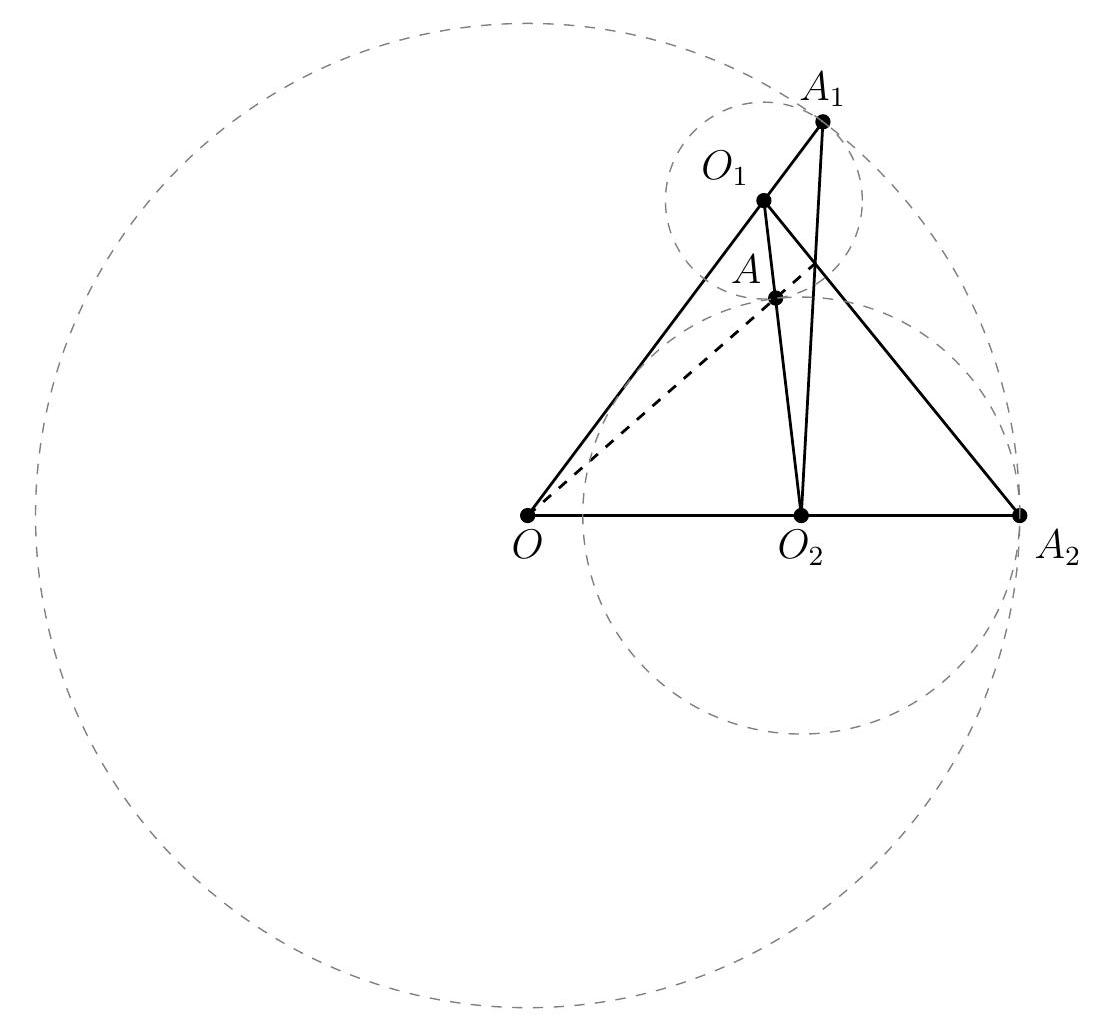
Now the problem is immediate from Ceva's theorem in triangle $O O_{1} O_{2}$, because
$$
\frac{O A_{1}}{A_{1} O_{1}} \cdot \frac{O_{1} A}{A O_{2}} \cdot \frac{O_{2} A_{2}}{A_{2} O}=\frac{r}{r_{1}} \cdot \frac{r_{1}}{r_{2}} \cdot \frac{r_{2}}{r}=1
$$
|
proof
|
Yes
|
Yes
|
proof
|
Geometry
|
In a circle $C$ with centre $O$ and radius $r$, let $C_{1}, C_{2}$ be two circles with centres $O_{1}, O_{2}$ and radii $r_{1}, r_{2}$ respectively, so that each circle $C_{i}$ is internally tangent to $C$ at $A_{i}$ and so that $C_{1}, C_{2}$ are externally tangent to each other at $A$.
Prove that the three lines $O A, O_{1} A_{2}$, and $O_{2} A_{1}$ are concurrent.
|
Because of the tangencies, the following triples of points (two centers and a tangency point) are collinear:
$$
O_{1} ; O_{2} ; A, \quad O ; O_{1} ; A_{1}, \quad O ; O_{2} ; A_{2}
$$
Because of that we can ignore the circles and only draw their centers and tangency points.

Now the problem is immediate from Ceva's theorem in triangle $O O_{1} O_{2}$, because
$$
\frac{O A_{1}}{A_{1} O_{1}} \cdot \frac{O_{1} A}{A O_{2}} \cdot \frac{O_{2} A_{2}}{A_{2} O}=\frac{r}{r_{1}} \cdot \frac{r_{1}}{r_{2}} \cdot \frac{r_{2}}{r}=1
$$
|
{
"resource_path": "APMO/segmented/en-apmo1992_sol.jsonl",
"problem_match": "# Problem 2",
"solution_match": "# Solution\n\n"
}
|
ffb81a07-18b5-55d8-b41e-205d7c2461c9
| 604,440 |
Let $n$ be an integer such that $n>3$. Suppose that we choose three numbers from the set $\{1,2, \ldots, n\}$. Using each of these three numbers only once and using addition, multiplication, and parenthesis, let us form all possible combinations.
(a) Show that if we choose all three numbers greater than $n / 2$, then the values of these combinations are all distinct.
(b) Let $p$ be a prime number such that $p \leq \sqrt{n}$. Show that the number of ways of choosing three numbers so that the smallest one is $p$ and the values of the combinations are not all distinct is precisely the number of positive divisors of $p-1$.
|
In both items, the smallest chosen number is at least 2: in part (a), $n / 2>1$ and in part (b), $p$ is a prime. So let $1<x<y<z$ be the chosen numbers. Then all possible combinations are
$$
x+y+z, \quad x+y z, \quad x y+z, \quad y+z x, \quad(x+y) z, \quad(z+x) y, \quad(x+y) z, \quad x y z
$$
Since, for $1<m<n$ and $t>1,(m-1)(n-1) \geq 1 \cdot 2 \Longrightarrow m n>m+n, t n+m-(t m+n)=$ $(t-1)(n-m)>0 \Longrightarrow t n+m>t m+n$, and $(t+m) n-(t+n) m=t(n-m)>0$,
$$
x+y+z<z+x y<y+z x<x+y z
$$
and
$$
(y+z) x<(x+z) y<(x+y) z<x y z .
$$
Also, $(y+z) x-(y+z x)=(x-1) y>0 \Longrightarrow(y+z) x>y+z x$ and $(x+z) y-(x+y z)=$ $(y-1) x>0 \Longrightarrow(x+z) y>x+y z$. Therefore the only numbers that can be equal are $x+y z$ and $(y+z) x$. In this case,
$$
x+y z=(y+z) x \Longleftrightarrow(y-x)(z-x)=x(x-1)
$$
Now we can solve the items.
(a) if $n / 2<x<y<z$ then $z-x<n / 2$, and since $y-x<z-x, y-x<n / 2-1$; then
$$
(y-x)(z-x)<\frac{n}{2}\left(\frac{n}{2}-1\right)<x(x-1)
$$
and therefore $x+y z<(y+z) x$.
(b) if $x=p$, then $(y-p)(z-p)=p(p-1)$. Since $y-p<z-p,(y-p)^{2}<(y-p)(z-p)=$ $p(p-1) \Longrightarrow y-p<p$, that is, $p$ does not divide $y-p$. Then $y-p$ is a divisor $d$ of $p-1$ and $z-p=\frac{p(p-1)}{d}$. Therefore,
$$
x=p, \quad, y=p+d, \quad z=p+\frac{p(p-1)}{d}
$$
which is a solution for every divisor $d$ of $p-1$ because
$$
x=p<y=p+d<2 p \leq p+p \cdot \frac{p-1}{d}=z .
$$
Comment: If $x=1$ was allowed, then any choice $1, y, z$ would have repeated numbers in the combination, as $1 \cdot y+z=y+1 \cdot z$.
|
proof
|
Yes
|
Yes
|
proof
|
Number Theory
|
Let $n$ be an integer such that $n>3$. Suppose that we choose three numbers from the set $\{1,2, \ldots, n\}$. Using each of these three numbers only once and using addition, multiplication, and parenthesis, let us form all possible combinations.
(a) Show that if we choose all three numbers greater than $n / 2$, then the values of these combinations are all distinct.
(b) Let $p$ be a prime number such that $p \leq \sqrt{n}$. Show that the number of ways of choosing three numbers so that the smallest one is $p$ and the values of the combinations are not all distinct is precisely the number of positive divisors of $p-1$.
|
In both items, the smallest chosen number is at least 2: in part (a), $n / 2>1$ and in part (b), $p$ is a prime. So let $1<x<y<z$ be the chosen numbers. Then all possible combinations are
$$
x+y+z, \quad x+y z, \quad x y+z, \quad y+z x, \quad(x+y) z, \quad(z+x) y, \quad(x+y) z, \quad x y z
$$
Since, for $1<m<n$ and $t>1,(m-1)(n-1) \geq 1 \cdot 2 \Longrightarrow m n>m+n, t n+m-(t m+n)=$ $(t-1)(n-m)>0 \Longrightarrow t n+m>t m+n$, and $(t+m) n-(t+n) m=t(n-m)>0$,
$$
x+y+z<z+x y<y+z x<x+y z
$$
and
$$
(y+z) x<(x+z) y<(x+y) z<x y z .
$$
Also, $(y+z) x-(y+z x)=(x-1) y>0 \Longrightarrow(y+z) x>y+z x$ and $(x+z) y-(x+y z)=$ $(y-1) x>0 \Longrightarrow(x+z) y>x+y z$. Therefore the only numbers that can be equal are $x+y z$ and $(y+z) x$. In this case,
$$
x+y z=(y+z) x \Longleftrightarrow(y-x)(z-x)=x(x-1)
$$
Now we can solve the items.
(a) if $n / 2<x<y<z$ then $z-x<n / 2$, and since $y-x<z-x, y-x<n / 2-1$; then
$$
(y-x)(z-x)<\frac{n}{2}\left(\frac{n}{2}-1\right)<x(x-1)
$$
and therefore $x+y z<(y+z) x$.
(b) if $x=p$, then $(y-p)(z-p)=p(p-1)$. Since $y-p<z-p,(y-p)^{2}<(y-p)(z-p)=$ $p(p-1) \Longrightarrow y-p<p$, that is, $p$ does not divide $y-p$. Then $y-p$ is a divisor $d$ of $p-1$ and $z-p=\frac{p(p-1)}{d}$. Therefore,
$$
x=p, \quad, y=p+d, \quad z=p+\frac{p(p-1)}{d}
$$
which is a solution for every divisor $d$ of $p-1$ because
$$
x=p<y=p+d<2 p \leq p+p \cdot \frac{p-1}{d}=z .
$$
Comment: If $x=1$ was allowed, then any choice $1, y, z$ would have repeated numbers in the combination, as $1 \cdot y+z=y+1 \cdot z$.
|
{
"resource_path": "APMO/segmented/en-apmo1992_sol.jsonl",
"problem_match": "# Problem 3",
"solution_match": "# Solution\n\n"
}
|
b52e4aa1-0199-5e11-88b8-bb3a94eec199
| 604,457 |
Determine all pairs $(h, s)$ of positive integers with the following property: If one draws $h$ horizontal lines and another $s$ lines which satisfy
(i) they are not horizontal,
(ii) no two of them are parallel,
(iii) no three of the $h+s$ lines are concurrent,
then the number of regions formed by these $h+s$ lines is 1992 .
Answer: $(995,1),(176,10)$, and $(80,21)$.
|
Let $a_{h, s}$ the number of regions formed by $h$ horizontal lines and $s$ another lines as described in the problem. Let $\mathcal{F}_{h, s}$ be the union of the $h+s$ lines and pick any line $\ell$. If it intersects the other lines in $n$ (distinct!) points then $\ell$ is partitioned into $n-1$ line segments and 2 rays, which delimit regions. Therefore if we remove $\ell$ the number of regions decreases by exactly $n-1+2=n+1$.
Then $a_{0,0}=1$ (no lines means there is only one region), and since every one of $s$ lines intersects the other $s-1$ lines, $a_{0, s}=a_{0, s-1}+s$ for $s \geq 0$. Summing yields
$$
a_{0, s}=s+(s-1)+\cdots+1+a_{0,0}=\frac{s^{2}+s+2}{2} .
$$
Each horizontal line only intersects the $s$ non-horizontal lines, so $a_{h, s}=a_{h-1, s}+s+1$, which implies
$$
a_{h, s}=a_{0, s}+h(s+1)=\frac{s^{2}+s+2}{2}+h(s+1) .
$$
Our final task is solving
$$
a_{h, s}=1992 \Longleftrightarrow \frac{s^{2}+s+2}{2}+h(s+1)=1992 \Longleftrightarrow(s+1)(s+2 h)=2 \cdot 1991=2 \cdot 11 \cdot 181
$$
The divisors of $2 \cdot 1991$ are $1,2,11,22,181,362,1991,3982$. Since $s, h>0,2 \leq s+1<s+2 h$, so the possibilities for $s+1$ can only be 2,11 and 22 , yielding the following possibilities for $(h, s)$ :
$$
(995,1), \quad(176,10), \quad \text { and }(80,21) .
$$
|
(995,1), (176,10), (80,21)
|
Yes
|
Yes
|
math-word-problem
|
Combinatorics
|
Determine all pairs $(h, s)$ of positive integers with the following property: If one draws $h$ horizontal lines and another $s$ lines which satisfy
(i) they are not horizontal,
(ii) no two of them are parallel,
(iii) no three of the $h+s$ lines are concurrent,
then the number of regions formed by these $h+s$ lines is 1992 .
Answer: $(995,1),(176,10)$, and $(80,21)$.
|
Let $a_{h, s}$ the number of regions formed by $h$ horizontal lines and $s$ another lines as described in the problem. Let $\mathcal{F}_{h, s}$ be the union of the $h+s$ lines and pick any line $\ell$. If it intersects the other lines in $n$ (distinct!) points then $\ell$ is partitioned into $n-1$ line segments and 2 rays, which delimit regions. Therefore if we remove $\ell$ the number of regions decreases by exactly $n-1+2=n+1$.
Then $a_{0,0}=1$ (no lines means there is only one region), and since every one of $s$ lines intersects the other $s-1$ lines, $a_{0, s}=a_{0, s-1}+s$ for $s \geq 0$. Summing yields
$$
a_{0, s}=s+(s-1)+\cdots+1+a_{0,0}=\frac{s^{2}+s+2}{2} .
$$
Each horizontal line only intersects the $s$ non-horizontal lines, so $a_{h, s}=a_{h-1, s}+s+1$, which implies
$$
a_{h, s}=a_{0, s}+h(s+1)=\frac{s^{2}+s+2}{2}+h(s+1) .
$$
Our final task is solving
$$
a_{h, s}=1992 \Longleftrightarrow \frac{s^{2}+s+2}{2}+h(s+1)=1992 \Longleftrightarrow(s+1)(s+2 h)=2 \cdot 1991=2 \cdot 11 \cdot 181
$$
The divisors of $2 \cdot 1991$ are $1,2,11,22,181,362,1991,3982$. Since $s, h>0,2 \leq s+1<s+2 h$, so the possibilities for $s+1$ can only be 2,11 and 22 , yielding the following possibilities for $(h, s)$ :
$$
(995,1), \quad(176,10), \quad \text { and }(80,21) .
$$
|
{
"resource_path": "APMO/segmented/en-apmo1992_sol.jsonl",
"problem_match": "# Problem 4",
"solution_match": "# Solution\n\n"
}
|
ae9a860d-e440-5433-b4ef-89a69c0b2eef
| 604,469 |
Find a sequence of maximal length consisting of non-zero integers in which the sum of any seven consecutive terms is positive and that of any eleven consecutive terms is negative.
Answer: The maximum length is 16 . There are several possible sequences with this length; one such sequence is $(-7,-7,18,-7,-7,-7,18,-7,-7,18,-7,-7,-7,18,-7,-7)$.
|
Suppose it is possible to have more than 16 terms in the sequence. Let $a_{1}, a_{2}, \ldots, a_{17}$ be the first 17 terms of the sequence. Consider the following array of terms in the sequence:
| $a_{1}$ | $a_{2}$ | $a_{3}$ | $a_{4}$ | $a_{5}$ | $a_{6}$ | $a_{7}$ | $a_{8}$ | $a_{9}$ | $a_{10}$ | $a_{11}$ |
| :---: | :---: | :---: | :---: | :---: | :---: | :---: | :---: | :---: | :---: | :---: |
| $a_{2}$ | $a_{3}$ | $a_{4}$ | $a_{5}$ | $a_{6}$ | $a_{7}$ | $a_{8}$ | $a_{9}$ | $a_{10}$ | $a_{11}$ | $a_{12}$ |
| $a_{3}$ | $a_{4}$ | $a_{5}$ | $a_{6}$ | $a_{7}$ | $a_{8}$ | $a_{9}$ | $a_{10}$ | $a_{11}$ | $a_{12}$ | $a_{13}$ |
| $a_{4}$ | $a_{5}$ | $a_{6}$ | $a_{7}$ | $a_{8}$ | $a_{9}$ | $a_{10}$ | $a_{11}$ | $a_{12}$ | $a_{13}$ | $a_{14}$ |
| $a_{5}$ | $a_{6}$ | $a_{7}$ | $a_{8}$ | $a_{9}$ | $a_{10}$ | $a_{11}$ | $a_{12}$ | $a_{13}$ | $a_{14}$ | $a_{15}$ |
| $a_{6}$ | $a_{7}$ | $a_{8}$ | $a_{9}$ | $a_{10}$ | $a_{11}$ | $a_{12}$ | $a_{13}$ | $a_{14}$ | $a_{15}$ | $a_{16}$ |
| $a_{7}$ | $a_{8}$ | $a_{9}$ | $a_{10}$ | $a_{11}$ | $a_{12}$ | $a_{13}$ | $a_{14}$ | $a_{15}$ | $a_{16}$ | $a_{17}$ |
Let $S$ the sum of the numbers in the array. If we sum by rows we obtain negative sums in each row, so $S<0$; however, it we sum by columns we obtain positive sums in each column, so $S>0$, a contradiction. This implies that the sequence cannot have more than 16 terms. One idea to find a suitable sequence with 16 terms is considering cycles of 7 numbers. For instance, one can try
$$
-a,-a, b,-a,-a,-a, b,-a,-a, b,-a,-a,-a, b,-a,-a .
$$
The sum of every seven consecutive numbers is $-5 a+2 b$ and the sum of every eleven consecutive numbers is $-8 a+3 b$, so $-5 a+2 b>0$ and $-8 a+3 b<0$, that is,
$$
\frac{5 a}{2}<b<\frac{8 a}{3} \Longleftrightarrow 15 a<6 b<16 a
$$
Then we can choose, say, $a=7$ and $105<6 b<112 \Longleftrightarrow b=18$. A valid sequence is then
$$
-7,-7,18,-7,-7,-7,18,-7,-7,18,-7,-7,-7,18,-7,-7
$$
|
-7,-7,18,-7,-7,-7,18,-7,-7,18,-7,-7,-7,18,-7,-7
|
Yes
|
Yes
|
math-word-problem
|
Combinatorics
|
Find a sequence of maximal length consisting of non-zero integers in which the sum of any seven consecutive terms is positive and that of any eleven consecutive terms is negative.
Answer: The maximum length is 16 . There are several possible sequences with this length; one such sequence is $(-7,-7,18,-7,-7,-7,18,-7,-7,18,-7,-7,-7,18,-7,-7)$.
|
Suppose it is possible to have more than 16 terms in the sequence. Let $a_{1}, a_{2}, \ldots, a_{17}$ be the first 17 terms of the sequence. Consider the following array of terms in the sequence:
| $a_{1}$ | $a_{2}$ | $a_{3}$ | $a_{4}$ | $a_{5}$ | $a_{6}$ | $a_{7}$ | $a_{8}$ | $a_{9}$ | $a_{10}$ | $a_{11}$ |
| :---: | :---: | :---: | :---: | :---: | :---: | :---: | :---: | :---: | :---: | :---: |
| $a_{2}$ | $a_{3}$ | $a_{4}$ | $a_{5}$ | $a_{6}$ | $a_{7}$ | $a_{8}$ | $a_{9}$ | $a_{10}$ | $a_{11}$ | $a_{12}$ |
| $a_{3}$ | $a_{4}$ | $a_{5}$ | $a_{6}$ | $a_{7}$ | $a_{8}$ | $a_{9}$ | $a_{10}$ | $a_{11}$ | $a_{12}$ | $a_{13}$ |
| $a_{4}$ | $a_{5}$ | $a_{6}$ | $a_{7}$ | $a_{8}$ | $a_{9}$ | $a_{10}$ | $a_{11}$ | $a_{12}$ | $a_{13}$ | $a_{14}$ |
| $a_{5}$ | $a_{6}$ | $a_{7}$ | $a_{8}$ | $a_{9}$ | $a_{10}$ | $a_{11}$ | $a_{12}$ | $a_{13}$ | $a_{14}$ | $a_{15}$ |
| $a_{6}$ | $a_{7}$ | $a_{8}$ | $a_{9}$ | $a_{10}$ | $a_{11}$ | $a_{12}$ | $a_{13}$ | $a_{14}$ | $a_{15}$ | $a_{16}$ |
| $a_{7}$ | $a_{8}$ | $a_{9}$ | $a_{10}$ | $a_{11}$ | $a_{12}$ | $a_{13}$ | $a_{14}$ | $a_{15}$ | $a_{16}$ | $a_{17}$ |
Let $S$ the sum of the numbers in the array. If we sum by rows we obtain negative sums in each row, so $S<0$; however, it we sum by columns we obtain positive sums in each column, so $S>0$, a contradiction. This implies that the sequence cannot have more than 16 terms. One idea to find a suitable sequence with 16 terms is considering cycles of 7 numbers. For instance, one can try
$$
-a,-a, b,-a,-a,-a, b,-a,-a, b,-a,-a,-a, b,-a,-a .
$$
The sum of every seven consecutive numbers is $-5 a+2 b$ and the sum of every eleven consecutive numbers is $-8 a+3 b$, so $-5 a+2 b>0$ and $-8 a+3 b<0$, that is,
$$
\frac{5 a}{2}<b<\frac{8 a}{3} \Longleftrightarrow 15 a<6 b<16 a
$$
Then we can choose, say, $a=7$ and $105<6 b<112 \Longleftrightarrow b=18$. A valid sequence is then
$$
-7,-7,18,-7,-7,-7,18,-7,-7,18,-7,-7,-7,18,-7,-7
$$
|
{
"resource_path": "APMO/segmented/en-apmo1992_sol.jsonl",
"problem_match": "# Problem 5",
"solution_match": "# Solution\n\n"
}
|
afbefb89-afc4-50d1-ab7a-33f76685ff2e
| 604,481 |
Let $A B C D$ be a quadrilateral such that all sides have equal length and angle $\angle A B C$ is 60 degrees. Let $\ell$ be a line passing through $D$ and not intersecting the quadrilateral (except at $D)$. Let $E$ and $F$ be the points of intersection of $\ell$ with $A B$ and $B C$ respectively. Let $M$ be the point of intersection of $C E$ and $A F$.
Prove that $C A^{2}=C M \times C E$.
|
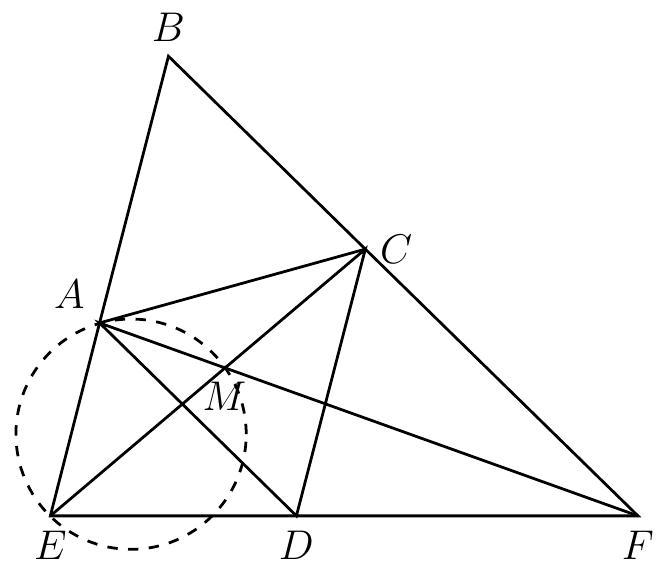
Triangles $A E D$ and $C D F$ are similar, because $A D \| C F$ and $A E \| C D$. Thus, since $A B C$ and $A C D$ are equilateral triangles,
$$
\frac{A E}{C D}=\frac{A D}{C F} \Longleftrightarrow \frac{A E}{A C}=\frac{A C}{C F}
$$
The last equality combined with
$$
\angle E A C=180^{\circ}-\angle B A C=120^{\circ}=\angle A C F
$$
shows that triangles $E A C$ and $A C F$ are also similar. Therefore $\angle C A M=\angle C A F=\angle A E C$, which implies that line $A C$ is tangent to the circumcircle of $A M E$. By the power of a point, $C A^{2}=C M \cdot C E$, and we are done.
|
proof
|
Yes
|
Yes
|
proof
|
Geometry
|
Let $A B C D$ be a quadrilateral such that all sides have equal length and angle $\angle A B C$ is 60 degrees. Let $\ell$ be a line passing through $D$ and not intersecting the quadrilateral (except at $D)$. Let $E$ and $F$ be the points of intersection of $\ell$ with $A B$ and $B C$ respectively. Let $M$ be the point of intersection of $C E$ and $A F$.
Prove that $C A^{2}=C M \times C E$.
|

Triangles $A E D$ and $C D F$ are similar, because $A D \| C F$ and $A E \| C D$. Thus, since $A B C$ and $A C D$ are equilateral triangles,
$$
\frac{A E}{C D}=\frac{A D}{C F} \Longleftrightarrow \frac{A E}{A C}=\frac{A C}{C F}
$$
The last equality combined with
$$
\angle E A C=180^{\circ}-\angle B A C=120^{\circ}=\angle A C F
$$
shows that triangles $E A C$ and $A C F$ are also similar. Therefore $\angle C A M=\angle C A F=\angle A E C$, which implies that line $A C$ is tangent to the circumcircle of $A M E$. By the power of a point, $C A^{2}=C M \cdot C E$, and we are done.
|
{
"resource_path": "APMO/segmented/en-apmo1993_sol.jsonl",
"problem_match": "# Problem 1",
"solution_match": "# Solution\n\n"
}
|
93fdf523-4aa5-5c8a-9d13-256f9c9907cd
| 604,496 |
Find the total number of different integer values the function
$$
f(x)=[x]+[2 x]+\left[\frac{5 x}{3}\right]+[3 x]+[4 x]
$$
takes for real numbers $x$ with $0 \leq x \leq 100$.
Note: $[t]$ is the largest integer that does not exceed $t$.
Answer: 734.
|
Note that, since $[x+n]=[x]+n$ for any integer $n$,
$$
f(x+3)=[x+3]+[2(x+3)]+\left[\frac{5(x+3)}{3}\right]+[3(x+3)]+[4(x+3)]=f(x)+35,
$$
one only needs to investigate the interval $[0,3)$.
The numbers in this interval at which at least one of the real numbers $x, 2 x, \frac{5 x}{3}, 3 x, 4 x$ is an integer are
- $0,1,2$ for $x$;
- $\frac{n}{2}, 0 \leq n \leq 5$ for $2 x$;
- $\frac{3 n}{5}, 0 \leq n \leq 4$ for $\frac{5 x}{3}$;
- $\frac{n}{3}, 0 \leq n \leq 8$ for $3 x$;
- $\frac{n}{4}, 0 \leq n \leq 11$ for $4 x$.
Of these numbers there are
- 3 integers $(0,1,2)$;
- 3 irreducible fractions with 2 as denominator (the numerators are $1,3,5$ );
- 6 irreducible fractions with 3 as denominator (the numerators are $1,2,4,5,7,8$ );
- 6 irreducible fractions with 4 as denominator (the numerators are $1,3,5,7,9,11,13,15$ );
- 4 irreducible fractions with 5 as denominator (the numerators are 3,6,9,12).
Therefore $f(x)$ increases 22 times per interval. Since $100=33 \cdot 3+1$, there are $33 \cdot 22$ changes of value in $[0,99)$. Finally, there are 8 more changes in [99,100]: 99, 100, $99 \frac{1}{2}, 99 \frac{1}{3}, 99 \frac{2}{3}, 99 \frac{1}{4}$, $99 \frac{3}{4}, 99 \frac{3}{5}$.
The total is then $33 \cdot 22+8=734$.
Comment: A more careful inspection shows that the range of $f$ are the numbers congruent modulo 35 to one of
$$
0,1,2,4,5,6,7,11,12,13,14,16,17,18,19,23,24,25,26,28,29,30
$$
in the interval $[0, f(100)]=[0,1166]$. Since $1166 \equiv 11(\bmod 35)$, this comprises 33 cycles plus the 8 numbers in the previous list.
|
734
|
Yes
|
Yes
|
math-word-problem
|
Number Theory
|
Find the total number of different integer values the function
$$
f(x)=[x]+[2 x]+\left[\frac{5 x}{3}\right]+[3 x]+[4 x]
$$
takes for real numbers $x$ with $0 \leq x \leq 100$.
Note: $[t]$ is the largest integer that does not exceed $t$.
Answer: 734.
|
Note that, since $[x+n]=[x]+n$ for any integer $n$,
$$
f(x+3)=[x+3]+[2(x+3)]+\left[\frac{5(x+3)}{3}\right]+[3(x+3)]+[4(x+3)]=f(x)+35,
$$
one only needs to investigate the interval $[0,3)$.
The numbers in this interval at which at least one of the real numbers $x, 2 x, \frac{5 x}{3}, 3 x, 4 x$ is an integer are
- $0,1,2$ for $x$;
- $\frac{n}{2}, 0 \leq n \leq 5$ for $2 x$;
- $\frac{3 n}{5}, 0 \leq n \leq 4$ for $\frac{5 x}{3}$;
- $\frac{n}{3}, 0 \leq n \leq 8$ for $3 x$;
- $\frac{n}{4}, 0 \leq n \leq 11$ for $4 x$.
Of these numbers there are
- 3 integers $(0,1,2)$;
- 3 irreducible fractions with 2 as denominator (the numerators are $1,3,5$ );
- 6 irreducible fractions with 3 as denominator (the numerators are $1,2,4,5,7,8$ );
- 6 irreducible fractions with 4 as denominator (the numerators are $1,3,5,7,9,11,13,15$ );
- 4 irreducible fractions with 5 as denominator (the numerators are 3,6,9,12).
Therefore $f(x)$ increases 22 times per interval. Since $100=33 \cdot 3+1$, there are $33 \cdot 22$ changes of value in $[0,99)$. Finally, there are 8 more changes in [99,100]: 99, 100, $99 \frac{1}{2}, 99 \frac{1}{3}, 99 \frac{2}{3}, 99 \frac{1}{4}$, $99 \frac{3}{4}, 99 \frac{3}{5}$.
The total is then $33 \cdot 22+8=734$.
Comment: A more careful inspection shows that the range of $f$ are the numbers congruent modulo 35 to one of
$$
0,1,2,4,5,6,7,11,12,13,14,16,17,18,19,23,24,25,26,28,29,30
$$
in the interval $[0, f(100)]=[0,1166]$. Since $1166 \equiv 11(\bmod 35)$, this comprises 33 cycles plus the 8 numbers in the previous list.
|
{
"resource_path": "APMO/segmented/en-apmo1993_sol.jsonl",
"problem_match": "# Problem 2",
"solution_match": "# Solution\n\n"
}
|
bd5d8315-f23a-5686-b090-d21bea91e8e5
| 604,509 |
Let
$$
f(x)=a_{n} x^{n}+a_{n-1} x^{n-1}+\cdots+a_{0} \quad \text { and } \quad g(x)=c_{n+1} x^{n+1}+c_{n} x^{n}+\cdots+c_{0}
$$
be non-zero polynomials with real coefficients such that $g(x)=(x+r) f(x)$ for some real number $r$. If $a=\max \left(\left|a_{n}\right|, \ldots,\left|a_{0}\right|\right)$ and $c=\max \left(\left|c_{n+1}\right|, \ldots,\left|c_{0}\right|\right)$, prove that $\frac{a}{c} \leq n+1$.
|
Expanding $(x+r) f(x)$, we find that $c_{n+1}=a_{n}, c_{k}=a_{k-1}+r a_{k}$ for $k=1,2, \ldots, n$, and $c_{0}=r a_{0}$. Consider three cases:
- $r=0$. Then $c_{0}=0$ and $c_{k}=a_{k-1}$ for $k=1,2, \ldots, n$, and $a=c \Longrightarrow \frac{a}{c}=1 \leq n+1$.
- $|r| \geq 1$. Then
$$
\begin{gathered}
\left|a_{0}\right|=\left|\frac{c_{0}}{r}\right| \leq c \\
\left|a_{1}\right|=\left|\frac{c_{1}-a_{0}}{r}\right| \leq\left|c_{1}\right|+\left|a_{0}\right| \leq 2 c
\end{gathered}
$$
and inductively if $\left|a_{k}\right| \leq(k+1) c$
$$
\left|a_{k+1}\right|=\left|\frac{c_{k+1}-a_{k}}{r}\right| \leq\left|c_{k+1}\right|+\left|a_{k}\right| \leq c+(k+1) c=(k+2) c
$$
Therefore, $\left|a_{k}\right| \leq(k+1) c \leq(n+1) c$ for all $k$, and $a \leq(n+1) c \Longleftrightarrow \frac{a}{c} \leq n+1$.
- $0<|r|<1$. Now work backwards: $\left|a_{n}\right|=\left|c_{n+1}\right| \leq c$,
$$
\left|a_{n-1}\right|=\left|c_{n}-r a_{n}\right| \leq\left|c_{n}\right|+\left|r a_{n}\right|<c+c=2 c,
$$
and inductively if $\left|a_{n-k}\right| \leq(k+1) c$
$$
\left|a_{n-k-1}\right|=\left|c_{n-k}-r a_{n-k}\right| \leq\left|c_{n-k}\right|+\left|r a_{n-k}\right|<c+(k+1) c=(k+2) c .
$$
Therefore, $\left|a_{n-k}\right| \leq(k+1) c \leq(n+1) c$ for all $k$, and $a \leq(n+1) c$ again.
|
proof
|
Yes
|
Yes
|
proof
|
Algebra
|
Let
$$
f(x)=a_{n} x^{n}+a_{n-1} x^{n-1}+\cdots+a_{0} \quad \text { and } \quad g(x)=c_{n+1} x^{n+1}+c_{n} x^{n}+\cdots+c_{0}
$$
be non-zero polynomials with real coefficients such that $g(x)=(x+r) f(x)$ for some real number $r$. If $a=\max \left(\left|a_{n}\right|, \ldots,\left|a_{0}\right|\right)$ and $c=\max \left(\left|c_{n+1}\right|, \ldots,\left|c_{0}\right|\right)$, prove that $\frac{a}{c} \leq n+1$.
|
Expanding $(x+r) f(x)$, we find that $c_{n+1}=a_{n}, c_{k}=a_{k-1}+r a_{k}$ for $k=1,2, \ldots, n$, and $c_{0}=r a_{0}$. Consider three cases:
- $r=0$. Then $c_{0}=0$ and $c_{k}=a_{k-1}$ for $k=1,2, \ldots, n$, and $a=c \Longrightarrow \frac{a}{c}=1 \leq n+1$.
- $|r| \geq 1$. Then
$$
\begin{gathered}
\left|a_{0}\right|=\left|\frac{c_{0}}{r}\right| \leq c \\
\left|a_{1}\right|=\left|\frac{c_{1}-a_{0}}{r}\right| \leq\left|c_{1}\right|+\left|a_{0}\right| \leq 2 c
\end{gathered}
$$
and inductively if $\left|a_{k}\right| \leq(k+1) c$
$$
\left|a_{k+1}\right|=\left|\frac{c_{k+1}-a_{k}}{r}\right| \leq\left|c_{k+1}\right|+\left|a_{k}\right| \leq c+(k+1) c=(k+2) c
$$
Therefore, $\left|a_{k}\right| \leq(k+1) c \leq(n+1) c$ for all $k$, and $a \leq(n+1) c \Longleftrightarrow \frac{a}{c} \leq n+1$.
- $0<|r|<1$. Now work backwards: $\left|a_{n}\right|=\left|c_{n+1}\right| \leq c$,
$$
\left|a_{n-1}\right|=\left|c_{n}-r a_{n}\right| \leq\left|c_{n}\right|+\left|r a_{n}\right|<c+c=2 c,
$$
and inductively if $\left|a_{n-k}\right| \leq(k+1) c$
$$
\left|a_{n-k-1}\right|=\left|c_{n-k}-r a_{n-k}\right| \leq\left|c_{n-k}\right|+\left|r a_{n-k}\right|<c+(k+1) c=(k+2) c .
$$
Therefore, $\left|a_{n-k}\right| \leq(k+1) c \leq(n+1) c$ for all $k$, and $a \leq(n+1) c$ again.
|
{
"resource_path": "APMO/segmented/en-apmo1993_sol.jsonl",
"problem_match": "# Problem 3",
"solution_match": "# Solution\n\n"
}
|
620b5678-bb8e-5e62-b80e-3aa4b8fd846e
| 604,520 |
Determine all positive integers $n$ for which the equation
$$
x^{n}+(2+x)^{n}+(2-x)^{n}=0
$$
has an integer as a solution.
## Answer: $n=1$.
|
If $n$ is even, $x^{n}+(2+x)^{n}+(2-x)^{n}>0$, so $n$ is odd.
For $n=1$, the equation reduces to $x+(2+x)+(2-x)=0$, which has the unique solution $x=-4$.
For $n>1$, notice that $x$ is even, because $x, 2-x$, and $2+x$ have all the same parity. Let $x=2 y$, so the equation reduces to
$$
y^{n}+(1+y)^{n}+(1-y)^{n}=0 .
$$
Looking at this equation modulo 2 yields that $y+(1+y)+(1-y)=y+2$ is even, so $y$ is even. Using the factorization
$$
a^{n}+b^{n}=(a+b)\left(a^{n-1}-a^{n-2} b+\cdots+b^{n-1}\right) \quad \text { for } n \text { odd, }
$$
which has a sum of $n$ terms as the second factor, the equation is now equivalent to
$$
y^{n}+(1+y+1-y)\left((1+y)^{n-1}-(1+y)^{n-2}(1-y)+\cdots+(1-y)^{n-1}\right)=0
$$
or
$$
y^{n}=-2\left((1+y)^{n-1}-(1+y)^{n-2}(1-y)+\cdots+(1-y)^{n-1}\right) .
$$
Each of the $n$ terms in the second factor is odd, and $n$ is odd, so the second factor is odd. Therefore, $y^{n}$ has only one factor 2 , which is a contradiction to the fact that, $y$ being even, $y^{n}$ has at least $n>1$ factors 2 . Hence there are no solutions if $n>1$.
|
n=1
|
Yes
|
Yes
|
math-word-problem
|
Algebra
|
Determine all positive integers $n$ for which the equation
$$
x^{n}+(2+x)^{n}+(2-x)^{n}=0
$$
has an integer as a solution.
## Answer: $n=1$.
|
If $n$ is even, $x^{n}+(2+x)^{n}+(2-x)^{n}>0$, so $n$ is odd.
For $n=1$, the equation reduces to $x+(2+x)+(2-x)=0$, which has the unique solution $x=-4$.
For $n>1$, notice that $x$ is even, because $x, 2-x$, and $2+x$ have all the same parity. Let $x=2 y$, so the equation reduces to
$$
y^{n}+(1+y)^{n}+(1-y)^{n}=0 .
$$
Looking at this equation modulo 2 yields that $y+(1+y)+(1-y)=y+2$ is even, so $y$ is even. Using the factorization
$$
a^{n}+b^{n}=(a+b)\left(a^{n-1}-a^{n-2} b+\cdots+b^{n-1}\right) \quad \text { for } n \text { odd, }
$$
which has a sum of $n$ terms as the second factor, the equation is now equivalent to
$$
y^{n}+(1+y+1-y)\left((1+y)^{n-1}-(1+y)^{n-2}(1-y)+\cdots+(1-y)^{n-1}\right)=0
$$
or
$$
y^{n}=-2\left((1+y)^{n-1}-(1+y)^{n-2}(1-y)+\cdots+(1-y)^{n-1}\right) .
$$
Each of the $n$ terms in the second factor is odd, and $n$ is odd, so the second factor is odd. Therefore, $y^{n}$ has only one factor 2 , which is a contradiction to the fact that, $y$ being even, $y^{n}$ has at least $n>1$ factors 2 . Hence there are no solutions if $n>1$.
|
{
"resource_path": "APMO/segmented/en-apmo1993_sol.jsonl",
"problem_match": "# Problem 4",
"solution_match": "# Solution\n\n"
}
|
51da5931-dc98-5e7f-91f5-7f2175f9c9a1
| 604,531 |
Let $P_{1}, P_{2}, \ldots, P_{1993}=P_{0}$ be distinct points in the $x y$-plane with the following properties:
(i) both coordinates of $P_{i}$ are integers, for $i=1,2, \ldots, 1993$;
(ii) there is no point other than $P_{i}$ and $P_{i+1}$ on the line segment joining $P_{i}$ with $P_{i+1}$ whose coordinates are both integers, for $i=0,1, \ldots, 1992$.
Prove that for some $i, 0 \leq i \leq 1992$, there exists a point $Q$ with coordinates $\left(q_{x}, q_{y}\right)$ on the line segment joining $P_{i}$ with $P_{i+1}$ such that both $2 q_{x}$ and $2 q_{y}$ are odd integers.
|
Call a point $(x, y) \in \mathbb{Z}^{2}$ even or odd according to the parity of $x+y$. Since there are an odd number of points, there are two points $P_{i}=(a, b)$ and $P_{i+1}=(c, d), 0 \leq i \leq 1992$ with the same parity. This implies that $a+b+c+d$ is even. We claim that the midpoint of $P_{i} P_{i+1}$ is the desired point $Q$.
In fact, since $a+b+c+d=(a+c)+(b+d)$ is even, $a$ and $c$ have the same parity if and only if $b$ and $d$ also have the same parity. If both happen then the midpoint of $P_{i} P_{i+1}, Q=\left(\frac{a+c}{2}, \frac{b+d}{2}\right)$, has integer coordinates, which violates condition (ii). Then $a$ and $c$, as well as $b$ and $d$, have different parities, and $2 q_{x}=a+c$ and $2 q_{y}=b+d$ are both odd integers.
|
proof
|
Yes
|
Yes
|
proof
|
Number Theory
|
Let $P_{1}, P_{2}, \ldots, P_{1993}=P_{0}$ be distinct points in the $x y$-plane with the following properties:
(i) both coordinates of $P_{i}$ are integers, for $i=1,2, \ldots, 1993$;
(ii) there is no point other than $P_{i}$ and $P_{i+1}$ on the line segment joining $P_{i}$ with $P_{i+1}$ whose coordinates are both integers, for $i=0,1, \ldots, 1992$.
Prove that for some $i, 0 \leq i \leq 1992$, there exists a point $Q$ with coordinates $\left(q_{x}, q_{y}\right)$ on the line segment joining $P_{i}$ with $P_{i+1}$ such that both $2 q_{x}$ and $2 q_{y}$ are odd integers.
|
Call a point $(x, y) \in \mathbb{Z}^{2}$ even or odd according to the parity of $x+y$. Since there are an odd number of points, there are two points $P_{i}=(a, b)$ and $P_{i+1}=(c, d), 0 \leq i \leq 1992$ with the same parity. This implies that $a+b+c+d$ is even. We claim that the midpoint of $P_{i} P_{i+1}$ is the desired point $Q$.
In fact, since $a+b+c+d=(a+c)+(b+d)$ is even, $a$ and $c$ have the same parity if and only if $b$ and $d$ also have the same parity. If both happen then the midpoint of $P_{i} P_{i+1}, Q=\left(\frac{a+c}{2}, \frac{b+d}{2}\right)$, has integer coordinates, which violates condition (ii). Then $a$ and $c$, as well as $b$ and $d$, have different parities, and $2 q_{x}=a+c$ and $2 q_{y}=b+d$ are both odd integers.
|
{
"resource_path": "APMO/segmented/en-apmo1993_sol.jsonl",
"problem_match": "# Problem 5",
"solution_match": "# Solution\n\n"
}
|
7aa3067d-2293-5b49-8533-29510f81af65
| 604,546 |
Let $f: \mathbb{R} \rightarrow \mathbb{R}$ be a function such that
(i) For all $x, y \in \mathbb{R}$,
$$
f(x)+f(y)+1 \geq f(x+y) \geq f(x)+f(y)
$$
(ii) For all $x \in[0,1), f(0) \geq f(x)$,
(iii) $-f(-1)=f(1)=1$.
Find all such functions $f$.
Answer: $f(x)=\lfloor x\rfloor$, the largest integer that does not exceed $x$, is the only function.
|
Plug $y \rightarrow 1$ in (i):
$$
f(x)+f(1)+1 \geq f(x+1) \geq f(x)+f(1) \Longleftrightarrow f(x)+1 \leq f(x+1) \leq f(x)+2
$$
Now plug $y \rightarrow-1$ and $x \rightarrow x+1$ in (i):
$$
f(x+1)+f(-1)+1 \geq f(x) \geq f(x+1)+f(-1) \Longleftrightarrow f(x) \leq f(x+1) \leq f(x)+1
$$
Hence $f(x+1)=f(x)+1$ and we only need to define $f(x)$ on $[0,1)$. Note that $f(1)=$ $f(0)+1 \Longrightarrow f(0)=0$.
Condition (ii) states that $f(x) \leq 0$ in $[0,1)$.
Now plug $y \rightarrow 1-x$ in (i):
$$
f(x)+f(1-x)+1 \leq f(x+(1-x)) \leq f(x)+f(1-x) \Longrightarrow f(x)+f(1-x) \geq 0
$$
If $x \in(0,1)$ then $1-x \in(0,1)$ as well, so $f(x) \leq 0$ and $f(1-x) \leq 0$, which implies $f(x)+f(1-x) \leq 0$. Thus, $f(x)=f(1-x)=0$ for $x \in(0,1)$. This combined with $f(0)=0$ and $f(x+1)=f(x)+1$ proves that $f(x)=\lfloor x\rfloor$, which satisfies the problem conditions, as since
$x+y=\lfloor x\rfloor+\lfloor y\rfloor+\{x\}+\{y\}$ and $0 \leq\{x\}+\{y\}<2 \Longrightarrow\lfloor x\rfloor+\lfloor y\rfloor \leq x+y<\lfloor x\rfloor+\lfloor y\rfloor+2$ implies
$$
\lfloor x\rfloor+\lfloor y\rfloor+1 \geq\lfloor x+y\rfloor \geq\lfloor x\rfloor+\lfloor y\rfloor .
$$
|
f(x)=\lfloor x\rfloor
|
Yes
|
Yes
|
math-word-problem
|
Algebra
|
Let $f: \mathbb{R} \rightarrow \mathbb{R}$ be a function such that
(i) For all $x, y \in \mathbb{R}$,
$$
f(x)+f(y)+1 \geq f(x+y) \geq f(x)+f(y)
$$
(ii) For all $x \in[0,1), f(0) \geq f(x)$,
(iii) $-f(-1)=f(1)=1$.
Find all such functions $f$.
Answer: $f(x)=\lfloor x\rfloor$, the largest integer that does not exceed $x$, is the only function.
|
Plug $y \rightarrow 1$ in (i):
$$
f(x)+f(1)+1 \geq f(x+1) \geq f(x)+f(1) \Longleftrightarrow f(x)+1 \leq f(x+1) \leq f(x)+2
$$
Now plug $y \rightarrow-1$ and $x \rightarrow x+1$ in (i):
$$
f(x+1)+f(-1)+1 \geq f(x) \geq f(x+1)+f(-1) \Longleftrightarrow f(x) \leq f(x+1) \leq f(x)+1
$$
Hence $f(x+1)=f(x)+1$ and we only need to define $f(x)$ on $[0,1)$. Note that $f(1)=$ $f(0)+1 \Longrightarrow f(0)=0$.
Condition (ii) states that $f(x) \leq 0$ in $[0,1)$.
Now plug $y \rightarrow 1-x$ in (i):
$$
f(x)+f(1-x)+1 \leq f(x+(1-x)) \leq f(x)+f(1-x) \Longrightarrow f(x)+f(1-x) \geq 0
$$
If $x \in(0,1)$ then $1-x \in(0,1)$ as well, so $f(x) \leq 0$ and $f(1-x) \leq 0$, which implies $f(x)+f(1-x) \leq 0$. Thus, $f(x)=f(1-x)=0$ for $x \in(0,1)$. This combined with $f(0)=0$ and $f(x+1)=f(x)+1$ proves that $f(x)=\lfloor x\rfloor$, which satisfies the problem conditions, as since
$x+y=\lfloor x\rfloor+\lfloor y\rfloor+\{x\}+\{y\}$ and $0 \leq\{x\}+\{y\}<2 \Longrightarrow\lfloor x\rfloor+\lfloor y\rfloor \leq x+y<\lfloor x\rfloor+\lfloor y\rfloor+2$ implies
$$
\lfloor x\rfloor+\lfloor y\rfloor+1 \geq\lfloor x+y\rfloor \geq\lfloor x\rfloor+\lfloor y\rfloor .
$$
|
{
"resource_path": "APMO/segmented/en-apmo1994_sol.jsonl",
"problem_match": "# Problem 1",
"solution_match": "# Solution\n\n"
}
|
9b88506d-f827-57a8-9e89-f6da2f669f01
| 604,557 |
Given a nondegenerate triangle $A B C$, with circumcentre $O$, orthocentre $H$, and circumradius $R$, prove that $|O H|<3 R$.
|
Embed $A B C$ in the complex plane, with $A, B$ and $C$ in the circle $|z|=R$, so $O$ is the origin. Represent each point by its lowercase letter. It is well known that $h=a+b+c$, so
$$
O H=|a+b+c| \leq|a|+|b|+|c|=3 R .
$$
The equality cannot occur because $a, b$, and $c$ are not collinear, so $O H<3 R$.
|
O H<3 R
|
Yes
|
Yes
|
proof
|
Geometry
|
Given a nondegenerate triangle $A B C$, with circumcentre $O$, orthocentre $H$, and circumradius $R$, prove that $|O H|<3 R$.
|
Embed $A B C$ in the complex plane, with $A, B$ and $C$ in the circle $|z|=R$, so $O$ is the origin. Represent each point by its lowercase letter. It is well known that $h=a+b+c$, so
$$
O H=|a+b+c| \leq|a|+|b|+|c|=3 R .
$$
The equality cannot occur because $a, b$, and $c$ are not collinear, so $O H<3 R$.
|
{
"resource_path": "APMO/segmented/en-apmo1994_sol.jsonl",
"problem_match": "# Problem 2",
"solution_match": "# Solution 1"
}
|
392d101e-6071-52b8-9672-760a0d3498f8
| 604,567 |
Given a nondegenerate triangle $A B C$, with circumcentre $O$, orthocentre $H$, and circumradius $R$, prove that $|O H|<3 R$.
|
Suppose with loss of generality that $\angle A<90^{\circ}$. Let $B D$ be an altitude. Then
$$
A H=\frac{A D}{\cos \left(90^{\circ}-C\right)}=\frac{A B \cos A}{\sin C}=2 R \cos A
$$
By the triangle inequality,
$$
O H<A O+A H=R+2 R \cos A<3 R
$$
Comment: With a bit more work, if $a, b, c$ are the sidelengths of $A B C$, one can show that
$$
O H^{2}=9 R^{2}-a^{2}-b^{2}-c^{2} .
$$
In fact, using vectors in a coordinate system with $O$ as origin, by the Euler line
$$
\overrightarrow{O H}=3 \overrightarrow{O G}=3 \cdot \frac{\overrightarrow{O A}+\overrightarrow{O B}+\overrightarrow{O C}}{3}=\overrightarrow{O A}+\overrightarrow{O B}+\overrightarrow{O C}
$$
so
$$
O H^{2}=\overrightarrow{O H} \cdot \overrightarrow{O H}=(\overrightarrow{O A}+\overrightarrow{O B}+\overrightarrow{O C}) \cdot(\overrightarrow{O A}+\overrightarrow{O B}+\overrightarrow{O C})
$$
Expanding and using the fact that $\overrightarrow{O X} \cdot \overrightarrow{O X}=O X^{2}=R^{2}$ for $X \in\{A, B, C\}$, as well as
$\overrightarrow{O A} \cdot \overrightarrow{O B}=O A \cdot O B \cdot \cos \angle A O B=R^{2} \cos 2 C=R^{2}\left(1-2 \sin ^{2} C\right)=R^{2}\left(1-2\left(\frac{c}{2 R}\right)^{2}\right)=R^{2}-\frac{c^{2}}{2}$, we find that
$$
\begin{aligned}
O H^{2} & =\overrightarrow{O A} \cdot \overrightarrow{O A}+\overrightarrow{O B} \cdot \overrightarrow{O B}+\overrightarrow{O C} \cdot \overrightarrow{O C}+2 \overrightarrow{O A} \cdot \overrightarrow{O B}+2 \overrightarrow{O A} \cdot \overrightarrow{O C}+2 \overrightarrow{O B} \cdot \overrightarrow{O C} \\
& =3 R^{2}+\left(2 R^{2}-c^{2}\right)+\left(2 R^{2}-b^{2}\right)+\left(2 R^{2}-a^{2}\right) \\
& =9 R^{2}-a^{2}-b^{2}-c^{2}
\end{aligned}
$$
as required.
This proves that $O H^{2}<9 R^{2} \Longrightarrow O H<3 R$, and since $a, b, c$ can be arbitrarily small (fix the circumcircle and choose $A, B, C$ arbitrarily close in this circle), the bound is sharp.
|
proof
|
Yes
|
Yes
|
proof
|
Geometry
|
Given a nondegenerate triangle $A B C$, with circumcentre $O$, orthocentre $H$, and circumradius $R$, prove that $|O H|<3 R$.
|
Suppose with loss of generality that $\angle A<90^{\circ}$. Let $B D$ be an altitude. Then
$$
A H=\frac{A D}{\cos \left(90^{\circ}-C\right)}=\frac{A B \cos A}{\sin C}=2 R \cos A
$$
By the triangle inequality,
$$
O H<A O+A H=R+2 R \cos A<3 R
$$
Comment: With a bit more work, if $a, b, c$ are the sidelengths of $A B C$, one can show that
$$
O H^{2}=9 R^{2}-a^{2}-b^{2}-c^{2} .
$$
In fact, using vectors in a coordinate system with $O$ as origin, by the Euler line
$$
\overrightarrow{O H}=3 \overrightarrow{O G}=3 \cdot \frac{\overrightarrow{O A}+\overrightarrow{O B}+\overrightarrow{O C}}{3}=\overrightarrow{O A}+\overrightarrow{O B}+\overrightarrow{O C}
$$
so
$$
O H^{2}=\overrightarrow{O H} \cdot \overrightarrow{O H}=(\overrightarrow{O A}+\overrightarrow{O B}+\overrightarrow{O C}) \cdot(\overrightarrow{O A}+\overrightarrow{O B}+\overrightarrow{O C})
$$
Expanding and using the fact that $\overrightarrow{O X} \cdot \overrightarrow{O X}=O X^{2}=R^{2}$ for $X \in\{A, B, C\}$, as well as
$\overrightarrow{O A} \cdot \overrightarrow{O B}=O A \cdot O B \cdot \cos \angle A O B=R^{2} \cos 2 C=R^{2}\left(1-2 \sin ^{2} C\right)=R^{2}\left(1-2\left(\frac{c}{2 R}\right)^{2}\right)=R^{2}-\frac{c^{2}}{2}$, we find that
$$
\begin{aligned}
O H^{2} & =\overrightarrow{O A} \cdot \overrightarrow{O A}+\overrightarrow{O B} \cdot \overrightarrow{O B}+\overrightarrow{O C} \cdot \overrightarrow{O C}+2 \overrightarrow{O A} \cdot \overrightarrow{O B}+2 \overrightarrow{O A} \cdot \overrightarrow{O C}+2 \overrightarrow{O B} \cdot \overrightarrow{O C} \\
& =3 R^{2}+\left(2 R^{2}-c^{2}\right)+\left(2 R^{2}-b^{2}\right)+\left(2 R^{2}-a^{2}\right) \\
& =9 R^{2}-a^{2}-b^{2}-c^{2}
\end{aligned}
$$
as required.
This proves that $O H^{2}<9 R^{2} \Longrightarrow O H<3 R$, and since $a, b, c$ can be arbitrarily small (fix the circumcircle and choose $A, B, C$ arbitrarily close in this circle), the bound is sharp.
|
{
"resource_path": "APMO/segmented/en-apmo1994_sol.jsonl",
"problem_match": "# Problem 2",
"solution_match": "# Solution 2"
}
|
392d101e-6071-52b8-9672-760a0d3498f8
| 604,567 |
Let $n$ be an integer of the form $a^{2}+b^{2}$, where $a$ and $b$ are relatively prime integers and such that if $p$ is a prime, $p \leq \sqrt{n}$, then $p$ divides $a b$. Determine all such $n$.
Answer: $n=2,5,13$.
|
A prime $p$ divides $a b$ if and only if divides either $a$ or $b$. If $n=a^{2}+b^{2}$ is a composite then it has a prime divisor $p \leq \sqrt{n}$, and if $p$ divides $a$ it divides $b$ and vice-versa, which is not possible because $a$ and $b$ are coprime. Therefore $n$ is a prime.
Suppose without loss of generality that $a \geq b$ and consider $a-b$. Note that $a^{2}+b^{2}=(a-b)^{2}+2 a b$.
- If $a=b$ then $a=b=1$ because $a$ and $b$ are coprime. $n=2$ is a solution.
- If $a-b=1$ then $a$ and $b$ are coprime and $a^{2}+b^{2}=(a-b)^{2}+2 a b=2 a b+1=2 b(b+1)+1=$ $2 b^{2}+2 b+1$. So any prime factor of any number smaller than $\sqrt{2 b^{2}+2 b+1}$ is a divisor of $a b=b(b+1)$.
One can check that $b=1$ and $b=2$ yields the solutions $n=1^{2}+2^{2}=5$ (the only prime $p$ is 2 ) and $n=2^{2}+3^{2}=13$ (the only primes $p$ are 2 and 3 ). Suppose that $b>2$.
Consider, for instance, the prime factors of $b-1 \leq \sqrt{2 b^{2}+2 b+1}$, which is coprime with $b$. Any prime must then divide $a=b+1$. Then it divides $(b+1)-(b-1)=2$, that is, $b-1$ can only have 2 as a prime factor, that is, $b-1$ is a power of 2 , and since $b-1 \geq 2$, $b$ is odd.
Since $2 b^{2}+2 b+1-(b+2)^{2}=b^{2}-2 b-3=(b-3)(b+1) \geq 0$, we can also consider any prime divisor of $b+2$. Since $b$ is odd, $b$ and $b+2$ are also coprime, so any prime divisor of $b+2$ must divide $a=b+1$. But $b+1$ and $b+2$ are also coprime, so there can be no such primes. This is a contradiction, and $b \geq 3$ does not yield any solutions.
- If $a-b>1$, consider a prime divisor $p$ of $a-b=\sqrt{a^{2}-2 a b+b^{2}}<\sqrt{a^{2}+b^{2}}$. Since $p$ divides one of $a$ and $b, p$ divides both numbers (just add or subtract $a-b$ accordingly.) This is a contradiction.
Hence the only solutions are $n=2,5,13$.
|
n=2,5,13
|
Yes
|
Yes
|
math-word-problem
|
Number Theory
|
Let $n$ be an integer of the form $a^{2}+b^{2}$, where $a$ and $b$ are relatively prime integers and such that if $p$ is a prime, $p \leq \sqrt{n}$, then $p$ divides $a b$. Determine all such $n$.
Answer: $n=2,5,13$.
|
A prime $p$ divides $a b$ if and only if divides either $a$ or $b$. If $n=a^{2}+b^{2}$ is a composite then it has a prime divisor $p \leq \sqrt{n}$, and if $p$ divides $a$ it divides $b$ and vice-versa, which is not possible because $a$ and $b$ are coprime. Therefore $n$ is a prime.
Suppose without loss of generality that $a \geq b$ and consider $a-b$. Note that $a^{2}+b^{2}=(a-b)^{2}+2 a b$.
- If $a=b$ then $a=b=1$ because $a$ and $b$ are coprime. $n=2$ is a solution.
- If $a-b=1$ then $a$ and $b$ are coprime and $a^{2}+b^{2}=(a-b)^{2}+2 a b=2 a b+1=2 b(b+1)+1=$ $2 b^{2}+2 b+1$. So any prime factor of any number smaller than $\sqrt{2 b^{2}+2 b+1}$ is a divisor of $a b=b(b+1)$.
One can check that $b=1$ and $b=2$ yields the solutions $n=1^{2}+2^{2}=5$ (the only prime $p$ is 2 ) and $n=2^{2}+3^{2}=13$ (the only primes $p$ are 2 and 3 ). Suppose that $b>2$.
Consider, for instance, the prime factors of $b-1 \leq \sqrt{2 b^{2}+2 b+1}$, which is coprime with $b$. Any prime must then divide $a=b+1$. Then it divides $(b+1)-(b-1)=2$, that is, $b-1$ can only have 2 as a prime factor, that is, $b-1$ is a power of 2 , and since $b-1 \geq 2$, $b$ is odd.
Since $2 b^{2}+2 b+1-(b+2)^{2}=b^{2}-2 b-3=(b-3)(b+1) \geq 0$, we can also consider any prime divisor of $b+2$. Since $b$ is odd, $b$ and $b+2$ are also coprime, so any prime divisor of $b+2$ must divide $a=b+1$. But $b+1$ and $b+2$ are also coprime, so there can be no such primes. This is a contradiction, and $b \geq 3$ does not yield any solutions.
- If $a-b>1$, consider a prime divisor $p$ of $a-b=\sqrt{a^{2}-2 a b+b^{2}}<\sqrt{a^{2}+b^{2}}$. Since $p$ divides one of $a$ and $b, p$ divides both numbers (just add or subtract $a-b$ accordingly.) This is a contradiction.
Hence the only solutions are $n=2,5,13$.
|
{
"resource_path": "APMO/segmented/en-apmo1994_sol.jsonl",
"problem_match": "# Problem 3",
"solution_match": "# Solution\n\n"
}
|
0726ccb1-20f7-560b-94c6-95b76c5a5289
| 604,592 |
Is there an infinite set of points in the plane such that no three points are collinear, and the distance between any two points is rational?
Answer: Yes.
|
The answer is yes and we present the following construction: the idea is considering points in the unit circle of the form $P_{n}=(\cos (2 n \theta), \sin (2 n \theta))$ for an appropriate $\theta$. Then the distance $P_{m} P_{n}$ is the length of the chord with central angle $(2 m-2 n) \theta \bmod \pi$, that is, $2|\sin ((m-n) \theta)|$. Our task is then finding $\theta$ such that (i) $\sin (k \theta)$ is rational for all $k \in \mathbb{Z}$; (ii) points $P_{n}$ are all distinct. We claim that $\theta \in(0, \pi / 2)$ such that $\cos \theta=\frac{3}{5}$ and therefore $\sin \theta=\frac{4}{5}$ does the job. Proof of (i): We know that $\sin ((n+1) \theta)+\sin ((n-1) \theta)=2 \sin (n \theta) \cos \theta$, so if $\sin ((n-1) \theta$ and $\sin (n \theta)$ are both rational then $\sin ((n+1) \theta)$ also is. Since $\sin (0 \theta)=0$ and $\sin \theta$ are rational, an induction shows that $\sin (n \theta)$ is rational for $n \in \mathbb{Z}_{>0}$; the result is also true if $n$ is negative because $\sin$ is an odd function.
Proof of (ii): $P_{m}=P_{n} \Longleftrightarrow 2 n \theta=2 m \theta+2 k \pi$ for some $k \in \mathbb{Z}$, which implies $\sin ((n-m) \theta)=$ $\sin (k \pi)=0$. We show that $\sin (k \theta) \neq 0$ for all $k \neq 0$.
We prove a stronger result: let $\sin (k \theta)=\frac{a_{k}}{5^{k}}$. Then
$$
\begin{aligned}
\sin ((k+1) \theta)+\sin ((k-1) \theta)=2 \sin (k \theta) \cos \theta & \Longleftrightarrow \frac{a_{k+1}}{5^{k+1}}+\frac{a_{k-1}}{5^{k-1}}=2 \cdot \frac{a_{k}}{5^{k}} \cdot \frac{3}{5} \\
& \Longleftrightarrow a_{k+1}=6 a_{k}-25 a_{k-1}
\end{aligned}
$$
Since $a_{0}=0$ and $a_{1}=4, a_{k}$ is an integer for $k \geq 0$, and $a_{k+1} \equiv a_{k}(\bmod 5)$ for $k \geq 1$ (note that $a_{-1}=-\frac{4}{25}$ is not an integer!). Thus $a_{k} \equiv 4(\bmod 5)$ for all $k \geq 1$, and $\sin (k \theta)=\frac{a_{k}}{5^{k}}$ is an irreducible fraction with $5^{k}$ as denominator and $a_{k} \equiv 4(\bmod 5)$. This proves (ii) and we are done.
|
proof
|
Yes
|
Yes
|
proof
|
Geometry
|
Is there an infinite set of points in the plane such that no three points are collinear, and the distance between any two points is rational?
Answer: Yes.
|
The answer is yes and we present the following construction: the idea is considering points in the unit circle of the form $P_{n}=(\cos (2 n \theta), \sin (2 n \theta))$ for an appropriate $\theta$. Then the distance $P_{m} P_{n}$ is the length of the chord with central angle $(2 m-2 n) \theta \bmod \pi$, that is, $2|\sin ((m-n) \theta)|$. Our task is then finding $\theta$ such that (i) $\sin (k \theta)$ is rational for all $k \in \mathbb{Z}$; (ii) points $P_{n}$ are all distinct. We claim that $\theta \in(0, \pi / 2)$ such that $\cos \theta=\frac{3}{5}$ and therefore $\sin \theta=\frac{4}{5}$ does the job. Proof of (i): We know that $\sin ((n+1) \theta)+\sin ((n-1) \theta)=2 \sin (n \theta) \cos \theta$, so if $\sin ((n-1) \theta$ and $\sin (n \theta)$ are both rational then $\sin ((n+1) \theta)$ also is. Since $\sin (0 \theta)=0$ and $\sin \theta$ are rational, an induction shows that $\sin (n \theta)$ is rational for $n \in \mathbb{Z}_{>0}$; the result is also true if $n$ is negative because $\sin$ is an odd function.
Proof of (ii): $P_{m}=P_{n} \Longleftrightarrow 2 n \theta=2 m \theta+2 k \pi$ for some $k \in \mathbb{Z}$, which implies $\sin ((n-m) \theta)=$ $\sin (k \pi)=0$. We show that $\sin (k \theta) \neq 0$ for all $k \neq 0$.
We prove a stronger result: let $\sin (k \theta)=\frac{a_{k}}{5^{k}}$. Then
$$
\begin{aligned}
\sin ((k+1) \theta)+\sin ((k-1) \theta)=2 \sin (k \theta) \cos \theta & \Longleftrightarrow \frac{a_{k+1}}{5^{k+1}}+\frac{a_{k-1}}{5^{k-1}}=2 \cdot \frac{a_{k}}{5^{k}} \cdot \frac{3}{5} \\
& \Longleftrightarrow a_{k+1}=6 a_{k}-25 a_{k-1}
\end{aligned}
$$
Since $a_{0}=0$ and $a_{1}=4, a_{k}$ is an integer for $k \geq 0$, and $a_{k+1} \equiv a_{k}(\bmod 5)$ for $k \geq 1$ (note that $a_{-1}=-\frac{4}{25}$ is not an integer!). Thus $a_{k} \equiv 4(\bmod 5)$ for all $k \geq 1$, and $\sin (k \theta)=\frac{a_{k}}{5^{k}}$ is an irreducible fraction with $5^{k}$ as denominator and $a_{k} \equiv 4(\bmod 5)$. This proves (ii) and we are done.
|
{
"resource_path": "APMO/segmented/en-apmo1994_sol.jsonl",
"problem_match": "# Problem 4",
"solution_match": "# Solution 1"
}
|
1b841da3-cad4-5ef6-90dc-95513070c396
| 604,608 |
Is there an infinite set of points in the plane such that no three points are collinear, and the distance between any two points is rational?
Answer: Yes.
|
We present a different construction. Consider the (collinear) points
$$
P_{k}=\left(1, \frac{x_{k}}{y_{k}}\right),
$$
such that the distance $O P_{k}$ from the origin $O$,
$$
O P_{k}=\frac{\sqrt{x_{k}^{2}+y_{k}^{2}}}{y_{k}}
$$
is rational, and $x_{k}$ and $y_{k}$ are integers. Clearly, $P_{i} P_{j}=\left|\frac{x_{i}}{y_{i}}-\frac{x_{j}}{y_{j}}\right|$ is rational.
Perform an inversion with center $O$ and unit radius. It maps the line $x=1$, which contains all points $P_{k}$, to a circle (minus the origin). Let $Q_{k}$ be the image of $P_{k}$ under this inversion. Then
$$
Q_{i} Q_{j}=\frac{1^{2} P_{i} P_{j}}{O P_{i} \cdot O P_{j}}
$$
is rational and we are done if we choose $x_{k}$ and $y_{k}$ accordingly. But this is not hard, as we can choose the legs of a Pythagorean triple, say
$$
x_{k}=k^{2}-1, \quad y_{k}=2 k
$$
This implies $O P_{k}=\frac{k^{2}+1}{2 k}$, and then
$$
Q_{i} Q_{j}=\frac{\left|\frac{i^{2}-1}{i}-\frac{j^{2}-1}{j}\right|}{\frac{i^{2}+1}{2 i} \cdot \frac{j^{2}+1}{2 j}}=\frac{|4(i-j)(i j+1)|}{\left(i^{2}+1\right)\left(j^{2}+1\right)}
$$
|
proof
|
Yes
|
Yes
|
proof
|
Geometry
|
Is there an infinite set of points in the plane such that no three points are collinear, and the distance between any two points is rational?
Answer: Yes.
|
We present a different construction. Consider the (collinear) points
$$
P_{k}=\left(1, \frac{x_{k}}{y_{k}}\right),
$$
such that the distance $O P_{k}$ from the origin $O$,
$$
O P_{k}=\frac{\sqrt{x_{k}^{2}+y_{k}^{2}}}{y_{k}}
$$
is rational, and $x_{k}$ and $y_{k}$ are integers. Clearly, $P_{i} P_{j}=\left|\frac{x_{i}}{y_{i}}-\frac{x_{j}}{y_{j}}\right|$ is rational.
Perform an inversion with center $O$ and unit radius. It maps the line $x=1$, which contains all points $P_{k}$, to a circle (minus the origin). Let $Q_{k}$ be the image of $P_{k}$ under this inversion. Then
$$
Q_{i} Q_{j}=\frac{1^{2} P_{i} P_{j}}{O P_{i} \cdot O P_{j}}
$$
is rational and we are done if we choose $x_{k}$ and $y_{k}$ accordingly. But this is not hard, as we can choose the legs of a Pythagorean triple, say
$$
x_{k}=k^{2}-1, \quad y_{k}=2 k
$$
This implies $O P_{k}=\frac{k^{2}+1}{2 k}$, and then
$$
Q_{i} Q_{j}=\frac{\left|\frac{i^{2}-1}{i}-\frac{j^{2}-1}{j}\right|}{\frac{i^{2}+1}{2 i} \cdot \frac{j^{2}+1}{2 j}}=\frac{|4(i-j)(i j+1)|}{\left(i^{2}+1\right)\left(j^{2}+1\right)}
$$
|
{
"resource_path": "APMO/segmented/en-apmo1994_sol.jsonl",
"problem_match": "# Problem 4",
"solution_match": "# Solution 2"
}
|
1b841da3-cad4-5ef6-90dc-95513070c396
| 604,608 |
You are given three lists $A, B$, and $C$. List $A$ contains the numbers of the form $10^{k}$ in base 10, with $k$ any integer greater than or equal to 1 . Lists $B$ and $C$ contain the same numbers translated into base 2 and 5 respectively:
| $A$ | $B$ | $C$ |
| :--- | :--- | :--- |
| 10 | 1010 | 20 |
| 100 | 1100100 | 400 |
| 1000 | 1111101000 | 13000 |
| $\vdots$ | $\vdots$ | $\vdots$ |
Prove that for every integer $n>1$, there is exactly one number in exactly one of the lists $B$ or $C$ that has exactly $n$ digits.
|
Let $b_{k}$ and $c_{k}$ be the number of digits in the $k$ th term in lists $B$ and $C$, respectively. Then
$$
2^{b_{k}-1} \leq 10^{k}<2^{b_{k}} \Longleftrightarrow \log _{2} 10^{k}<b_{k} \leq \log _{2} 10^{k}+1 \Longleftrightarrow b_{k}=\left\lfloor k \cdot \log _{2} 10\right\rfloor+1
$$
and, similarly
$$
c_{k}=\left\lfloor k \cdot \log _{5} 10\right\rfloor+1
$$
Beatty's theorem states that if $\alpha$ and $\beta$ are irrational positive numbers such that
$$
\frac{1}{\alpha}+\frac{1}{\beta}=1
$$
then the sequences $\lfloor k \alpha\rfloor$ and $\lfloor k \beta\rfloor, k=1,2, \ldots$, partition the positive integers.
Then, since
$$
\frac{1}{\log _{2} 10}+\frac{1}{\log _{5} 10}=\log _{10} 2+\log _{10} 5=\log _{10}(2 \cdot 5)=1
$$
the sequences $b_{k}-1$ and $c_{k}-1$ partition the positive integers, and therefore each integer greater than 1 appears in $b_{k}$ or $c_{k}$ exactly once. We are done.
Comment: For the sake of completeness, a proof of Beatty's theorem follows.
Let $x_{n}=\alpha n$ and $y_{n}=\beta n, n \geq 1$ integer. Note that, since $\alpha m=\beta n$ implies that $\frac{\alpha}{\beta}$ is rational but
$$
\frac{\alpha}{\beta}=\alpha \cdot \frac{1}{\beta}=\alpha\left(1-\frac{1}{\alpha}\right)=\alpha-1
$$
is irrational, the sequences have no common terms, and all terms in both sequences are irrational.
The theorem is equivalent to proving that exactly one term of either $x_{n}$ of $y_{n}$ lies in the interval $(N, N+1)$ for each $N$ positive integer. For that purpose we count the number of terms of the union of the two sequences in the interval $(0, N)$ : since $n \alpha<N \Longleftrightarrow n<\frac{N}{\alpha}$, there are $\left\lfloor\frac{N}{\alpha}\right\rfloor$ terms of $x_{n}$ in the interval and, similarly, $\left\lfloor\frac{N}{\beta}\right\rfloor$ terms of $y_{n}$ in the same interval. Since the sequences are disjoint, the total of numbers is
$$
T(N)=\left\lfloor\frac{N}{\alpha}\right\rfloor+\left\lfloor\frac{N}{\beta}\right\rfloor
$$
However, $x-1<\lfloor x\rfloor<x$ for nonintegers $x$, so
$$
\begin{aligned}
\frac{N}{\alpha}-1+\frac{N}{\beta}-1<T(N)<\frac{N}{\alpha}+\frac{N}{\beta} & \Longleftrightarrow N\left(\frac{1}{\alpha}+\frac{1}{\beta}\right)-2<T(N)<N\left(\frac{1}{\alpha}+\frac{1}{\beta}\right) \\
& \Longleftrightarrow N-2<T(N)<N,
\end{aligned}
$$
that is, $T(N)=N-1$.
Therefore the number of terms in $(N, N+1)$ is $T(N+1)-T(N)=N-(N-1)=1$, and the result follows.
|
proof
|
Yes
|
Yes
|
proof
|
Number Theory
|
You are given three lists $A, B$, and $C$. List $A$ contains the numbers of the form $10^{k}$ in base 10, with $k$ any integer greater than or equal to 1 . Lists $B$ and $C$ contain the same numbers translated into base 2 and 5 respectively:
| $A$ | $B$ | $C$ |
| :--- | :--- | :--- |
| 10 | 1010 | 20 |
| 100 | 1100100 | 400 |
| 1000 | 1111101000 | 13000 |
| $\vdots$ | $\vdots$ | $\vdots$ |
Prove that for every integer $n>1$, there is exactly one number in exactly one of the lists $B$ or $C$ that has exactly $n$ digits.
|
Let $b_{k}$ and $c_{k}$ be the number of digits in the $k$ th term in lists $B$ and $C$, respectively. Then
$$
2^{b_{k}-1} \leq 10^{k}<2^{b_{k}} \Longleftrightarrow \log _{2} 10^{k}<b_{k} \leq \log _{2} 10^{k}+1 \Longleftrightarrow b_{k}=\left\lfloor k \cdot \log _{2} 10\right\rfloor+1
$$
and, similarly
$$
c_{k}=\left\lfloor k \cdot \log _{5} 10\right\rfloor+1
$$
Beatty's theorem states that if $\alpha$ and $\beta$ are irrational positive numbers such that
$$
\frac{1}{\alpha}+\frac{1}{\beta}=1
$$
then the sequences $\lfloor k \alpha\rfloor$ and $\lfloor k \beta\rfloor, k=1,2, \ldots$, partition the positive integers.
Then, since
$$
\frac{1}{\log _{2} 10}+\frac{1}{\log _{5} 10}=\log _{10} 2+\log _{10} 5=\log _{10}(2 \cdot 5)=1
$$
the sequences $b_{k}-1$ and $c_{k}-1$ partition the positive integers, and therefore each integer greater than 1 appears in $b_{k}$ or $c_{k}$ exactly once. We are done.
Comment: For the sake of completeness, a proof of Beatty's theorem follows.
Let $x_{n}=\alpha n$ and $y_{n}=\beta n, n \geq 1$ integer. Note that, since $\alpha m=\beta n$ implies that $\frac{\alpha}{\beta}$ is rational but
$$
\frac{\alpha}{\beta}=\alpha \cdot \frac{1}{\beta}=\alpha\left(1-\frac{1}{\alpha}\right)=\alpha-1
$$
is irrational, the sequences have no common terms, and all terms in both sequences are irrational.
The theorem is equivalent to proving that exactly one term of either $x_{n}$ of $y_{n}$ lies in the interval $(N, N+1)$ for each $N$ positive integer. For that purpose we count the number of terms of the union of the two sequences in the interval $(0, N)$ : since $n \alpha<N \Longleftrightarrow n<\frac{N}{\alpha}$, there are $\left\lfloor\frac{N}{\alpha}\right\rfloor$ terms of $x_{n}$ in the interval and, similarly, $\left\lfloor\frac{N}{\beta}\right\rfloor$ terms of $y_{n}$ in the same interval. Since the sequences are disjoint, the total of numbers is
$$
T(N)=\left\lfloor\frac{N}{\alpha}\right\rfloor+\left\lfloor\frac{N}{\beta}\right\rfloor
$$
However, $x-1<\lfloor x\rfloor<x$ for nonintegers $x$, so
$$
\begin{aligned}
\frac{N}{\alpha}-1+\frac{N}{\beta}-1<T(N)<\frac{N}{\alpha}+\frac{N}{\beta} & \Longleftrightarrow N\left(\frac{1}{\alpha}+\frac{1}{\beta}\right)-2<T(N)<N\left(\frac{1}{\alpha}+\frac{1}{\beta}\right) \\
& \Longleftrightarrow N-2<T(N)<N,
\end{aligned}
$$
that is, $T(N)=N-1$.
Therefore the number of terms in $(N, N+1)$ is $T(N+1)-T(N)=N-(N-1)=1$, and the result follows.
|
{
"resource_path": "APMO/segmented/en-apmo1994_sol.jsonl",
"problem_match": "# Problem 5",
"solution_match": "# Solution\n\n"
}
|
2c3fb340-39e9-52e3-a2a8-1aeebdcc1da4
| 604,631 |
Find the smallest positive integer $n$ with the following property : There does not exist an arithmetic progression of 1993 terms of real numbers containing exactly $n$ integers.
|
and Marking Scheme:
We first note that the integer terms of any arithmetic progression are "equally spaced", because if the $i$ th term $a_{i}$ and the $(i+j)$ th term $a_{i+j}$ of an arithmetic progression are both integers, then so is the $(i+2 j)$ th term $a_{i+2 j}=a_{i+j}+\left(a_{i+j}-a_{i}\right)$.
1 POINT for realizing that the integers must be "equally spaced".
Thus, by scaling and translation, we can assume that the integer terms of the arithmetic progression are $1,2, \cdots, n$ and we need only to consider arithmetic progression of the form
$$
1,1+\frac{1}{k}, 1+\frac{2}{k}, \cdots, 1+\frac{k-1}{k}, 2,2+\frac{1}{k}, \cdots, n-1, \cdots, n-1+\frac{k-1}{k}, n
$$
This has $k n-k+1$ terms of which exactly $n$ are integers. Moreover we can add up to $k-1$ terms on either end and get another arithmetic progression without changing the number of integer terms.
2 POINTS for noticing that the maximal sequence has an equal number of terms on either side of the integers appearing in the sequence (this includes the 1 POINT above). In other words, 2 POINTS for the scaled and translated form of the progression including the $k-1$ terms on either side.
Thus there are arithmetic progressions with $n$ integers whose length is any integer lying in the interval $[k n-k+1, k n+k-1]$, where $k$ is any positive integer. Thus we want to find the smallest $n>0$ so that, if $k$ is the largest integer satisfying $k n+k-1 \leq 1998$, then $(k+1) n-(k+1)+1 \geq 2000$.
4 POINTS for clarifying the nature of the number $n$ in this way, which includes counting the terms of the maximal and minimal sequences containing $n$ integers and bounding them accordingly (this includes the 2 POINTS above).
That is, putting $k=\lfloor 1999 /(n+1)\rfloor$, we want the smallest integer $n$ so that
$$
\left\lfloor\frac{1999}{n+1}\right\rfloor(n-1)+n \geq 2000
$$
This inequality does not hold if
$$
\frac{1999}{n+1} \cdot(n-1)+n<2000
$$
2 POINTS for setting up an inequality for $n$.
This simplifies to $n^{2}<3999$, that is, $n \leq 63$. Now we check integers from $n=64$ on:
$$
\begin{aligned}
& \text { for } n=64,\left\lfloor\frac{1999}{65}\right\rfloor \cdot 63+64=30 \cdot 63+64=1954<2000 ; \\
& \text { for } n=65,\left\lfloor\frac{1999}{66}\right\rfloor \cdot 64+65=30 \cdot 64+65=1985<2000 ; \\
& \text { for } n=66,\left\lfloor\frac{1999}{67}\right\rfloor \cdot 65+66=29 \cdot 65+66=1951<2000 ; \\
& \text { for } n=67,\left\lfloor\left\lfloor\frac{1999}{68}\right\rfloor \cdot 66+67=29 \cdot 66+67=1981<2000 ;\right. \\
& \text { for } n=68,\left\lfloor\frac{1999}{69}\right\rfloor \cdot 67+68=28 \cdot 67+68=1944<2000 ; \\
& \text { for } n=69,\left\lfloor\frac{1999}{70}\right\rfloor \cdot 68+69=28 \cdot 68+69=1973<2000 ; \\
& \text { for } n=70,\left\lfloor\frac{1999}{71}\right\rfloor \cdot 69+70=28 \cdot 69+70=2002 \geq 2000 .
\end{aligned}
$$
Thus the answer is $n=70$.
1.POINT for checking these rumbers and finding that $n=70$.
|
70
|
Yes
|
Yes
|
math-word-problem
|
Number Theory
|
Find the smallest positive integer $n$ with the following property : There does not exist an arithmetic progression of 1993 terms of real numbers containing exactly $n$ integers.
|
and Marking Scheme:
We first note that the integer terms of any arithmetic progression are "equally spaced", because if the $i$ th term $a_{i}$ and the $(i+j)$ th term $a_{i+j}$ of an arithmetic progression are both integers, then so is the $(i+2 j)$ th term $a_{i+2 j}=a_{i+j}+\left(a_{i+j}-a_{i}\right)$.
1 POINT for realizing that the integers must be "equally spaced".
Thus, by scaling and translation, we can assume that the integer terms of the arithmetic progression are $1,2, \cdots, n$ and we need only to consider arithmetic progression of the form
$$
1,1+\frac{1}{k}, 1+\frac{2}{k}, \cdots, 1+\frac{k-1}{k}, 2,2+\frac{1}{k}, \cdots, n-1, \cdots, n-1+\frac{k-1}{k}, n
$$
This has $k n-k+1$ terms of which exactly $n$ are integers. Moreover we can add up to $k-1$ terms on either end and get another arithmetic progression without changing the number of integer terms.
2 POINTS for noticing that the maximal sequence has an equal number of terms on either side of the integers appearing in the sequence (this includes the 1 POINT above). In other words, 2 POINTS for the scaled and translated form of the progression including the $k-1$ terms on either side.
Thus there are arithmetic progressions with $n$ integers whose length is any integer lying in the interval $[k n-k+1, k n+k-1]$, where $k$ is any positive integer. Thus we want to find the smallest $n>0$ so that, if $k$ is the largest integer satisfying $k n+k-1 \leq 1998$, then $(k+1) n-(k+1)+1 \geq 2000$.
4 POINTS for clarifying the nature of the number $n$ in this way, which includes counting the terms of the maximal and minimal sequences containing $n$ integers and bounding them accordingly (this includes the 2 POINTS above).
That is, putting $k=\lfloor 1999 /(n+1)\rfloor$, we want the smallest integer $n$ so that
$$
\left\lfloor\frac{1999}{n+1}\right\rfloor(n-1)+n \geq 2000
$$
This inequality does not hold if
$$
\frac{1999}{n+1} \cdot(n-1)+n<2000
$$
2 POINTS for setting up an inequality for $n$.
This simplifies to $n^{2}<3999$, that is, $n \leq 63$. Now we check integers from $n=64$ on:
$$
\begin{aligned}
& \text { for } n=64,\left\lfloor\frac{1999}{65}\right\rfloor \cdot 63+64=30 \cdot 63+64=1954<2000 ; \\
& \text { for } n=65,\left\lfloor\frac{1999}{66}\right\rfloor \cdot 64+65=30 \cdot 64+65=1985<2000 ; \\
& \text { for } n=66,\left\lfloor\frac{1999}{67}\right\rfloor \cdot 65+66=29 \cdot 65+66=1951<2000 ; \\
& \text { for } n=67,\left\lfloor\left\lfloor\frac{1999}{68}\right\rfloor \cdot 66+67=29 \cdot 66+67=1981<2000 ;\right. \\
& \text { for } n=68,\left\lfloor\frac{1999}{69}\right\rfloor \cdot 67+68=28 \cdot 67+68=1944<2000 ; \\
& \text { for } n=69,\left\lfloor\frac{1999}{70}\right\rfloor \cdot 68+69=28 \cdot 68+69=1973<2000 ; \\
& \text { for } n=70,\left\lfloor\frac{1999}{71}\right\rfloor \cdot 69+70=28 \cdot 69+70=2002 \geq 2000 .
\end{aligned}
$$
Thus the answer is $n=70$.
1.POINT for checking these rumbers and finding that $n=70$.
|
{
"resource_path": "APMO/segmented/en-apmo1999_sol.jsonl",
"problem_match": "\nProblem 1.",
"solution_match": "\nSolution "
}
|
2b064b65-5764-50a4-aaaf-18dcc2829667
| 604,646 |
Let $a_{1}, a_{2}, \cdots$ be a sequence of real numbers satisfying $a_{i+j} \leq a_{i}+a_{j}$ for all $i, j=1,2, \cdots$. Prove that
$$
a_{1}+\frac{a_{2}}{2}+\frac{a_{3}}{3}+\cdots+\frac{a_{n}}{n} \geq a_{n}
$$
for each positive integer $n$.
|
and Marking Scheme:
Letting $b_{i}=a_{i} / i,(i=1,2, \cdots)$, we prove that
$$
b_{1}+\cdots+b_{n} \geq a_{n} \quad(n=1,2, \cdots)
$$
by induction on $n$. For $n=1, b_{1}=a_{1} \geq a_{1}$, and the induction starts. Assume that
$$
b_{1}+\cdots+b_{k} \geq a_{k}
$$
for all $k=1,2, \cdots, n-1$. It suffices to prove that $b_{1}+\cdots+b_{n} \geq a_{n}$ or equivalently that
$$
\begin{aligned}
& n b_{1}+\cdots+n b_{n-1} \geq(n-1) a_{n} . \\
& 3 \text { POINTS for separating } a_{n} \text { from } b_{1}, \cdots, b_{n-1} \text {. } \\
& n b_{1}+\cdots+n b_{n-1}=(n-1) b_{1}+(n-2) b_{2}+\cdots+b_{n-1}+b_{1}+2 b_{2}+\cdots+(n-1) b_{n-1} \\
& =b_{1}+\left(b_{1}+b_{2}\right)+\cdots+\left(b_{1}+b_{2}+\cdots+b_{n-1}\right)+\left(a_{1}+a_{2}+\cdots+a_{n-1}\right) \\
& \geq 2\left(a_{1}+a_{2}+\cdots+a_{n-1}\right)=\sum_{i=1}^{n-1}\left(a_{i}+a_{n-i}\right) \geq(n-1) a_{n} .
\end{aligned}
$$
3 POINTS for the first inequaliny and 1 POINT for the rest.
|
proof
|
Yes
|
Yes
|
proof
|
Inequalities
|
Let $a_{1}, a_{2}, \cdots$ be a sequence of real numbers satisfying $a_{i+j} \leq a_{i}+a_{j}$ for all $i, j=1,2, \cdots$. Prove that
$$
a_{1}+\frac{a_{2}}{2}+\frac{a_{3}}{3}+\cdots+\frac{a_{n}}{n} \geq a_{n}
$$
for each positive integer $n$.
|
and Marking Scheme:
Letting $b_{i}=a_{i} / i,(i=1,2, \cdots)$, we prove that
$$
b_{1}+\cdots+b_{n} \geq a_{n} \quad(n=1,2, \cdots)
$$
by induction on $n$. For $n=1, b_{1}=a_{1} \geq a_{1}$, and the induction starts. Assume that
$$
b_{1}+\cdots+b_{k} \geq a_{k}
$$
for all $k=1,2, \cdots, n-1$. It suffices to prove that $b_{1}+\cdots+b_{n} \geq a_{n}$ or equivalently that
$$
\begin{aligned}
& n b_{1}+\cdots+n b_{n-1} \geq(n-1) a_{n} . \\
& 3 \text { POINTS for separating } a_{n} \text { from } b_{1}, \cdots, b_{n-1} \text {. } \\
& n b_{1}+\cdots+n b_{n-1}=(n-1) b_{1}+(n-2) b_{2}+\cdots+b_{n-1}+b_{1}+2 b_{2}+\cdots+(n-1) b_{n-1} \\
& =b_{1}+\left(b_{1}+b_{2}\right)+\cdots+\left(b_{1}+b_{2}+\cdots+b_{n-1}\right)+\left(a_{1}+a_{2}+\cdots+a_{n-1}\right) \\
& \geq 2\left(a_{1}+a_{2}+\cdots+a_{n-1}\right)=\sum_{i=1}^{n-1}\left(a_{i}+a_{n-i}\right) \geq(n-1) a_{n} .
\end{aligned}
$$
3 POINTS for the first inequaliny and 1 POINT for the rest.
|
{
"resource_path": "APMO/segmented/en-apmo1999_sol.jsonl",
"problem_match": "\nProblem 2.",
"solution_match": "# Solution "
}
|
c5defa5c-148f-53da-87e8-0326891c55f5
| 604,662 |
Let $\Gamma_{1}$ and $\Gamma_{2}$ be two circles intersecting at $P$ and $Q$. The common tangent, closer to $P$, of $\Gamma_{1}$ and $\Gamma_{2}$ touches $\Gamma_{1}$ at $A$ and $\Gamma_{2}$ at $B$. The tangent of $\Gamma_{1}$ at $P$ meets $\Gamma_{2}$ at $C$, which is different from $P$ and the extension of $A P$ meets $B C$ at $R$. Prove that the circumcircle of triangle $P Q R$ is tangent to $B P$ and $B R$.
|
and Marking Scheme:
Let $\alpha=\angle P A B, \beta=\angle A B P$ y $\gamma=\angle Q A P$. Then, since $P C$ is tangent to $\Gamma_{1}$, we have $\angle Q P C=$ $\angle Q B C=\gamma$. Thus $A, B, R, Q$ are concyclic.
3 POINTS for proving that $A, B, R, Q$ are concyclic.
Since $A B$ is a common tangent to $\Gamma_{1}$ and $\Gamma_{2}$ then $\angle A Q P=\alpha$ and $\angle P Q B=\angle P C B=\beta$. Therefore, since $A, B, R, Q$ are concyclic, $\angle A R B=\angle A Q B=\alpha+\beta$ and $\angle B Q R=\alpha$. Thus $\angle P Q R=\angle P Q B+$ $\angle B Q R=\alpha+\beta$.
$$
2 \text { POINTS for proving that } \angle P Q R=\angle P R B=\alpha+\beta
$$
Since $\angle B P R$ is an exterior angle of triangle $A B P, \angle B P R=\alpha+\beta$. We have
$$
\angle P Q R=\angle B P R=\angle B R P
$$
1 POINT for proving $\angle B P R=\alpha+\beta$.
So circumcircle of $P Q R$ is tangent to $B P$ and $B R$.
1 POINT for concluding.
Remark. 2POINTS can be given for proving that $\angle P R B=\angle R P B$ and 1 more POINT for attempting to prove (unsuccessfully) that $\angle P R B=\angle R P B=\angle P Q R$.
|
proof
|
Yes
|
Yes
|
proof
|
Geometry
|
Let $\Gamma_{1}$ and $\Gamma_{2}$ be two circles intersecting at $P$ and $Q$. The common tangent, closer to $P$, of $\Gamma_{1}$ and $\Gamma_{2}$ touches $\Gamma_{1}$ at $A$ and $\Gamma_{2}$ at $B$. The tangent of $\Gamma_{1}$ at $P$ meets $\Gamma_{2}$ at $C$, which is different from $P$ and the extension of $A P$ meets $B C$ at $R$. Prove that the circumcircle of triangle $P Q R$ is tangent to $B P$ and $B R$.
|
and Marking Scheme:
Let $\alpha=\angle P A B, \beta=\angle A B P$ y $\gamma=\angle Q A P$. Then, since $P C$ is tangent to $\Gamma_{1}$, we have $\angle Q P C=$ $\angle Q B C=\gamma$. Thus $A, B, R, Q$ are concyclic.
3 POINTS for proving that $A, B, R, Q$ are concyclic.
Since $A B$ is a common tangent to $\Gamma_{1}$ and $\Gamma_{2}$ then $\angle A Q P=\alpha$ and $\angle P Q B=\angle P C B=\beta$. Therefore, since $A, B, R, Q$ are concyclic, $\angle A R B=\angle A Q B=\alpha+\beta$ and $\angle B Q R=\alpha$. Thus $\angle P Q R=\angle P Q B+$ $\angle B Q R=\alpha+\beta$.
$$
2 \text { POINTS for proving that } \angle P Q R=\angle P R B=\alpha+\beta
$$
Since $\angle B P R$ is an exterior angle of triangle $A B P, \angle B P R=\alpha+\beta$. We have
$$
\angle P Q R=\angle B P R=\angle B R P
$$
1 POINT for proving $\angle B P R=\alpha+\beta$.
So circumcircle of $P Q R$ is tangent to $B P$ and $B R$.
1 POINT for concluding.
Remark. 2POINTS can be given for proving that $\angle P R B=\angle R P B$ and 1 more POINT for attempting to prove (unsuccessfully) that $\angle P R B=\angle R P B=\angle P Q R$.
|
{
"resource_path": "APMO/segmented/en-apmo1999_sol.jsonl",
"problem_match": "\nProblem 3.",
"solution_match": "# Solution "
}
|
5a5af135-15a1-5ad2-9952-8863669c59e7
| 604,674 |
Determine all pairs $(a, b)$ of integers with the property that the numbers $a^{2}+4 b$ and $b^{2}+4 a$ are both perfect squares.
|
and Marking Scheme:
Without loss of gencrality, assume that $|b| \leq|a|$. If $b=0$, then $a$ must be a perfect square. So ( $a=k^{2}, b=0$ ) for each $k \in Z$ is a solution.
Now we consider the case $b \neq 0$. Because $a^{2}+4 b$ is a perfect square, the quadratic equation
$$
x^{2}+a x-b=0
$$
has two non-zero integral roots $x_{1}, x_{2}$.
2 POINTS for noticing that this equation has integral roots.
Then $x_{1}+x_{2}=-a$ and $x_{1} x_{2}=-b$, and from this it follows that
$$
\frac{1}{\left|x_{1}\right|}+\frac{1}{\left|x_{2}\right|} \geq\left|\frac{1}{x_{1}}+\frac{1}{x_{2}}\right|=\frac{|a|}{|b|} \geq 1
$$
Hence there is at least one root, say $x_{1}$, such that $\left|x_{1}\right| \leq 2$.
3 POINTS for finding that $\left|x_{1}\right| \leq 2$.
There are the following possibilities.
(1) $x_{1}=2$. Substituting $x_{1}=2$ into ( $*$ ) we get $b=2 a+4$. So we have $b^{2}+4 a=(2 a+4)^{2}+4 a=$ $4 a^{2}+20 a+16=(2 a+5)^{2}-9$. It is casy to see that the solution in non-negative integers of the equation $x^{2}-9=y^{2}$ is $(3,0)$. Hence $2 a+5= \pm 3$. From this we obtain $a=-4, b=-4$ and $a=-1, b=2$. The latter should be rejected because of the assumption $|a| \geq|b|$.
(2) $x_{1}=-2$. Substituting $x_{1}=-2$ into (*) we get $b=4-2 a$. Hence $b^{2}+4 a=4 a^{2}-12 a+16=$ $(2 a-3)^{2}+7$. It is easy to show that the solution in non-negative integers of the equation $x^{2}+7=y^{2}$ is $(3,4)$. Hence $2 a-3= \pm 3$. From this we obtain $a=3, b=-2$.
(3) $x_{1}=1$. Substituting $x_{1}=1$ into $(*)$ we get $b=a+1$. Hence $b^{2}+4 a=a^{2}+6 a+1=(a+3)^{2}-8$. It is easy to show that the solution in non-negative integers of the equation $x^{2}-8=y^{2}$ is $(3,1)$. Hence $a+3= \pm 3$. From this we obtain $a=-6, b=-5$.
(4) $x_{1}=-1$. Substituting $x_{1}=-1$ into (*) we get $b=1-a$. Then $a^{2}+4 b=(a-2)^{2}, b^{2}+4 a=(a+1)^{2}$. Consequently, $a=k, b=1-k(k \in Z)$ is a solution.
Testing these solutions and by symmetry we obtain the following solutions
$$
(-4,-4),(-5,-6),(-6,-5),\left(0, k^{2}\right),\left(k^{2}, 0\right),(k, 1-k)
$$
where $k$ is an arbitrary integer. (Observe that the solution $(3,-2)$ obtained in the second possibility is included in the last solution as a special case.)
1 POINT for writing up the correct answer.
|
(-4,-4),(-5,-6),(-6,-5),(0, k^{2}),(k^{2}, 0),(k, 1-k)
|
Yes
|
Yes
|
math-word-problem
|
Number Theory
|
Determine all pairs $(a, b)$ of integers with the property that the numbers $a^{2}+4 b$ and $b^{2}+4 a$ are both perfect squares.
|
and Marking Scheme:
Without loss of gencrality, assume that $|b| \leq|a|$. If $b=0$, then $a$ must be a perfect square. So ( $a=k^{2}, b=0$ ) for each $k \in Z$ is a solution.
Now we consider the case $b \neq 0$. Because $a^{2}+4 b$ is a perfect square, the quadratic equation
$$
x^{2}+a x-b=0
$$
has two non-zero integral roots $x_{1}, x_{2}$.
2 POINTS for noticing that this equation has integral roots.
Then $x_{1}+x_{2}=-a$ and $x_{1} x_{2}=-b$, and from this it follows that
$$
\frac{1}{\left|x_{1}\right|}+\frac{1}{\left|x_{2}\right|} \geq\left|\frac{1}{x_{1}}+\frac{1}{x_{2}}\right|=\frac{|a|}{|b|} \geq 1
$$
Hence there is at least one root, say $x_{1}$, such that $\left|x_{1}\right| \leq 2$.
3 POINTS for finding that $\left|x_{1}\right| \leq 2$.
There are the following possibilities.
(1) $x_{1}=2$. Substituting $x_{1}=2$ into ( $*$ ) we get $b=2 a+4$. So we have $b^{2}+4 a=(2 a+4)^{2}+4 a=$ $4 a^{2}+20 a+16=(2 a+5)^{2}-9$. It is casy to see that the solution in non-negative integers of the equation $x^{2}-9=y^{2}$ is $(3,0)$. Hence $2 a+5= \pm 3$. From this we obtain $a=-4, b=-4$ and $a=-1, b=2$. The latter should be rejected because of the assumption $|a| \geq|b|$.
(2) $x_{1}=-2$. Substituting $x_{1}=-2$ into (*) we get $b=4-2 a$. Hence $b^{2}+4 a=4 a^{2}-12 a+16=$ $(2 a-3)^{2}+7$. It is easy to show that the solution in non-negative integers of the equation $x^{2}+7=y^{2}$ is $(3,4)$. Hence $2 a-3= \pm 3$. From this we obtain $a=3, b=-2$.
(3) $x_{1}=1$. Substituting $x_{1}=1$ into $(*)$ we get $b=a+1$. Hence $b^{2}+4 a=a^{2}+6 a+1=(a+3)^{2}-8$. It is easy to show that the solution in non-negative integers of the equation $x^{2}-8=y^{2}$ is $(3,1)$. Hence $a+3= \pm 3$. From this we obtain $a=-6, b=-5$.
(4) $x_{1}=-1$. Substituting $x_{1}=-1$ into (*) we get $b=1-a$. Then $a^{2}+4 b=(a-2)^{2}, b^{2}+4 a=(a+1)^{2}$. Consequently, $a=k, b=1-k(k \in Z)$ is a solution.
Testing these solutions and by symmetry we obtain the following solutions
$$
(-4,-4),(-5,-6),(-6,-5),\left(0, k^{2}\right),\left(k^{2}, 0\right),(k, 1-k)
$$
where $k$ is an arbitrary integer. (Observe that the solution $(3,-2)$ obtained in the second possibility is included in the last solution as a special case.)
1 POINT for writing up the correct answer.
|
{
"resource_path": "APMO/segmented/en-apmo1999_sol.jsonl",
"problem_match": "\nProblem 4.",
"solution_match": "# First Solution "
}
|
7c4d4e1a-65b2-5da0-9f56-84892db721c8
| 604,688 |
Determine all pairs $(a, b)$ of integers with the property that the numbers $a^{2}+4 b$ and $b^{2}+4 a$ are both perfect squares.
|
and Marking Scheme:
Without loss of generality assume that $|b| \leq|a|$. Then $a^{2}+4 b \leq a^{2}+4|a|<a^{2}+4|a|+4=(|a|+2)^{2}$. Given that $a^{2}+4 b$ is a perfect square and since $a^{2}+4 b$ y $a^{2}$ have same parity then $a^{2}+4 b \neq(|a|+1)^{2}$, so
$$
a^{2}+4 b \leq a^{2}
$$
2 POINTS for proving (1).
Let us consider three cases.
Case 1. $a^{2}+4 b=a^{2}$. Then $b=0$ and $a$ must be a perfect square. So $a=k^{2}, b=0(k \in Z)$ is a solution.
Case 2. $a^{2}+4 b=(|a|-2)^{2}$. Then $b=1-|a|$, therefore $b^{2}+4 a=a^{2}-2|a|+4 a+1$ must be a perfect square.
If $a>0$ then $b^{2}+4 a=(a+1)^{2}$ is a perfect square for each $a \in Z$. Consequently $a=k$ and $b=1-k$ ( $k \in Z^{+}$) is a solution.
If $a=0$ then $b=1$, but from (1) $b$ must be non-positive.
If $a<0$ then $b^{2}+4 a=m^{2}-6 m+1$ must be a perfect square, where $m=-a>0$. For $m \geq 8$
$$
(m-3)^{2}>m^{2}-6 m+1>(m-4)^{2}
$$
therefore $m<8$. If $m=1,2,3,4,5$ then $m^{2}-6 m+1<0$. If $m=6, m^{2}-6 m+1=1$ is a perfect square thus $a=-6$ and $b=-5$ is a solution. If $m=7, m^{2}-6 m+1=8$ is not a perfect square.
2 POINTS for case 1 and case 2.
Case 3. $a^{2}+4 b \leq(|a|-4)^{2}$. Since $|b| \leq|a|$ then $b \geq-|a|$, thus $a^{2}-4|a| \leq a^{2}+4 b \leq(|a|-4)^{2}$. It follows that $|a| \leq 4$. We have following posibilities:
## 1 POINT for finding that $|a| \leq 4$ in this case.
(a) $|a|=4$. Then $16+4 b=0$ or $b=-4$. Thus $b^{2}+4 a=16 \pm 16$ must be a perfect square. So $a=-4$ y $b=-4$.
(b) $|a|=3$. In this case $a^{2}+4 b=9+4 b \leq 1$, then $9+4 b=0$ or $9+4 b=1$. The equation $9+4 b=0$ does not have integer solutions. The solution of the second equation is $b=-2$. Then $b^{2}+4 a=4 \pm 12$ must be a perfect square, thus $a=3$.
(c) $|a|=2 \cdot a^{2}+4 b=4+4 b \leq 4$. Since $4+4 b$ is cven and must be a perfect square then $4+4 b=4$ or $4+4 b=0$. Therefore $b=0$ or $b=-1$. If $b=0, b^{2}+4 a= \pm 8$ is not a perfect square. If $b=-1$ then $b^{2}+4 a=1 \pm 8$ is a perfect square if $a=2$. Thus $a=2$ and $b=-1$ is a solution.
(d) $|a|=1$. Then $a^{2}+4 b=4 b+1 \leq 9$. Since $4 b+1$ must be an odd perfect square then $4 b+1=1$ or $4 b+1=9$. So $b=0$ or $b=2$. If $b=0, b^{2}+4 a= \pm 4$, then $a=1$. If $b=2$ then $a=-1$, but this is not possible because $|b| \leq|a|$. Thus $a=1$ y $b=0$ is a solution in this case.
(c) $|a|=0$. Since $|b| \leq|a|$ then $b=0$.
1 POINT for concluding case 3.
Testing these solutions and by symmetry we obtain the following solutions:
$$
\left(k^{2}, 0\right),\left(0, k^{2}\right),(k, 1-k),(-6,-5),(-5,-6),(-4,-4)
$$
where $k$ is an arbitrary integer. Note that if $(k, 1-k)$ is a solution with $k>0$, then taking $t=1-k$, $k=1-t$, so $(1-t, t)$ is solution. Thus by symetry $(k, 1-k)$ is a solution for any integer.
1 POINT for writing up the correct answer.
Remark: I POINT can be given for checking that $(k, 1-k)$ is a solution. However NO POINT is given for finding any other particular solution.
|
(k^{2}, 0), (0, k^{2}), (k, 1-k), (-6, -5), (-5, -6), (-4, -4)
|
Yes
|
Yes
|
math-word-problem
|
Number Theory
|
Determine all pairs $(a, b)$ of integers with the property that the numbers $a^{2}+4 b$ and $b^{2}+4 a$ are both perfect squares.
|
and Marking Scheme:
Without loss of generality assume that $|b| \leq|a|$. Then $a^{2}+4 b \leq a^{2}+4|a|<a^{2}+4|a|+4=(|a|+2)^{2}$. Given that $a^{2}+4 b$ is a perfect square and since $a^{2}+4 b$ y $a^{2}$ have same parity then $a^{2}+4 b \neq(|a|+1)^{2}$, so
$$
a^{2}+4 b \leq a^{2}
$$
2 POINTS for proving (1).
Let us consider three cases.
Case 1. $a^{2}+4 b=a^{2}$. Then $b=0$ and $a$ must be a perfect square. So $a=k^{2}, b=0(k \in Z)$ is a solution.
Case 2. $a^{2}+4 b=(|a|-2)^{2}$. Then $b=1-|a|$, therefore $b^{2}+4 a=a^{2}-2|a|+4 a+1$ must be a perfect square.
If $a>0$ then $b^{2}+4 a=(a+1)^{2}$ is a perfect square for each $a \in Z$. Consequently $a=k$ and $b=1-k$ ( $k \in Z^{+}$) is a solution.
If $a=0$ then $b=1$, but from (1) $b$ must be non-positive.
If $a<0$ then $b^{2}+4 a=m^{2}-6 m+1$ must be a perfect square, where $m=-a>0$. For $m \geq 8$
$$
(m-3)^{2}>m^{2}-6 m+1>(m-4)^{2}
$$
therefore $m<8$. If $m=1,2,3,4,5$ then $m^{2}-6 m+1<0$. If $m=6, m^{2}-6 m+1=1$ is a perfect square thus $a=-6$ and $b=-5$ is a solution. If $m=7, m^{2}-6 m+1=8$ is not a perfect square.
2 POINTS for case 1 and case 2.
Case 3. $a^{2}+4 b \leq(|a|-4)^{2}$. Since $|b| \leq|a|$ then $b \geq-|a|$, thus $a^{2}-4|a| \leq a^{2}+4 b \leq(|a|-4)^{2}$. It follows that $|a| \leq 4$. We have following posibilities:
## 1 POINT for finding that $|a| \leq 4$ in this case.
(a) $|a|=4$. Then $16+4 b=0$ or $b=-4$. Thus $b^{2}+4 a=16 \pm 16$ must be a perfect square. So $a=-4$ y $b=-4$.
(b) $|a|=3$. In this case $a^{2}+4 b=9+4 b \leq 1$, then $9+4 b=0$ or $9+4 b=1$. The equation $9+4 b=0$ does not have integer solutions. The solution of the second equation is $b=-2$. Then $b^{2}+4 a=4 \pm 12$ must be a perfect square, thus $a=3$.
(c) $|a|=2 \cdot a^{2}+4 b=4+4 b \leq 4$. Since $4+4 b$ is cven and must be a perfect square then $4+4 b=4$ or $4+4 b=0$. Therefore $b=0$ or $b=-1$. If $b=0, b^{2}+4 a= \pm 8$ is not a perfect square. If $b=-1$ then $b^{2}+4 a=1 \pm 8$ is a perfect square if $a=2$. Thus $a=2$ and $b=-1$ is a solution.
(d) $|a|=1$. Then $a^{2}+4 b=4 b+1 \leq 9$. Since $4 b+1$ must be an odd perfect square then $4 b+1=1$ or $4 b+1=9$. So $b=0$ or $b=2$. If $b=0, b^{2}+4 a= \pm 4$, then $a=1$. If $b=2$ then $a=-1$, but this is not possible because $|b| \leq|a|$. Thus $a=1$ y $b=0$ is a solution in this case.
(c) $|a|=0$. Since $|b| \leq|a|$ then $b=0$.
1 POINT for concluding case 3.
Testing these solutions and by symmetry we obtain the following solutions:
$$
\left(k^{2}, 0\right),\left(0, k^{2}\right),(k, 1-k),(-6,-5),(-5,-6),(-4,-4)
$$
where $k$ is an arbitrary integer. Note that if $(k, 1-k)$ is a solution with $k>0$, then taking $t=1-k$, $k=1-t$, so $(1-t, t)$ is solution. Thus by symetry $(k, 1-k)$ is a solution for any integer.
1 POINT for writing up the correct answer.
Remark: I POINT can be given for checking that $(k, 1-k)$ is a solution. However NO POINT is given for finding any other particular solution.
|
{
"resource_path": "APMO/segmented/en-apmo1999_sol.jsonl",
"problem_match": "\nProblem 4.",
"solution_match": "# Second Solution "
}
|
7c4d4e1a-65b2-5da0-9f56-84892db721c8
| 604,688 |
End of preview. Expand
in Data Studio
README.md exists but content is empty.
- Downloads last month
- 12